-
The Allure of Vintage Tea Cups
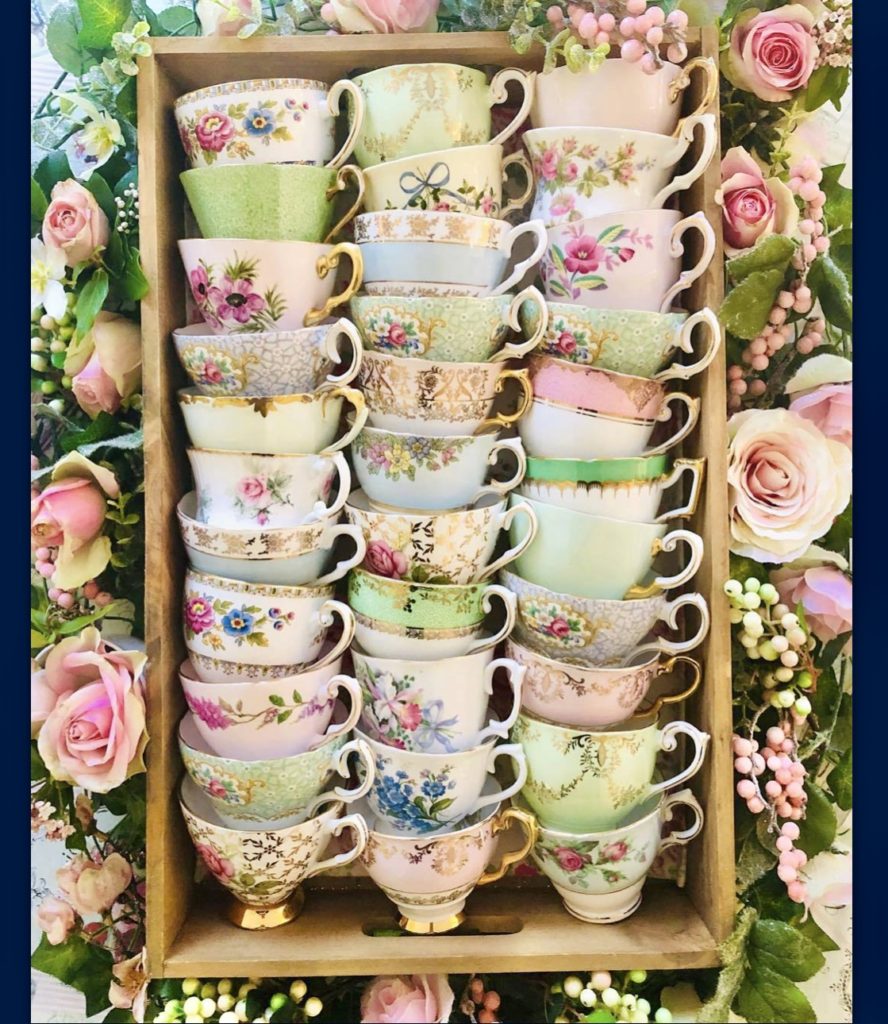
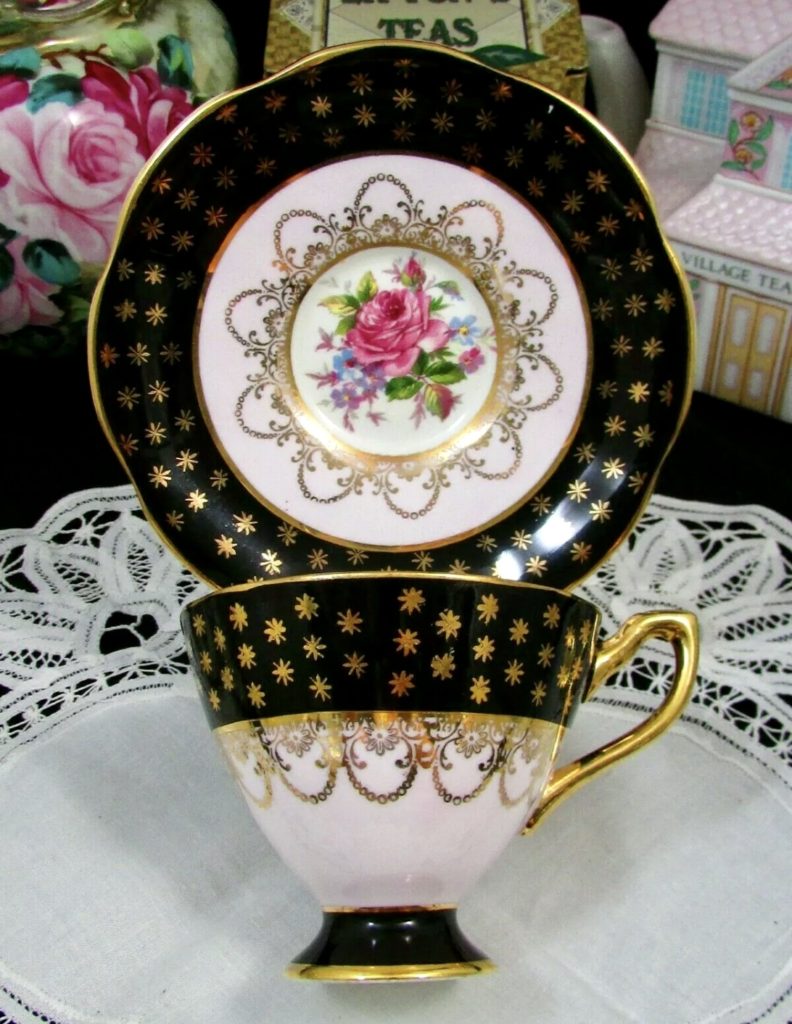
Lovely vintage Queen’s tea cup and saucer. People have been using and collecting tea cups for years and years. Because they are often beautiful as well as functional, vintage tea cups are a popular collectible. And while some rare and fancy tea cups can go for thousands of dollars, many vintage ones can be found for very reasonable prices.

Early tea cups were handleless and called tea bowls. These pretty blue and white porcelain bowls were exported from the Far East to Europe. In 1707, a German alchemist and inventor named Johann Friedrich Bottger designed the first European porcelain that could rival the Chinese porcelain. While handleless bowls are still traditional in many Asian countries, it is somewhat of a controversy as to why handles were added to British tea cups. Some opinions state that it was because the British liked their tea “piping” hot and didn’t want to burn their hands, and others indicate it was merely a design invention to improve on the often clumsy and messy tea bowls. Notwithstanding the reason for their invention, handles began to appear on many tea cups by the early 1800s.
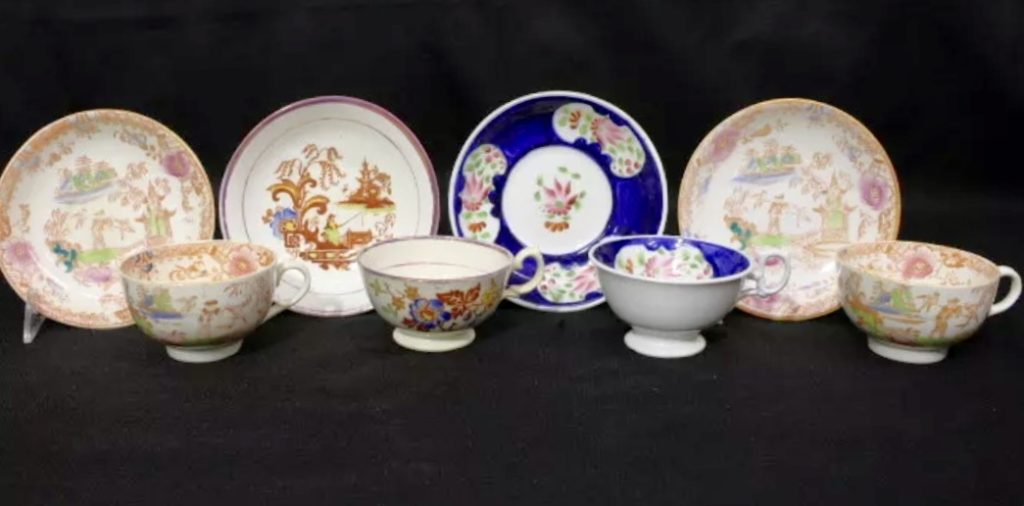
A variety of teacups and saucers from the mid-1800s. During the peak of the British Empire, from 1800-1830, elegant cup and saucer sets began to be produced to meet popular demand. Later, in the Victorian era, cups and saucers were often given as gifts by affluent ladies for various social occasions.

This vintage cup & saucer by Paragon was designed to be given to a bride. Writer Diana Cass relates the decorum for a “Teacup Bridal Shower” held for one of her relatives during the 1940s. “Each guest is to bring a wrapped teacup and saucer. Presented with them will be a word that represents the characteristics one should have to achieve a happy marriage. words like : patience, cooperation, music, unselfishness, humor, etc. The word should be tucked into the teacup and read aloud as the gift is opened.”

My small but growing tea cup collection. Most vintage tea cups are made from either porcelain or bone china and feature a flat or pedestal bottom. Beautiful designs were made well into the 1950s. The patterns and designs are myriad, and this is probably what makes collecting tea cups so enjoyable for many people. Whether you have received hand-me-downs from your Grandmother or found one at a local yard sale, vintage tea cups can be addicting.
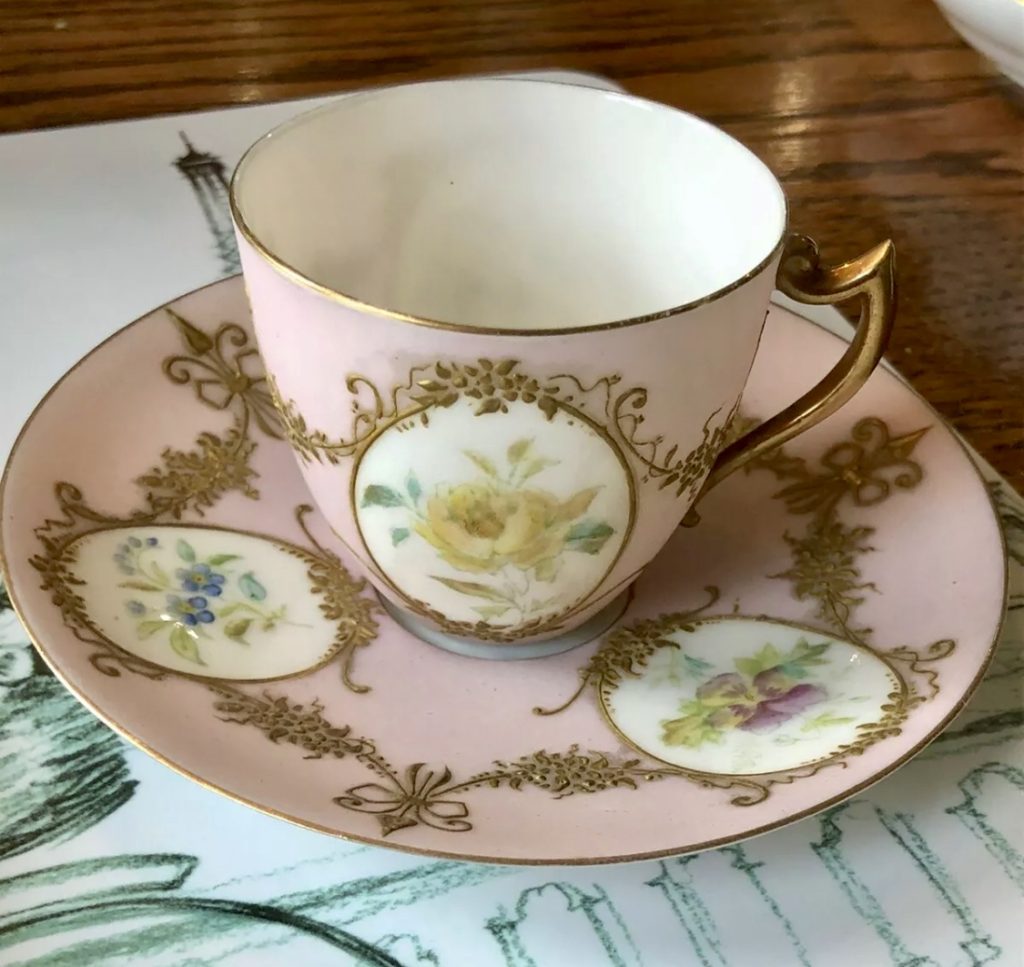
A demitasse cup and saucer. Some people enjoy collecting smaller sized demitasse cup and saucers. These diminutive cups almost appear child-sized, but are actually designed for espresso or coffee, often after a meal. Demitasse is a French word meaning literally “half-cup”.
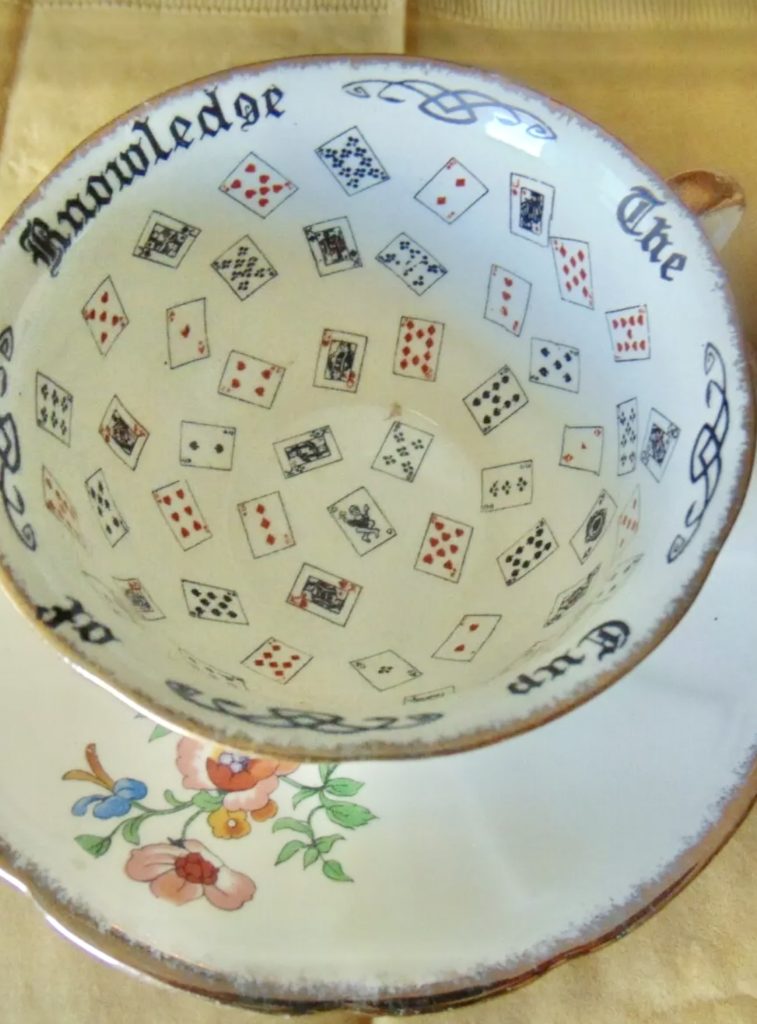
A vintage fortune-telling tea cup and saucer. There are a variety of novelty vintage tea cups. Some were made for fortune telling, which involves reading the patterns created by tea leaves once a cup has been emptied by a tea drinker and making predictions. Sometimes these even included special instructions. Other novelty tea cups celebrate specific events, such as coronations, or feature months of the year with corresponding flowers.
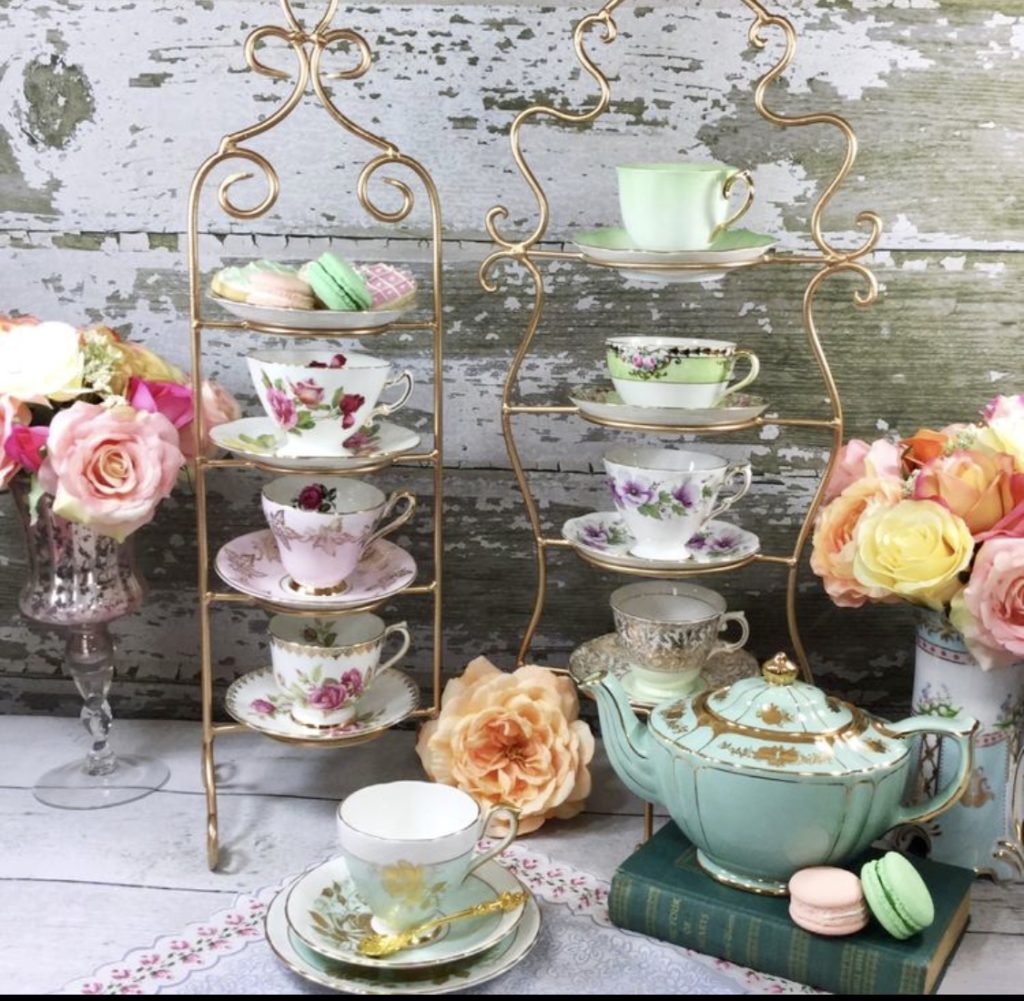
Some people like to collect only specific colors or shapes, or they prefer tea cups from a specific country, maker, or time period. English and French made tea cups seem to be the most interesting to me, but you can also find beautiful vintage ones from Japan, China, Germany, and other countries as well. Some of the most popular manufacturers are Paragon, Limoges, Royal Albert, Aynsley, Shelley, Royal Doulton, and Royal Worcester.

This vintage tea cup made by Paragon features a flower handle. You can find vintage tea cups at thrift stores, rummage sales, antique shops, flea markets and antique shows or online at places such as eBay and Etsy. For more information, see The Story of Tea: A Cultural History and Drinking Guide, by Mary Lou and Robert J. Heiss or check out Teacups 101. You may also enjoy my post The Tuck Box: A Fairy Tale Tea Room in Carmel-by-the-Sea.
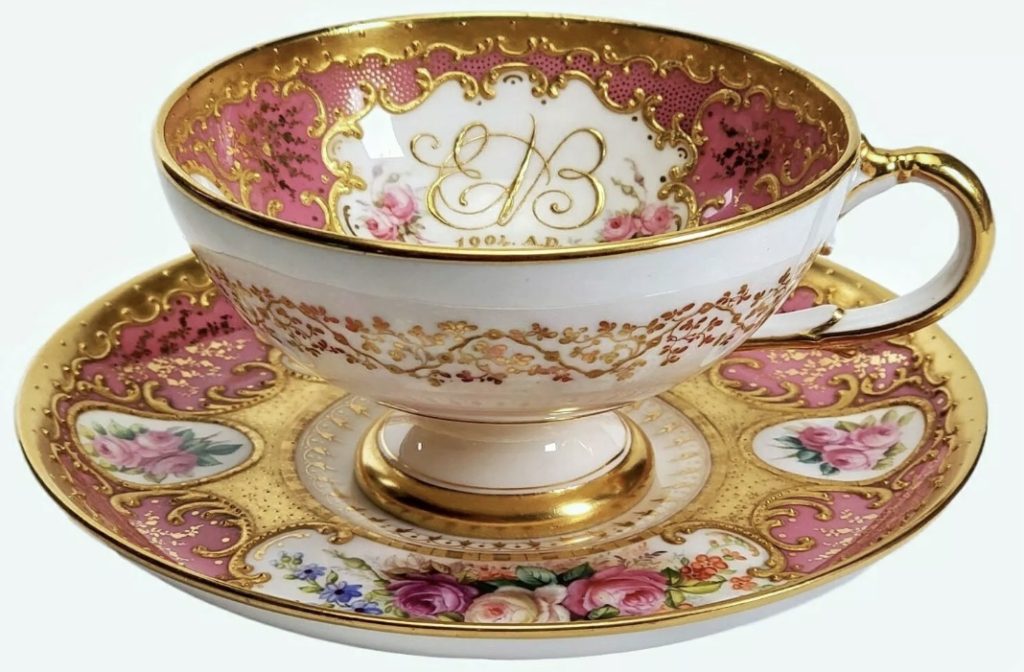
This very fancy hand painted tea cup and saucer was made by Royal Worcester in 1904. Thank you for visiting my blog. Wishing you peace, love, happiness, and beautiful vistas!
-
The History of Romantic Dovecotes
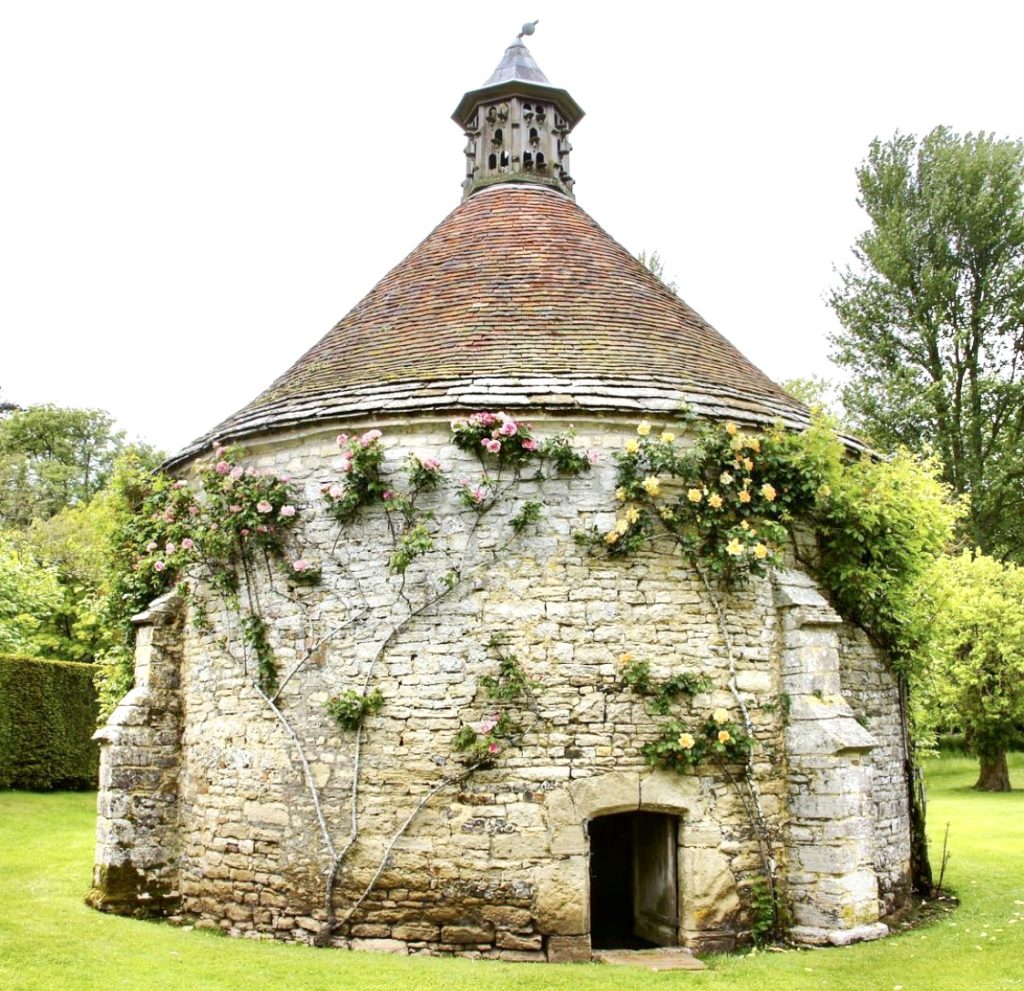
Very old dovecote at Athelhampton House & Gardens in Dorchester, England. Dovecotes have always seemed very romantic to me. My first exposure to the concept of dovecotes was when I read Louisa May Alcott’s Little Women. In the novel, the eldest of four sisters, Meg March, becomes engaged. Her fiancé, John Brooke, builds a tiny cottage for them to live in once they are married. The March’s dear neighbor Laurie christens it the “Dovecote”, insisting that “it was highly appropriate to the gentle lovers who went on together like a pair of turtledoves”.
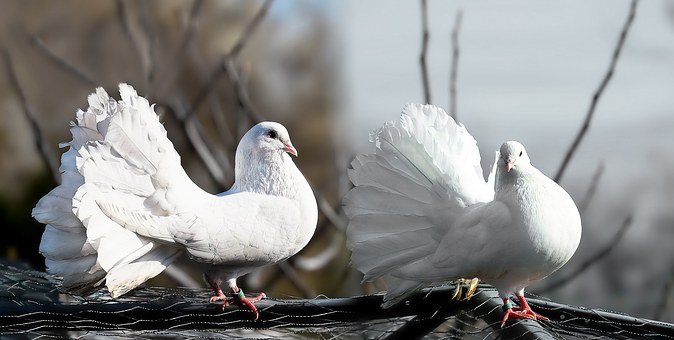
Unfortunately, my romantic notion of dovecotes burst when I did more research. Apparently, most dovecotes were used to house blue rock pigeons, an important food staple. This practice skyrocketed during medieval times. According to Peter and Jean Hansell in their book Dovecotes, “the cost of the birds’ upkeep was negligible because they foraged far and wide…and needed supplementary feeding only when snow was on the ground”. In addition, the Hansells relate that pigeons are highly prolific and “an unfailing supply of squabs could be relied upon” for meals. Pigeons were also kept for their eggs, droppings, and feathers. Pigeon droppings were used for leather tanning and making gunpowder. Their feathers were used for pillows and feather beds. Pigeons also often served medicinal purposes, however, I will refrain from relating the details as it is a bit gruesome.
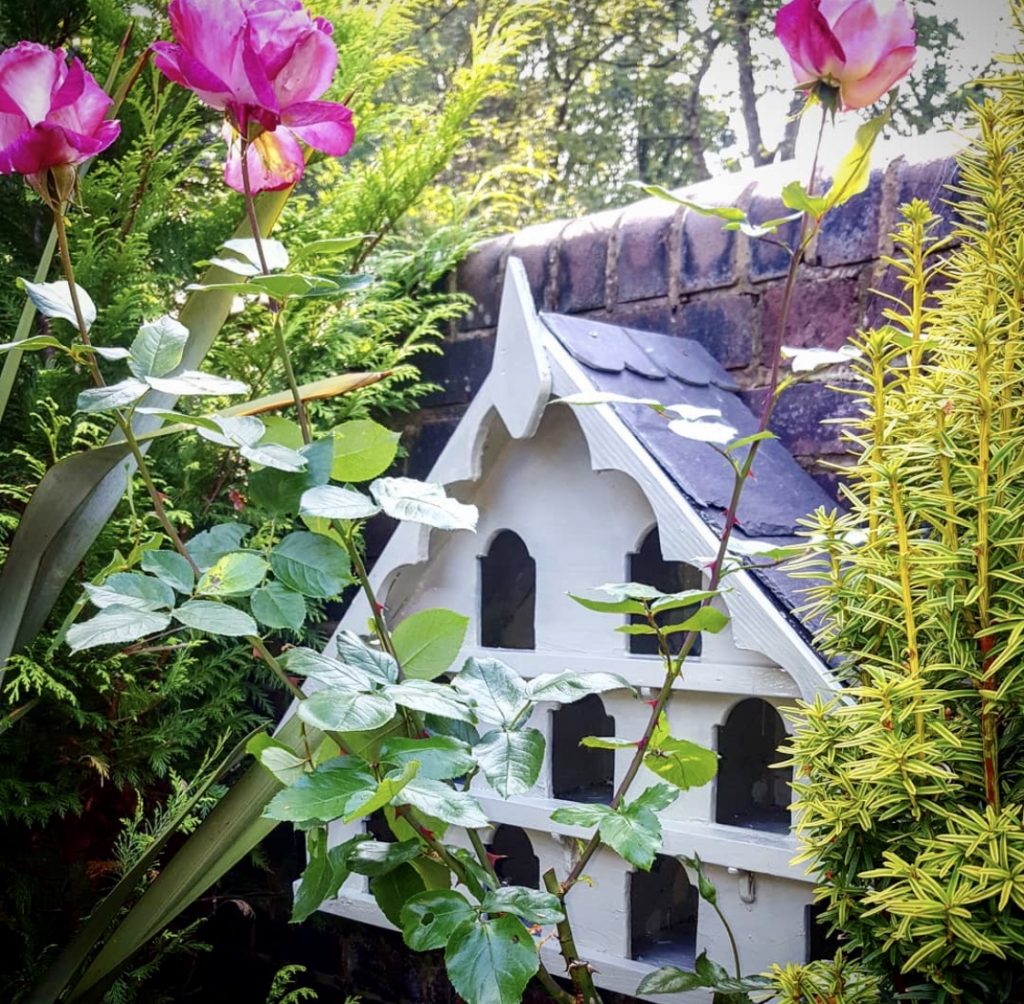
Photo courtesy of @xsharon.s I am happy to report that these once common practices have all but died out today, although certainly not entirely. And just like those biblical heroes of old, the dovecote dwelling blue rock pigeons have left numerous descendants. They begat and begat and begat. Those descendants include both feral pigeons inhabiting cities and parks and the pretty white doves often portrayed carrying olive branches, hence both “dove” and “pigeon” are used interchangeably. Did you know that another word for dovecote is pigeonaire? I prefer dovecote, pigeonaire sounds somewhat like an old appliance to me.

Dovecotes were built in many styles, including circular, square and rectangular, and octagonal. Per the Hansells, early dovecotes were generally made of mud, clay, straw, wattle and daub, limestone, sandstone, flint, chalk, timber framing, weatherboarding, granite, and slate, and later dovecotes were made of brick and stone. While early structures were free-standing and limited to very wealthy people such as lords with manors or castles, or large monasteries, later dovecotes were often much smaller and built into the side of homes and barns.
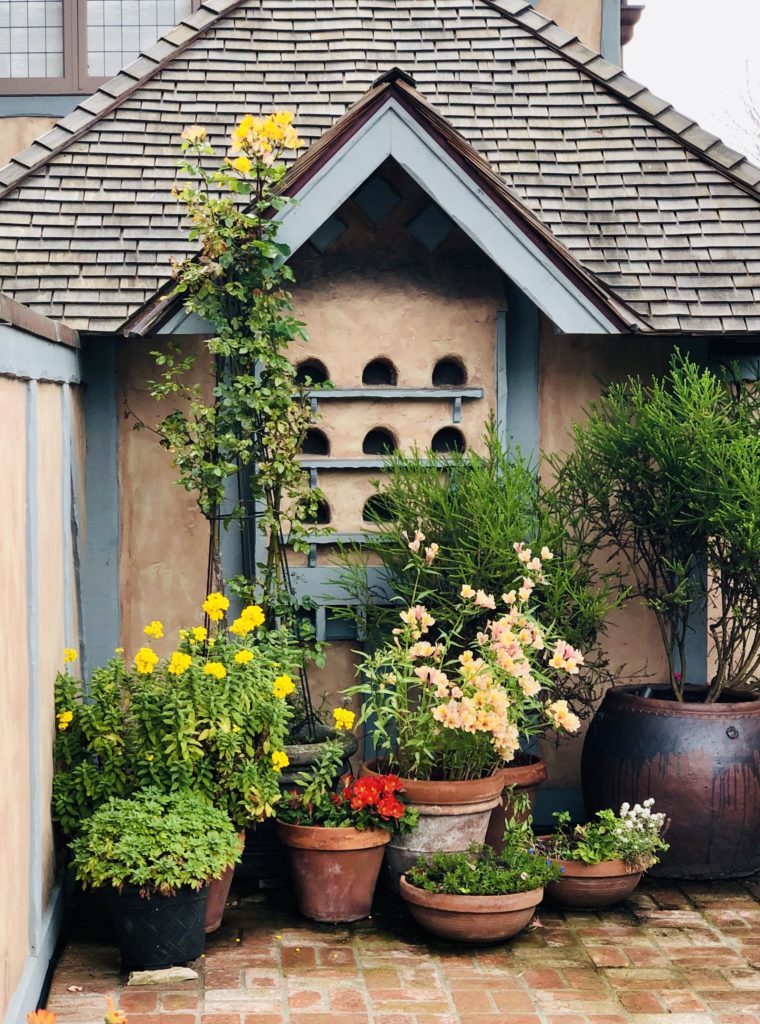
Dovecote in Carmel-by-the-Sea. While the history of dovecotes was not necessarily what I had envisioned, I still find these structures enchanting. I also find it endearing that people are still using dovecotes today to provide shelter for our feathered friends.
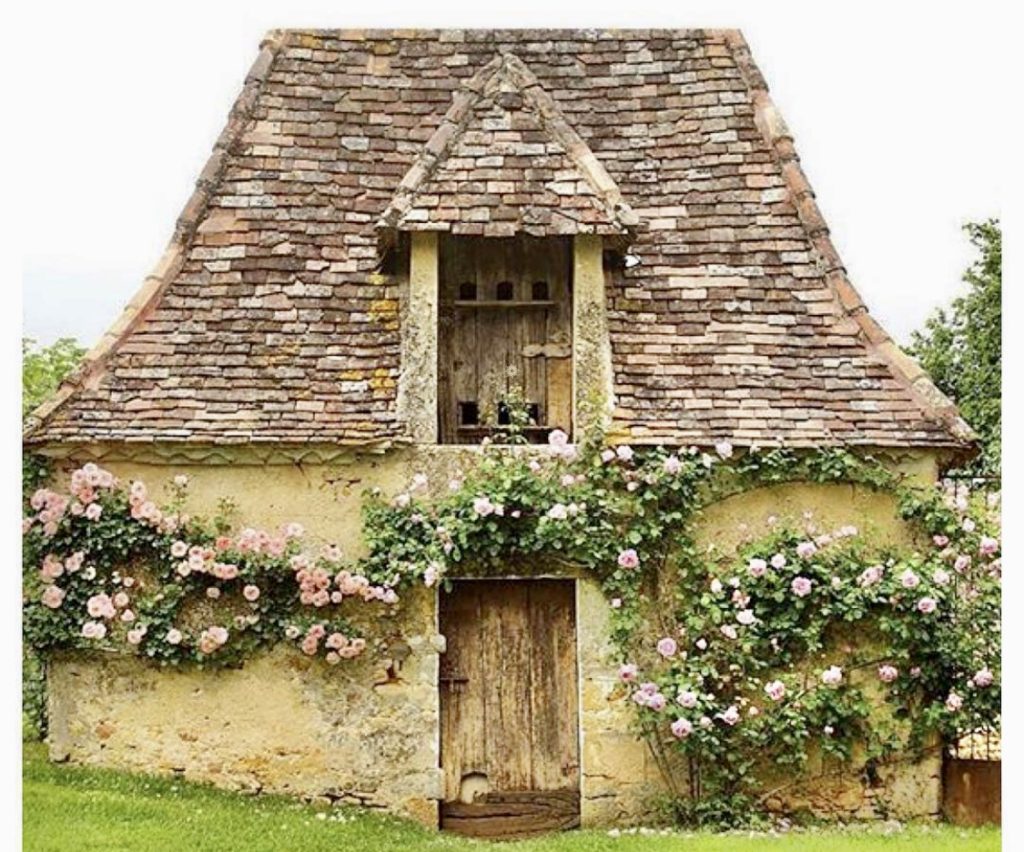
French dovecote photo courtesy of @serendipity_loves For more information on dovecotes, see the following by Peter and Jean Hansel: Dovecotes, Doves and Dovecotes, and A Dovecote Heritage or visit Pigeon Cote. You may also enjoy my post Add Charm to your Garden with Beautiful Birdhouses!
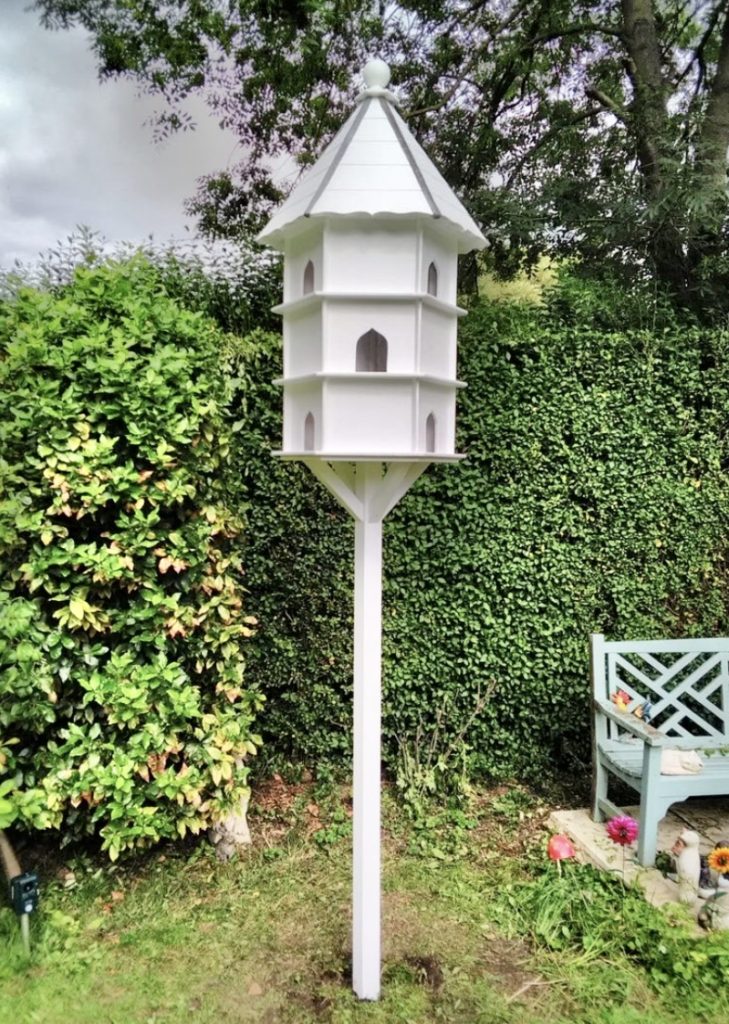
Hand-made Bespoke dovecote available on Etsy.com Thank you for visiting my blog! Wishing you peace, love, happiness, and beautiful vistas.
-
The Charm of Antique Watering Cans

I love antique watering cans. Both functional and charming, they have been in use for hundreds of years to water plants and flowers. Before the watering can we know today, buckets and earthenware watering pots were used. These were cumbersome and often very heavy, especially after being filled with water! We have it pretty easy today with our 100 foot long garden hoses and adjustable spray nozzles. These people would likely call us gardening sissies!

Early French copper watering can. 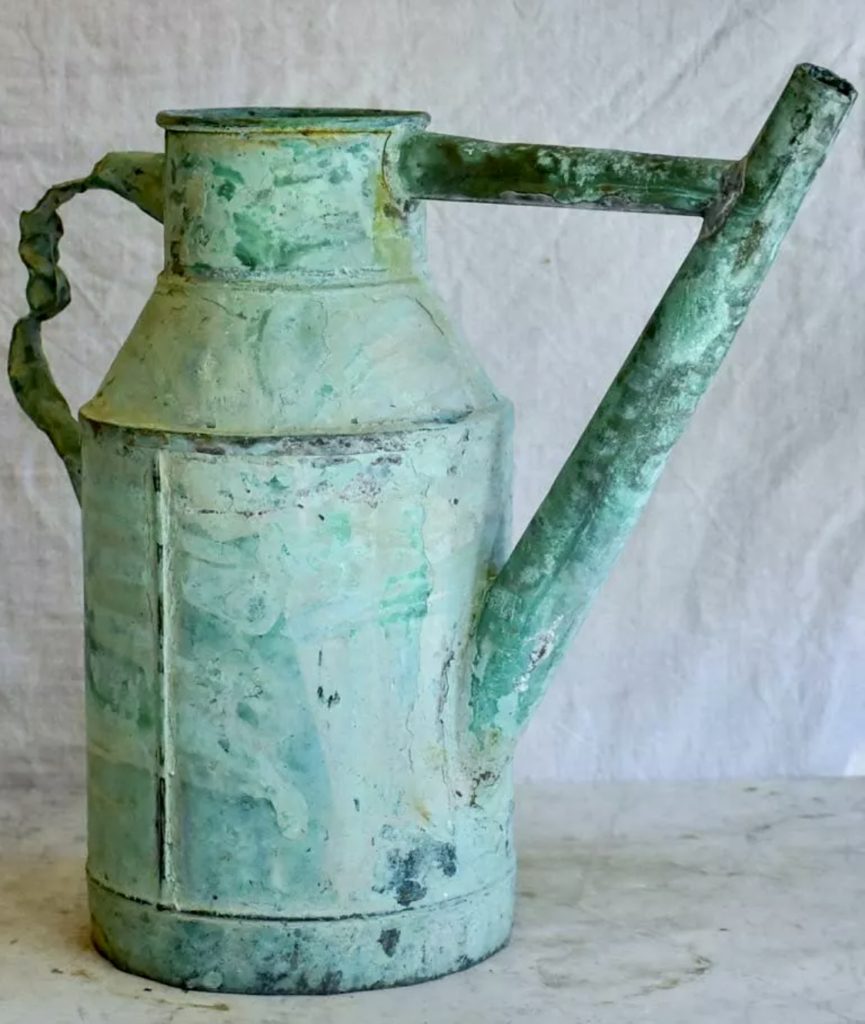
Another early French copper watering can with a distinctive blue patina. The humble watering can has undergone many changes. In the late 1600s, watering cans began to be constructed of copper. Then, during the mid-1800s, they were also produced in brass and zinc. Antique French watering cans of yore often resembled large pitchers, often with graceful and elegant handles. American watering cans tended to be larger and bulkier.
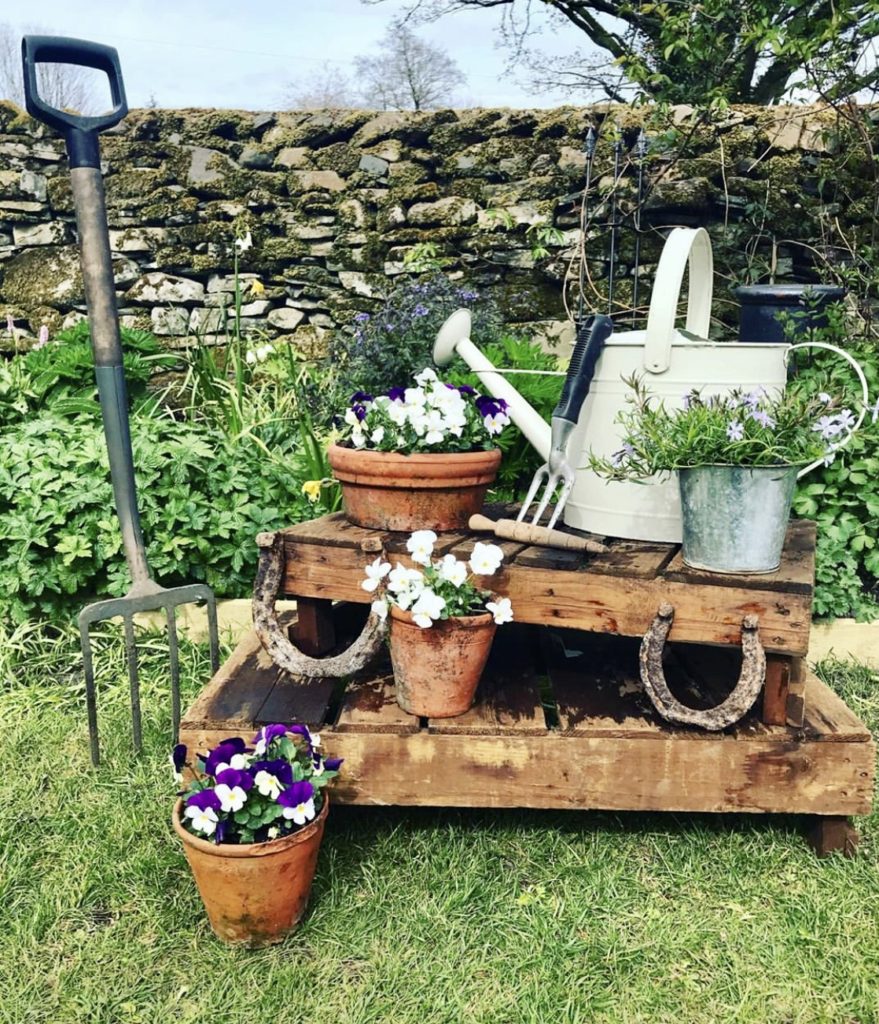
Photo courtesy of @lane.end.cottage 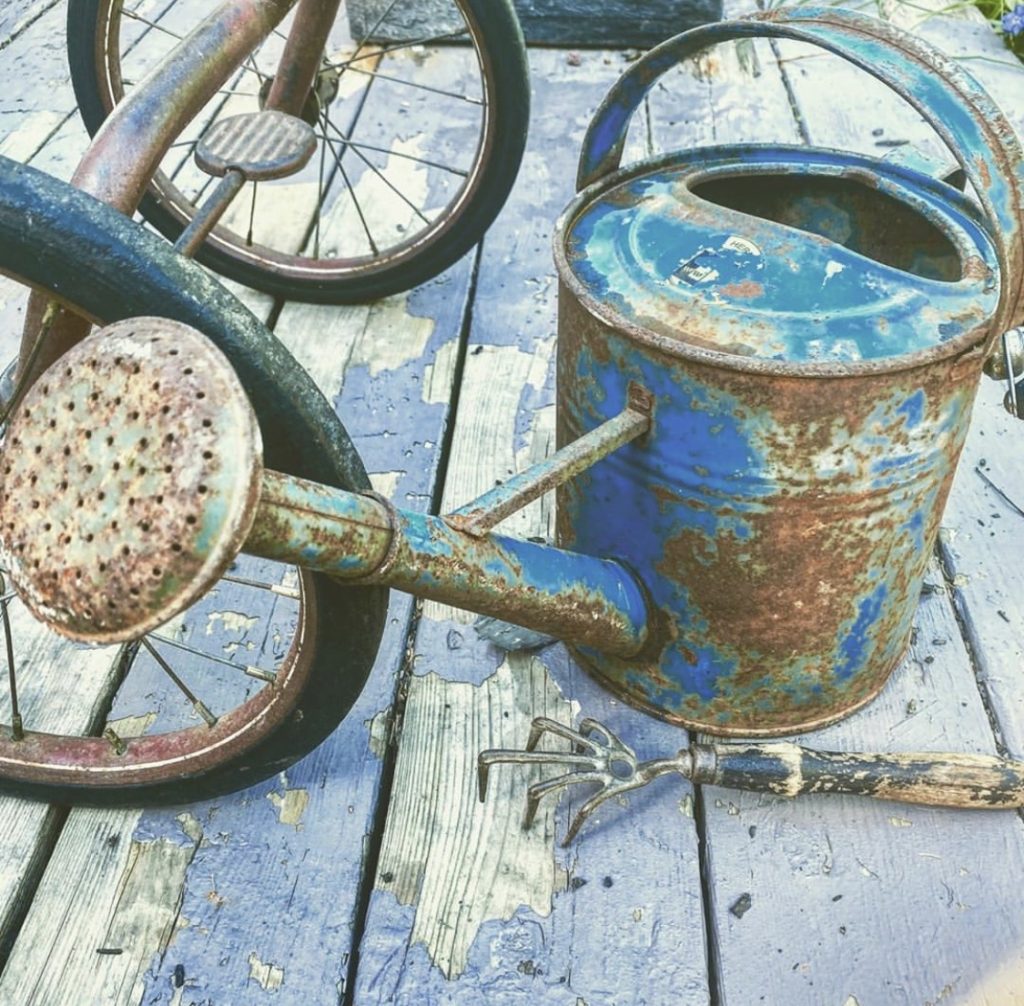
Gardening became extremely popular during the Victorian era. Due to a craze for ornamental gardens and greenhouses, the need grew for better watering cans. In 1886 the Haws Company came to the rescue. This English business revolutionized the humble watering can by creating a longer spout and two handles: one on the top for carrying, and one on the back for tipping and pouring. The Haws watering can remains a classic today.
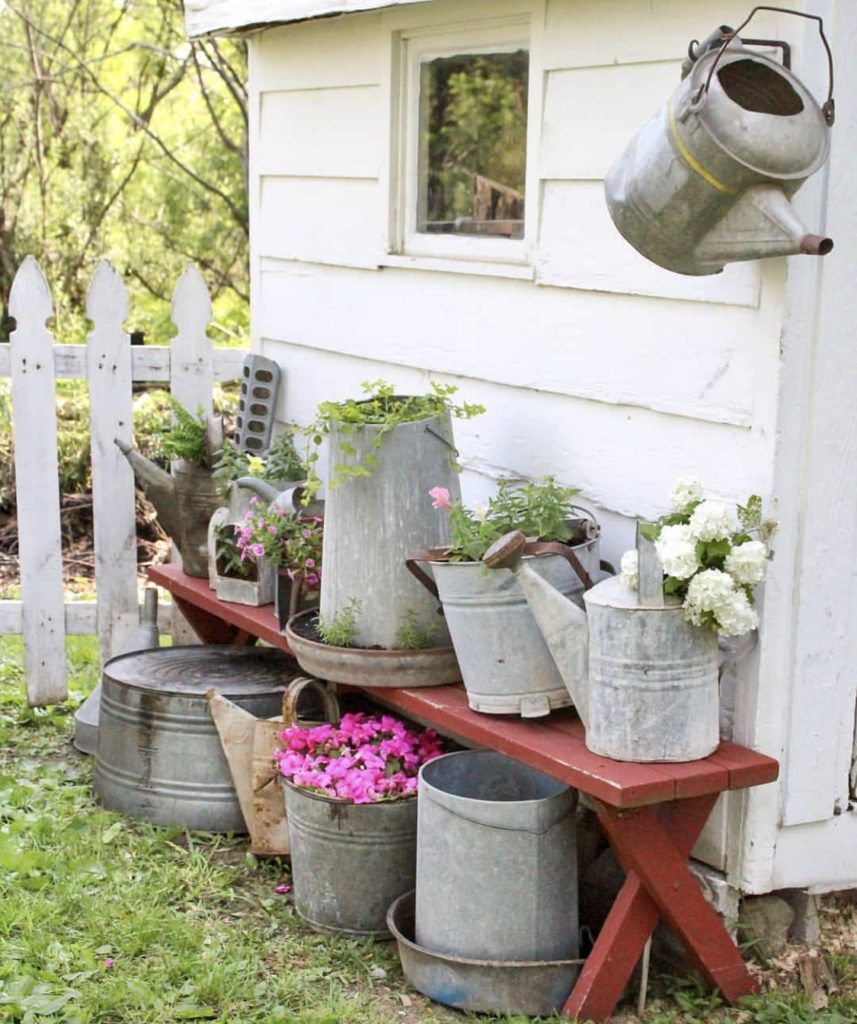
Photo courtesy of @countryfirsts 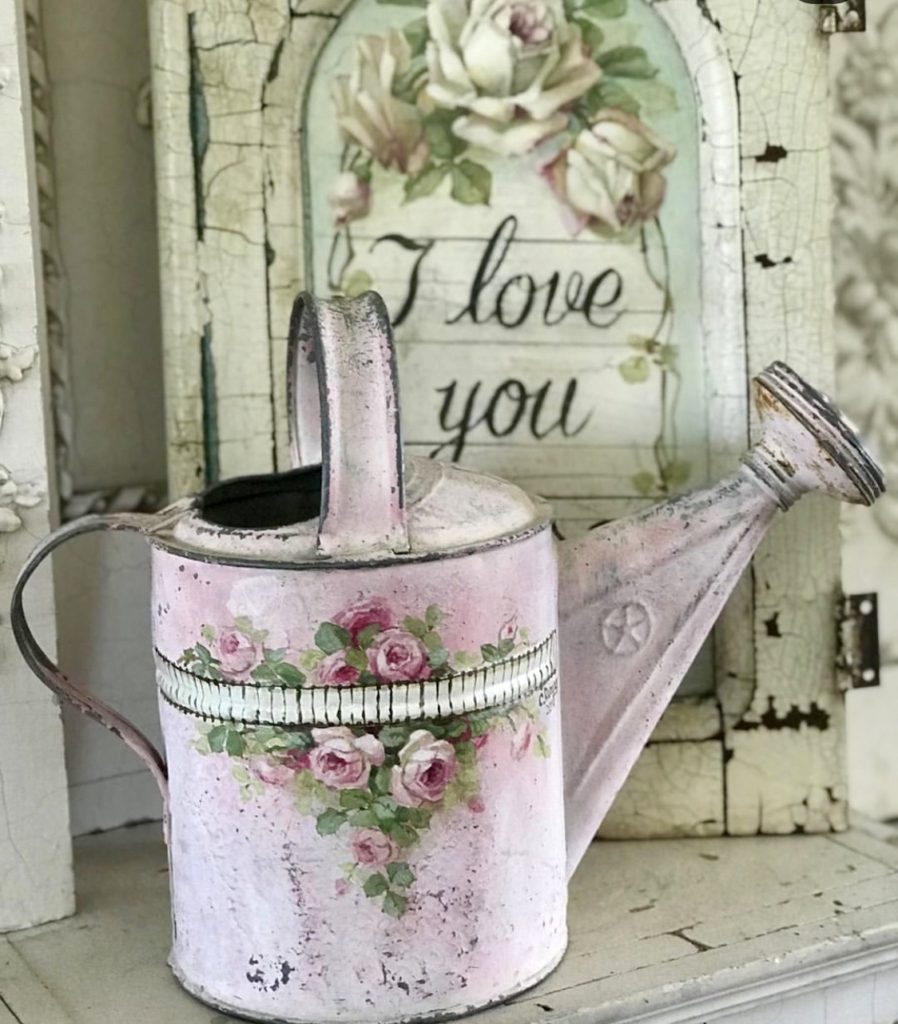
Photo courtesy of @shabbytownusa11 Another addition to watering cans was the use of a detachable sprinkling “rose” on the tip of the spout. It enabled the control of water flow, creating a gentle trickling of water from a multitude of tiny holes, versus a heavy torrent. Its name is derived from the French word “arroseur”, meaning sprinkler.
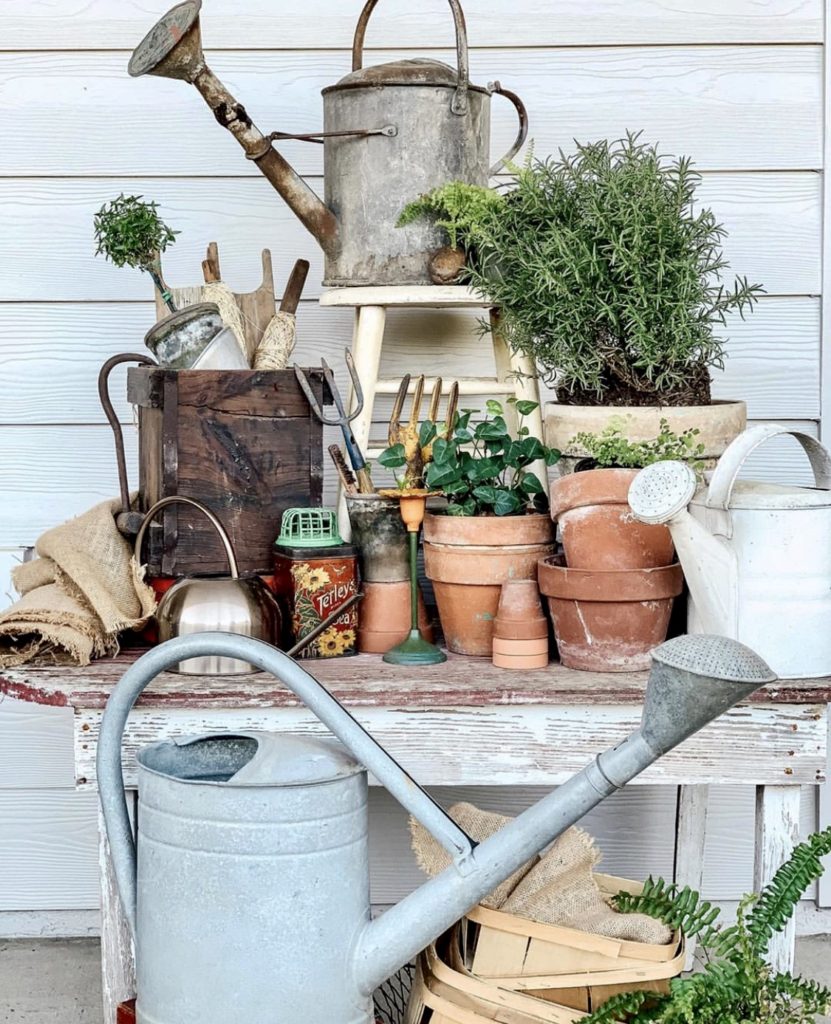
Photo courtesy of @weatheredwaresandco Galvanized metal watering cans became plentiful in the early 1900s. These are the most common antique watering cans found today.
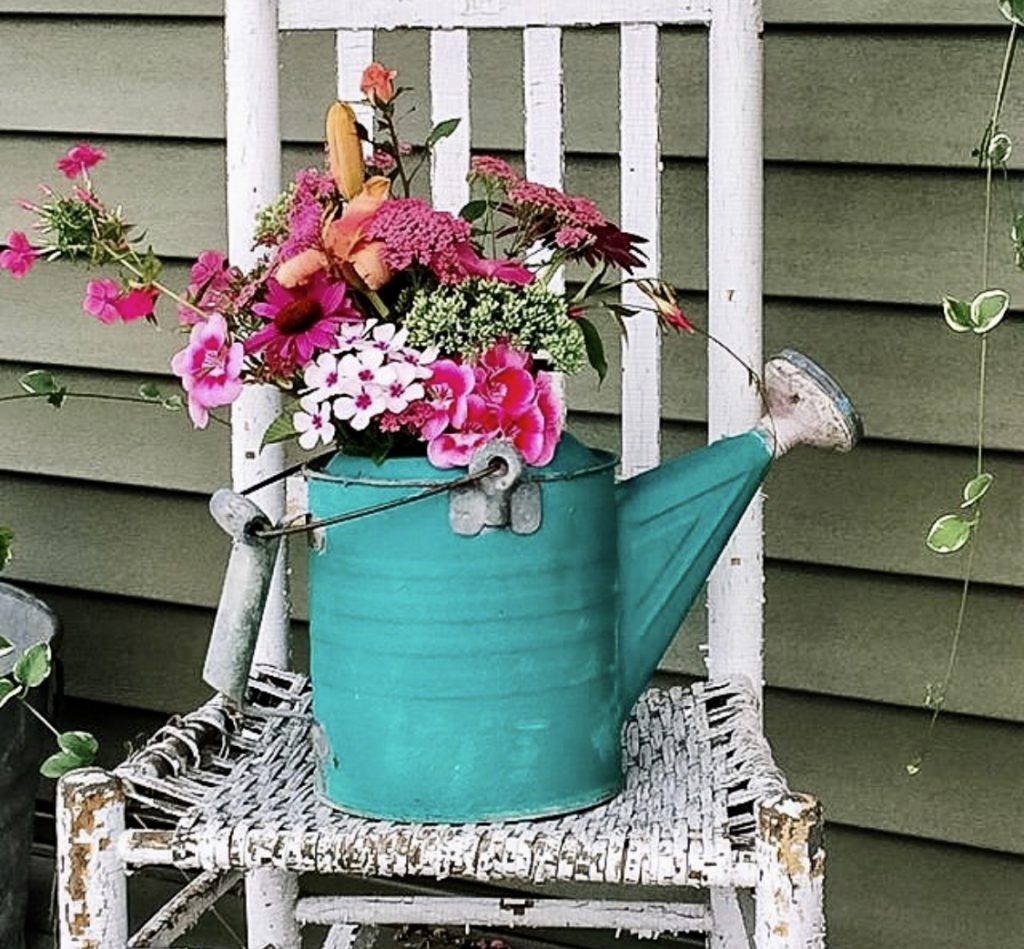
Photo courtesy of @tinyvintagefarmhouse While early antique watering cans often sell for hundreds of dollars, later models can often be found for a more reasonable price at yard sales, flea markets and online sites such as eBay and Etsy. These may have dings and dents, but that is what adds character!
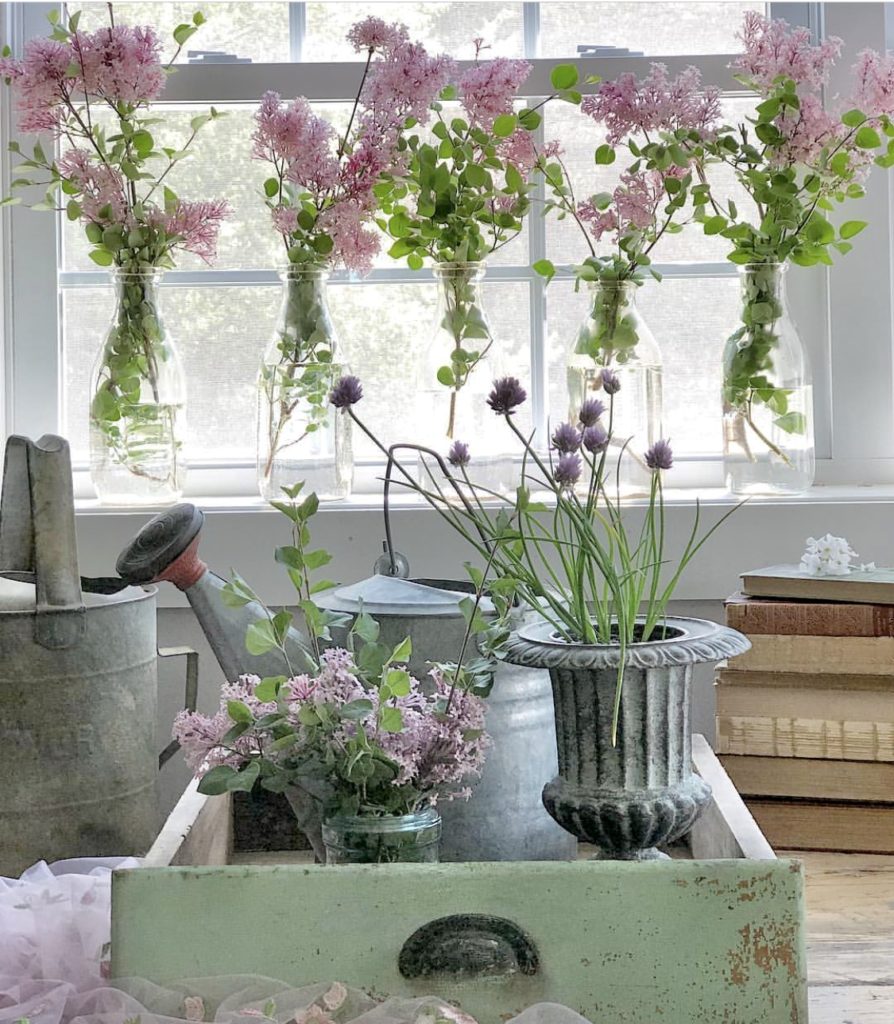
Photo courtesy of @rachelsgarden_artbyamy Even if you don’t have a green thumb, you can create charming vignettes using watering cans. Whether painted, filled with flowers, or hung on hooks, they can add warmth and a one-of-a-kind vibe.
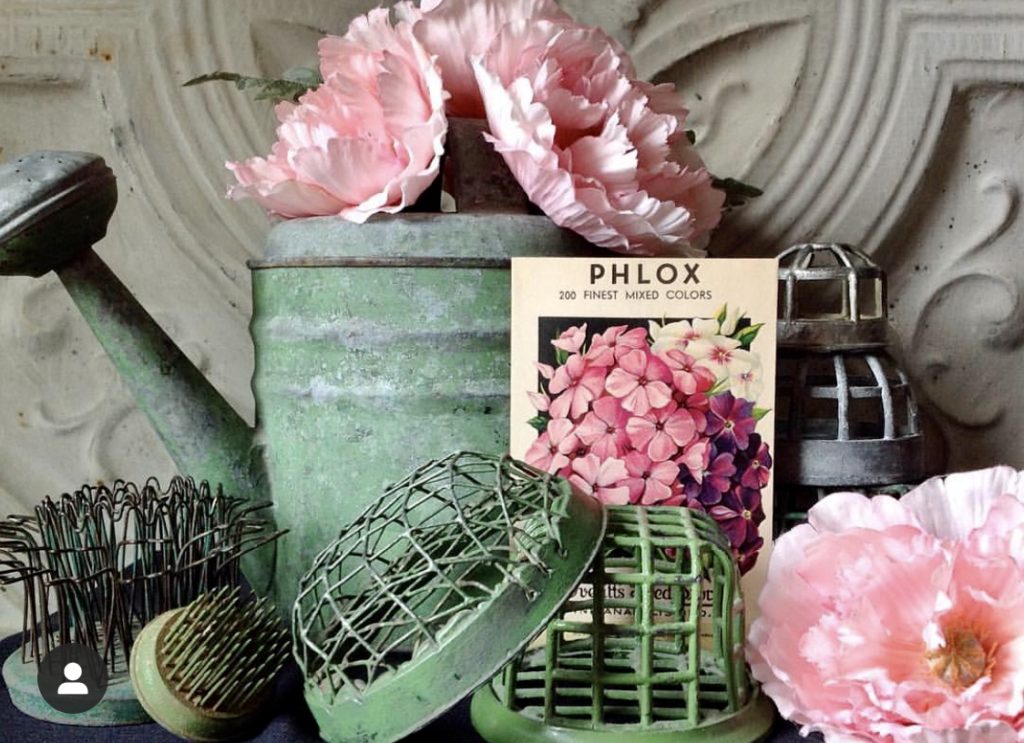
Photo courtesy of @brocante_victoria Some folks like to collect different sizes or styles and group them together.
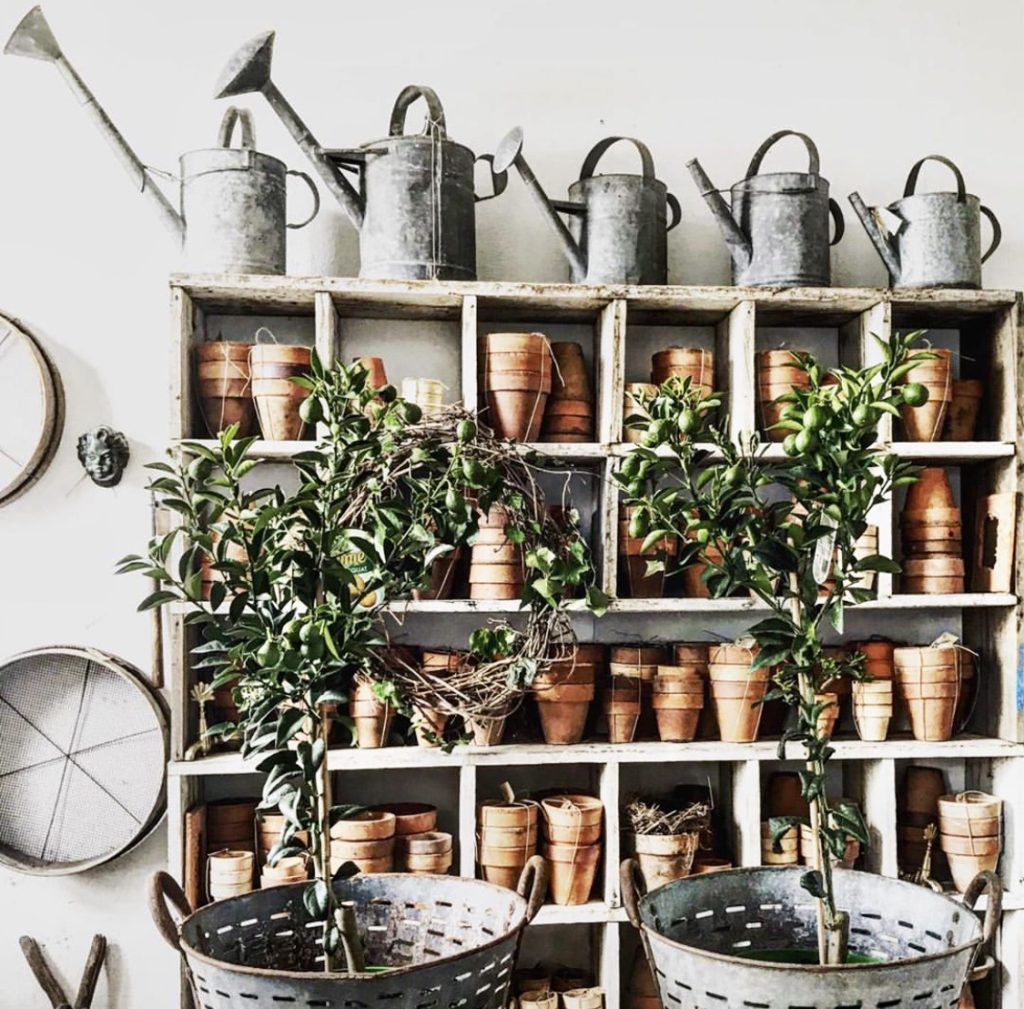
Photo courtesy of @vintage.216 You can change your watering can decor along with the seasons. Your imagination is the limit!

Photo courtesy of @weatheredwaresandco I hope you enjoyed this post and gained some watering can inspiration! For more information, see Antique Watering Cans, Antiques From The Garden, by Alistair Morris, and Garden Tools by Suaznne Slesin, Guillaume Pellerin, and Stafford Cliff. You may also enjoy some of my other gardening posts, including Have a Seat: Garden Bench Inspiration, Add Charm to your Garden with Beautiful Birdhouses!, and The Secret Gardens of Historic Monterey
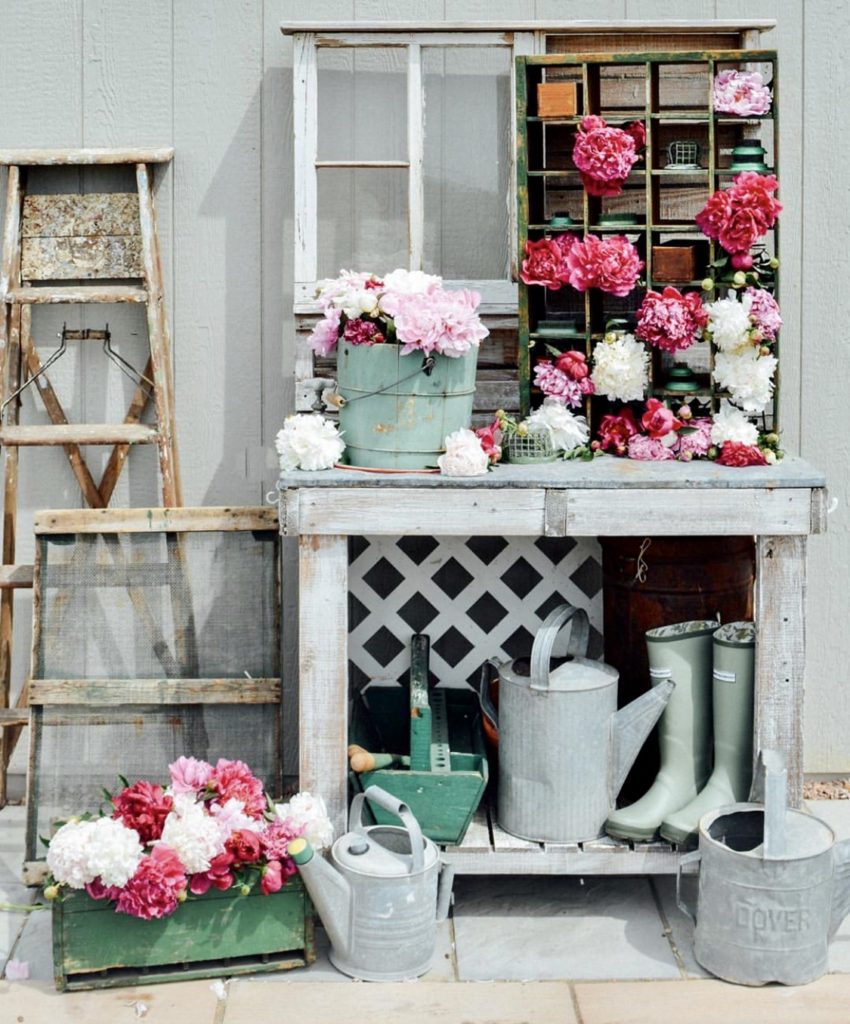
Photo courtesy of @thevettelfarm 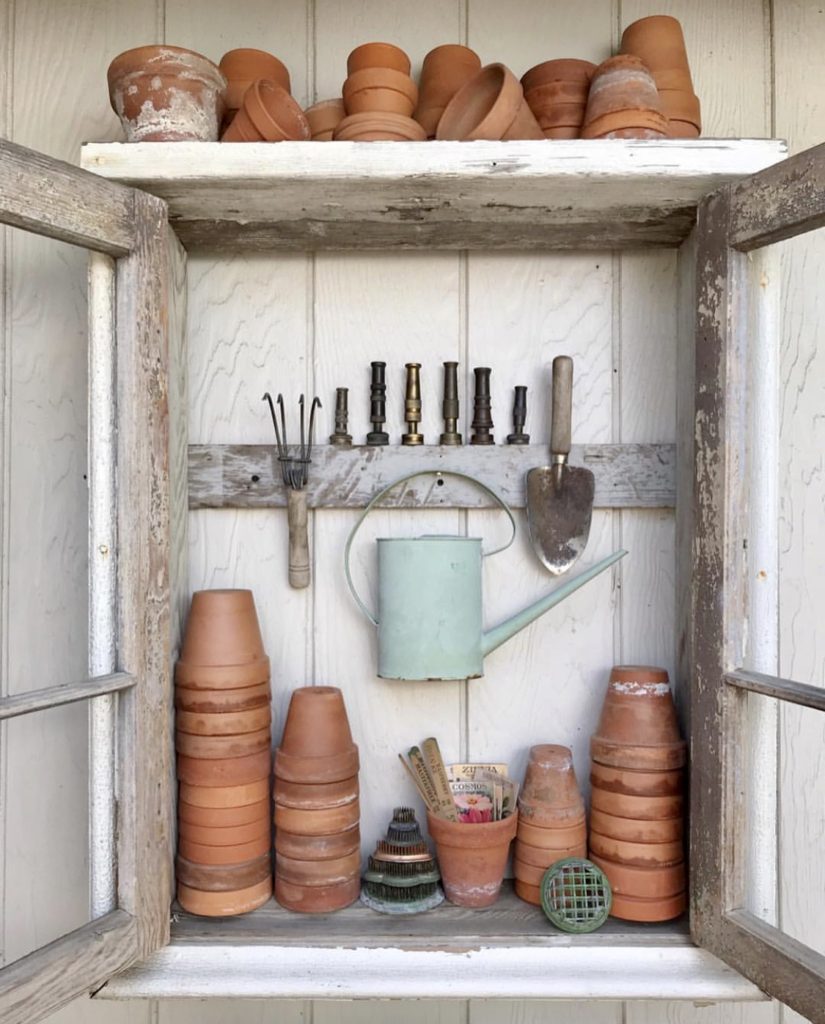
Photo courtesy of @toile_de_jute Wishing you peace, love, happiness and beautiful vistas!
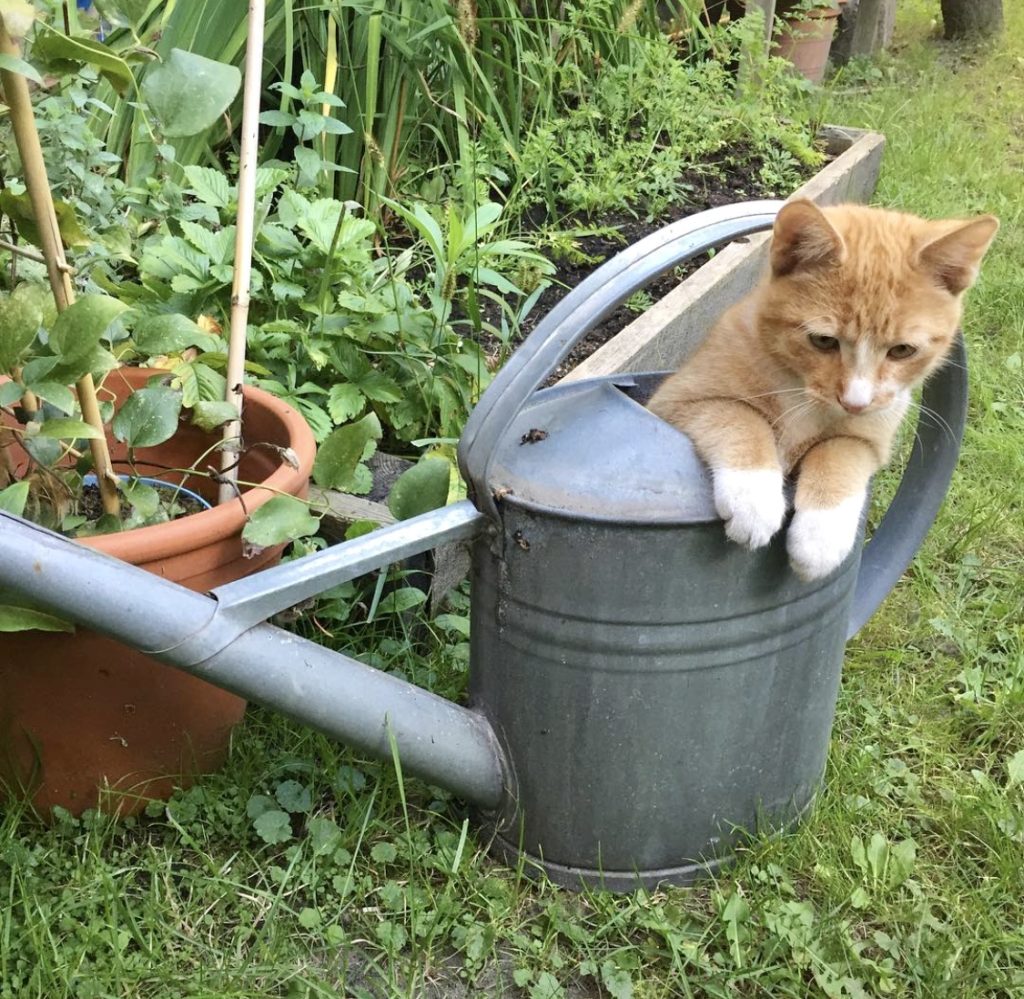
Photo courtesy of gosia_kozlowska -
Have a Seat: Garden Bench Inspiration
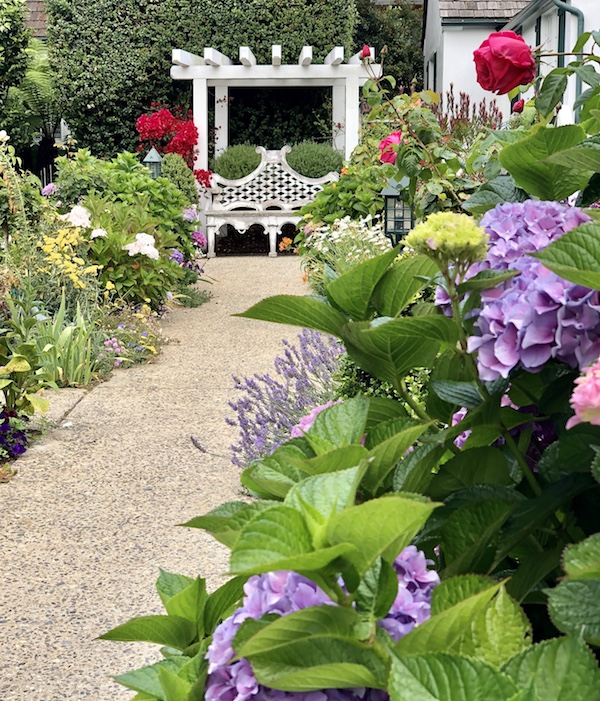
A lovely bench topped by a pergola at Lincoln Green Inn in Carmel-by-the-Sea. Benches are the perfect accessory for any garden. They offer a place to relax, enjoy the flowers, dream, read, and watch the birds & butterflies. There is nothing better than having a comfy garden bench on which to rest after a hard day’s gardening. They can also add style, grace, and character to your outdoor space.
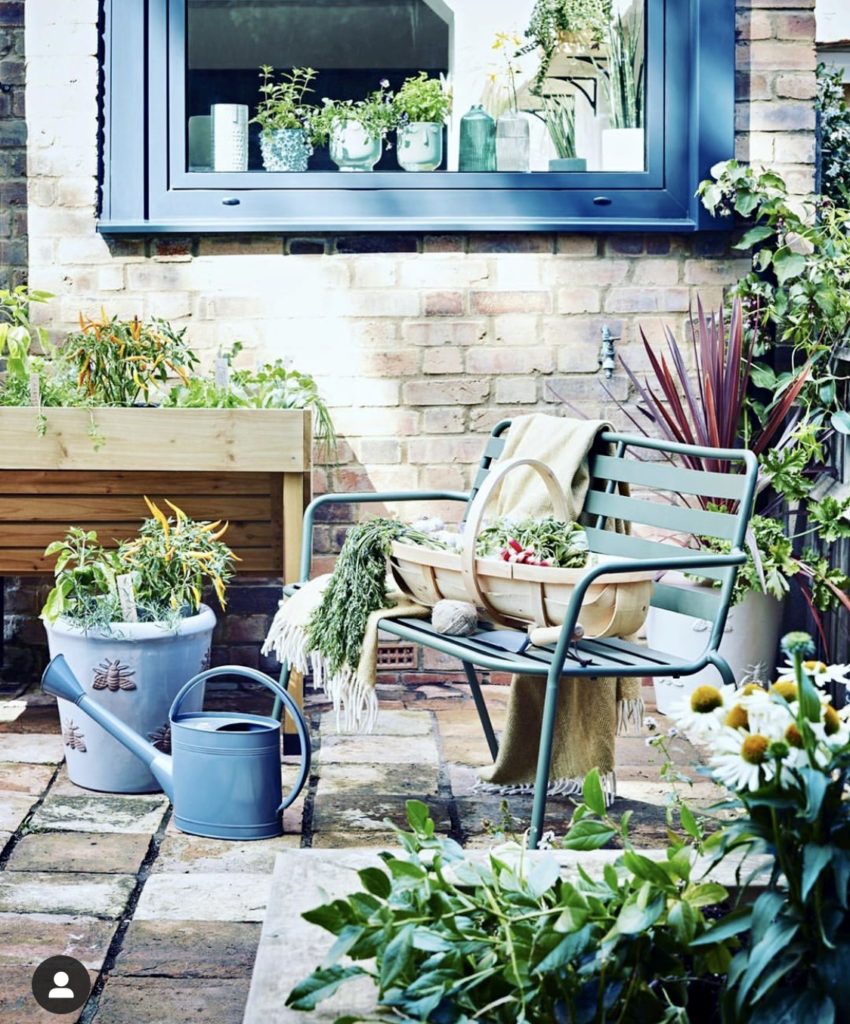
Photo courtesy of @selinalake Garden benches come in a wide variety of materials, the most common are wood, metal, concrete and stone.
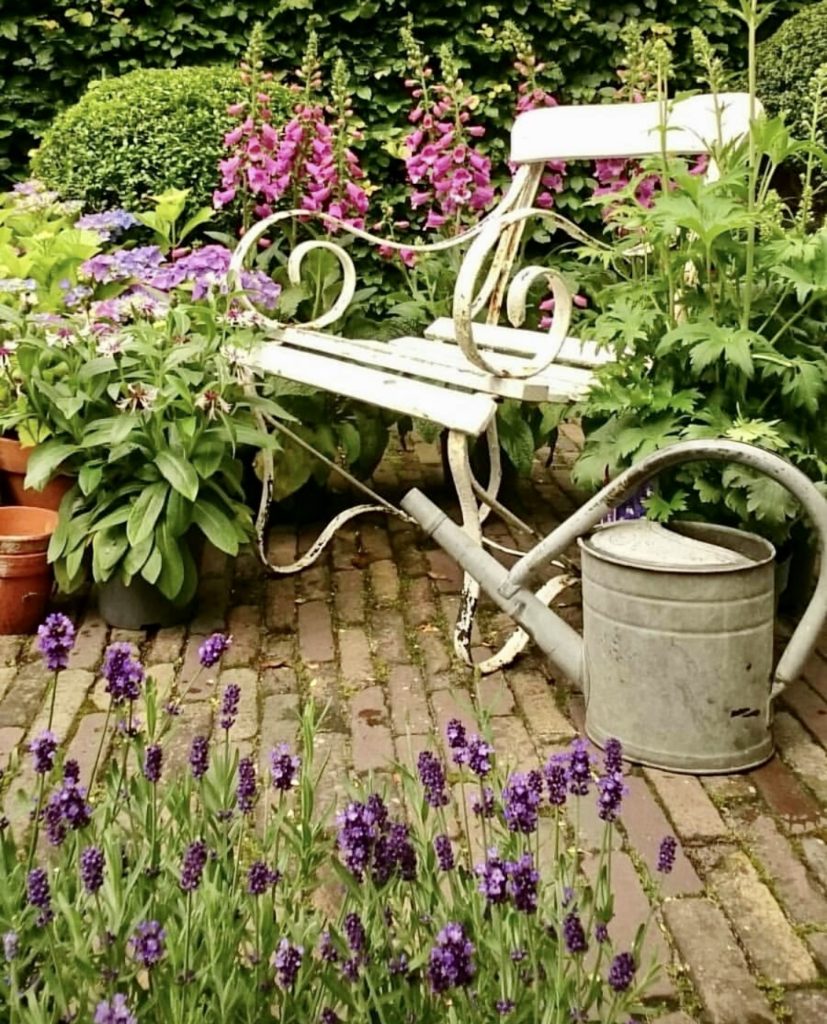
Photo courtesy of @country.chique Natural wood is one of the most common materials used in garden benches. While it can be susceptible to weather damage and pests, it is easily protected with paint, oil or varnish. In colder climates, covering it over the winter will also help improve its lifespan. Regular cleaning of wood benches is also important to help preserve them. For more information see protecting wood benches.
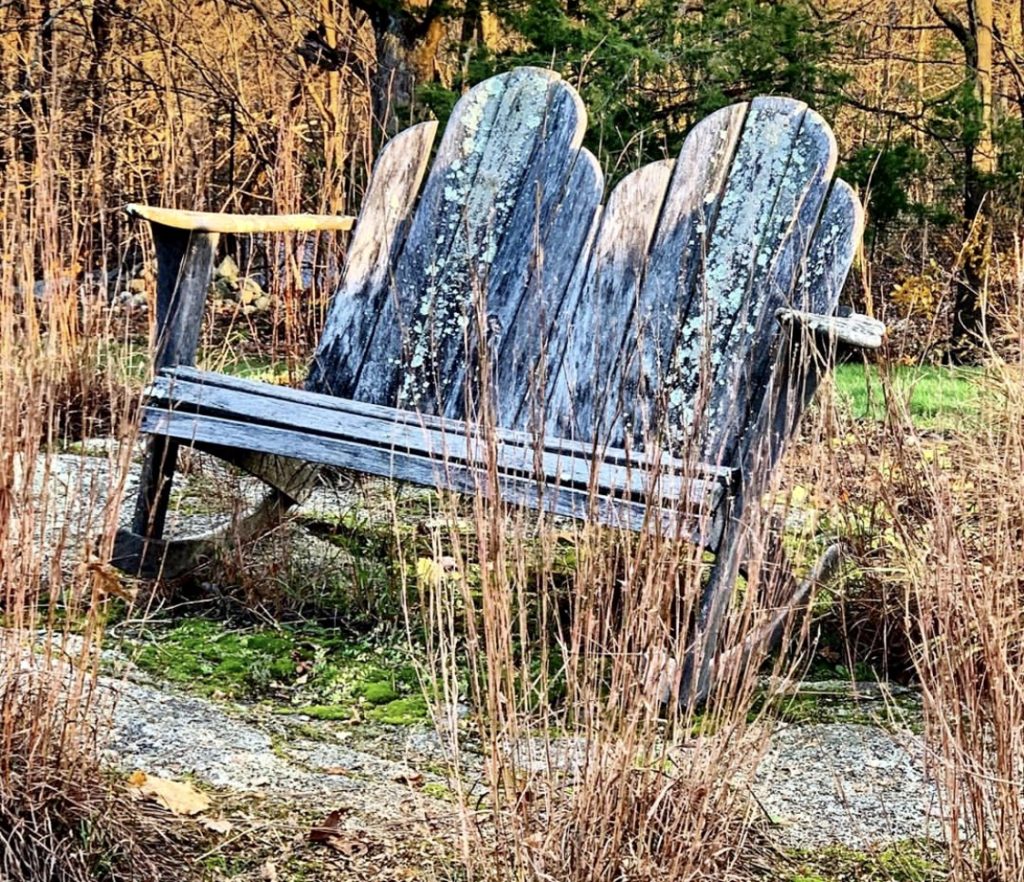
For those who like the look of weathered wood, you can forgo maintenance and let nature take its course. Photo courtesy of @pixieperennials 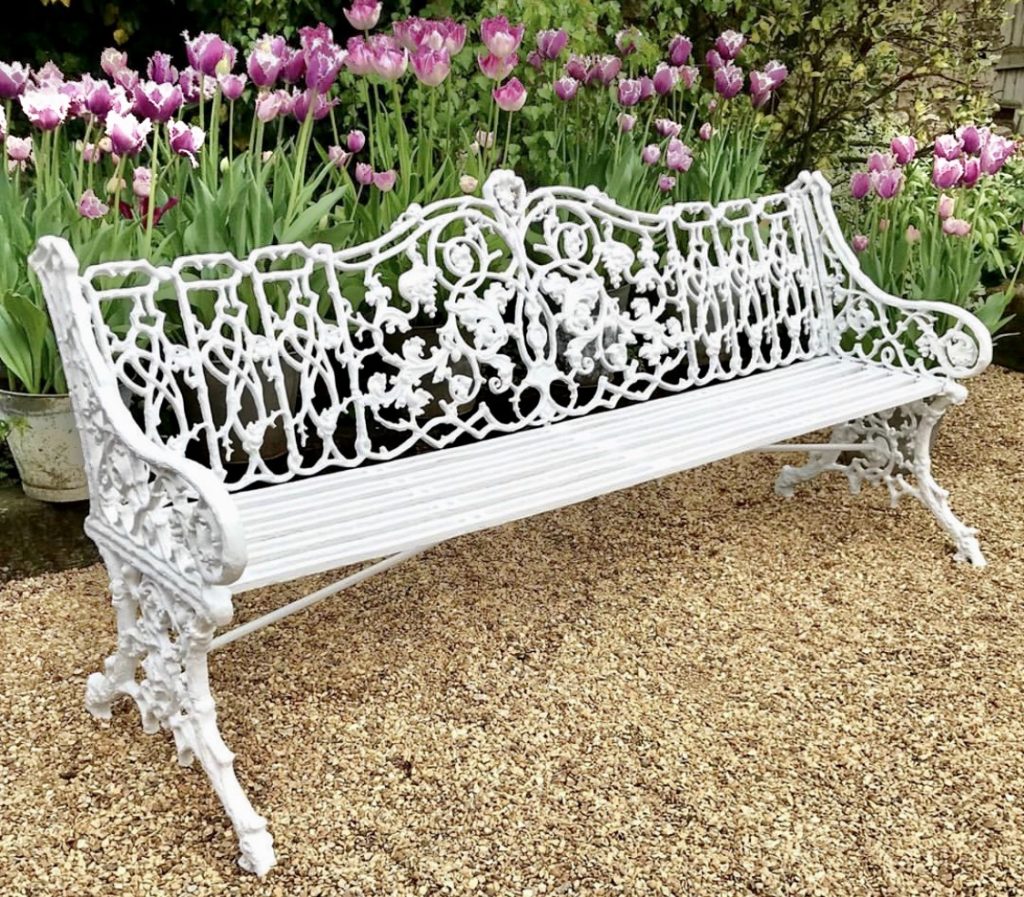
Photo courtesy of @thompsonsgardenemporium Metal benches are often made of steel, cast iron, or aluminum. Metal benches are often fantastically ornate. Many vintage and antique benches are metal. Metal benches require paint and protective sealants to prevent rusting. Like wood benches, they also require regular cleaning to remove accumulated dirt and grime that may deteriorate the finish. They also require covering or storing indoors in colder climates during the winter season. For more information on protecting metal benches, see protecting metal benches
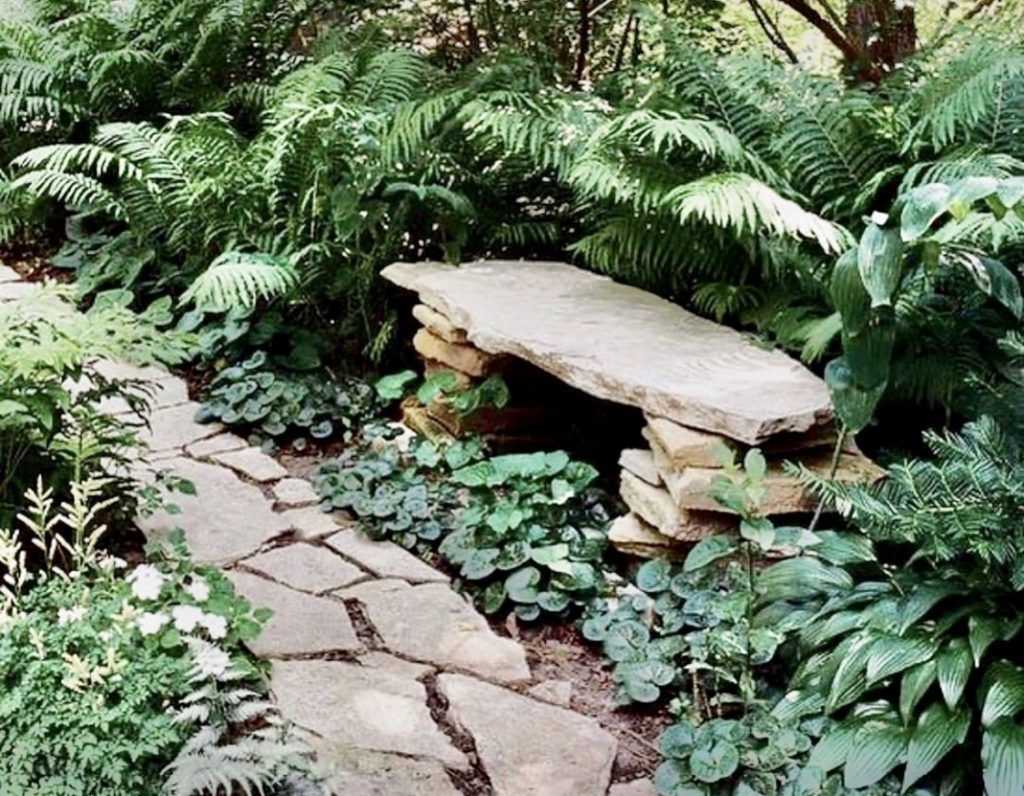
Photo courtesy of @homecompanion Stone and concrete benches add a natural touch and have exceptional longevity. A big plus is they require virtually no maintenance.

Stone swan bench available at tuscanbasins.com Garden benches can add a focal point to your garden. They also provide a place to spend time with friends and family and enjoy an intimate conversation within the garden.
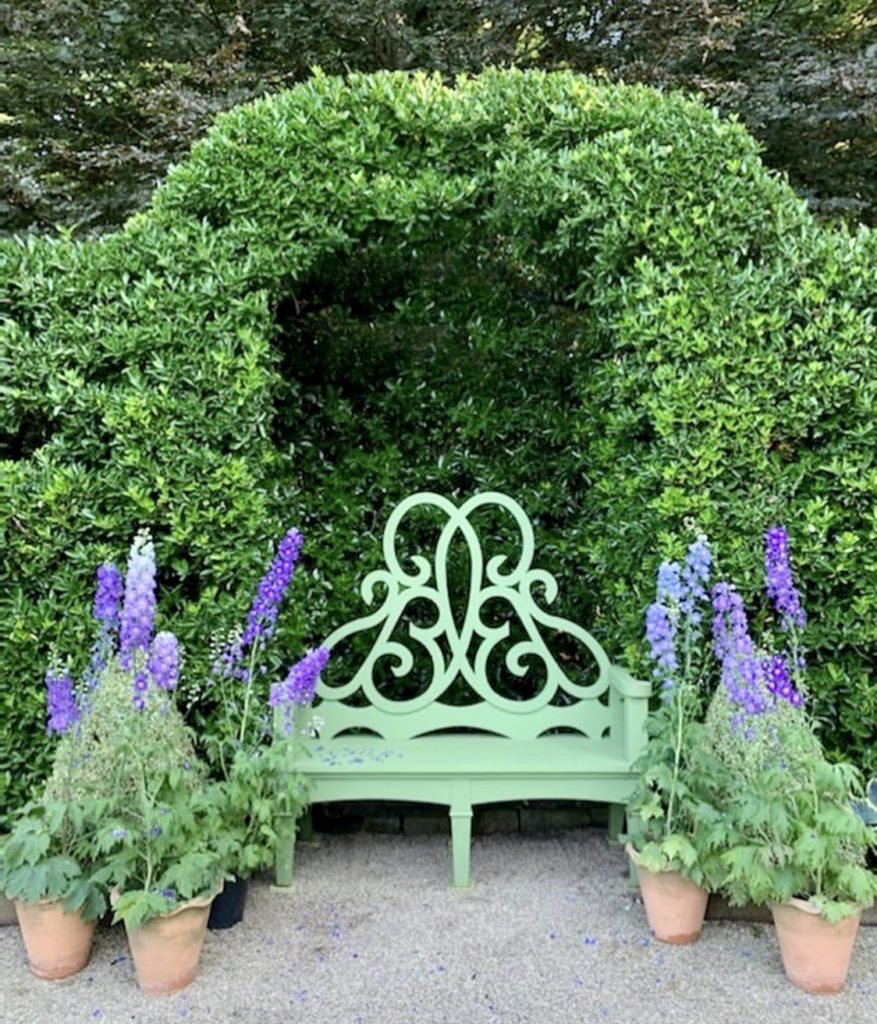
Photo courtesy of @privatenewport 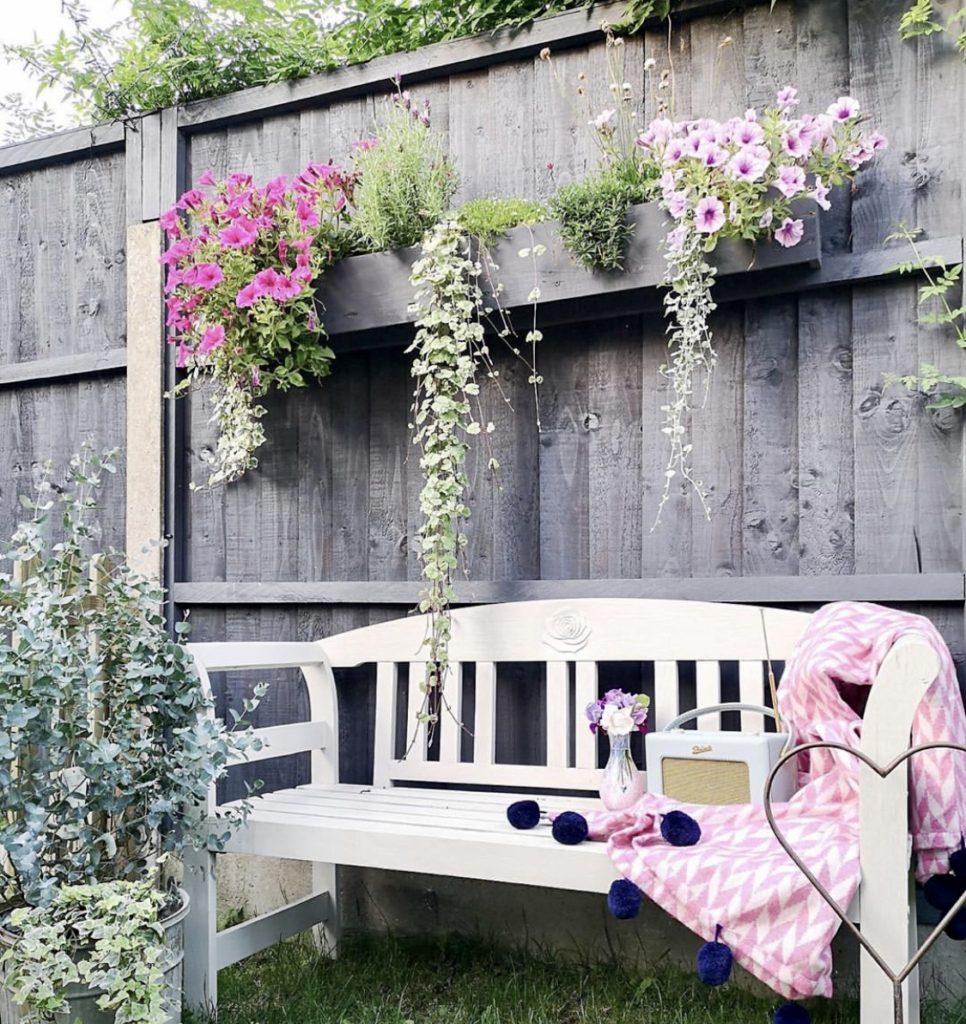
Photo courtesy of @ourlittleflintcottage You can add personality to your garden by adding a splash of color. A kaleidoscope of garden benches are available for sale online as well as in brick & mortar stores, or you can paint your own!
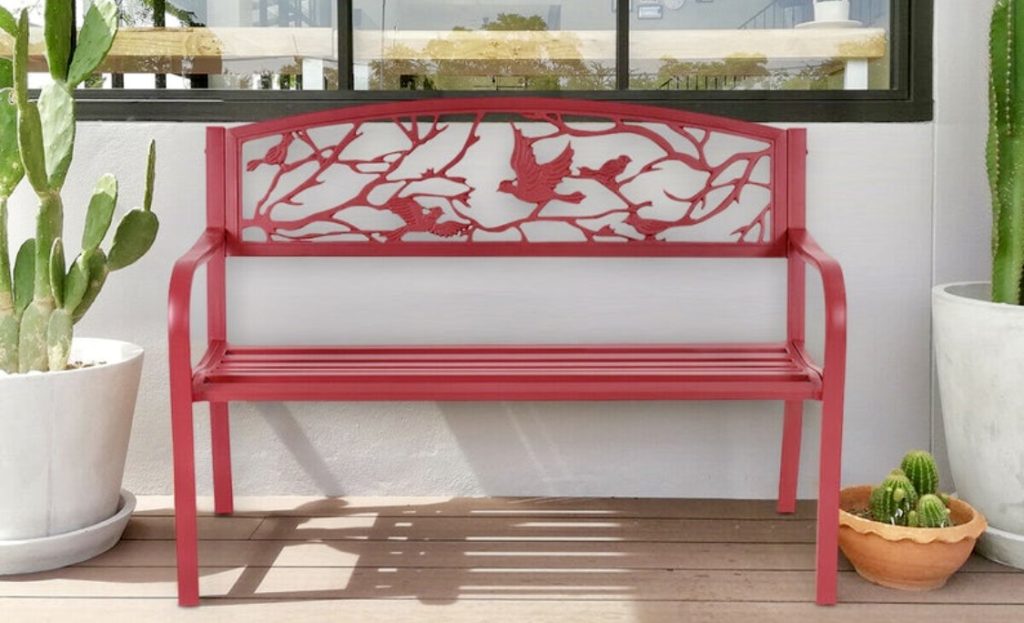
Bold red bird bench available on Etsy.com 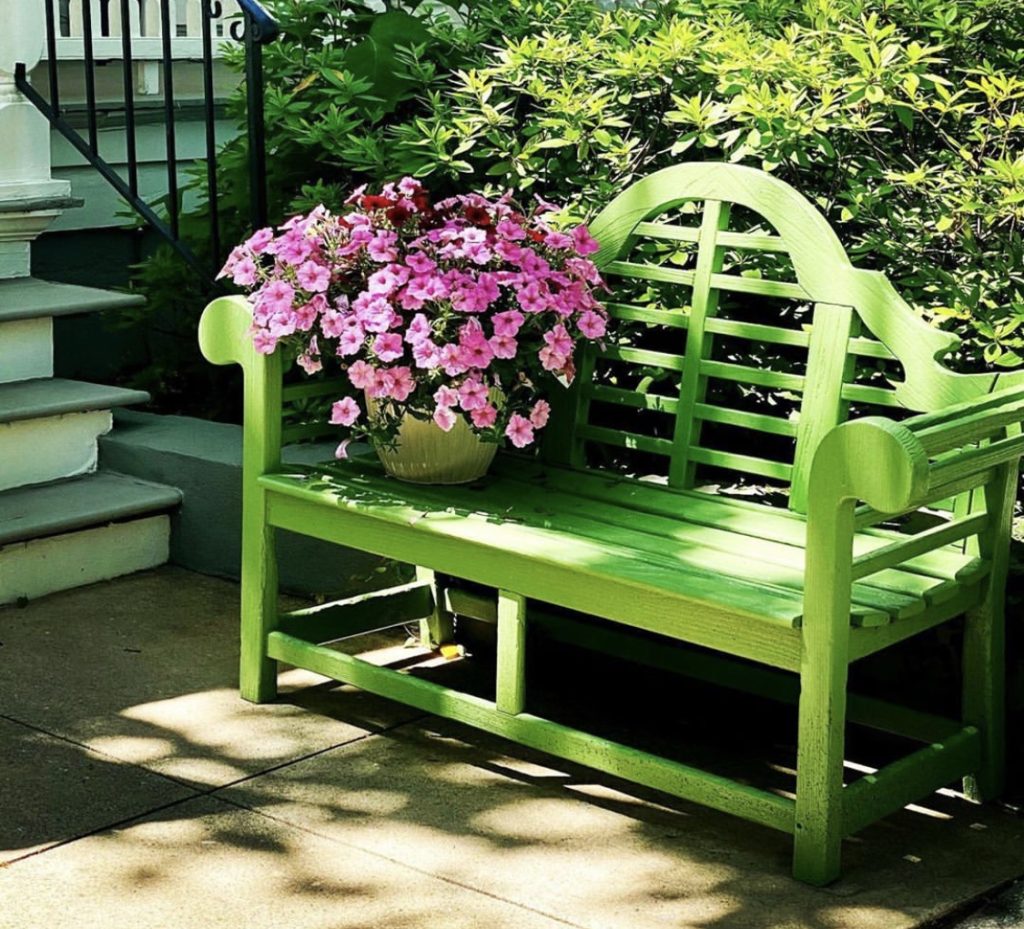
Traditional Lutyens bench painted a happy shade of green. Photo courtesy of @asnipofgoodness Creative folks can repurpose items and invent their own unique garden benches.
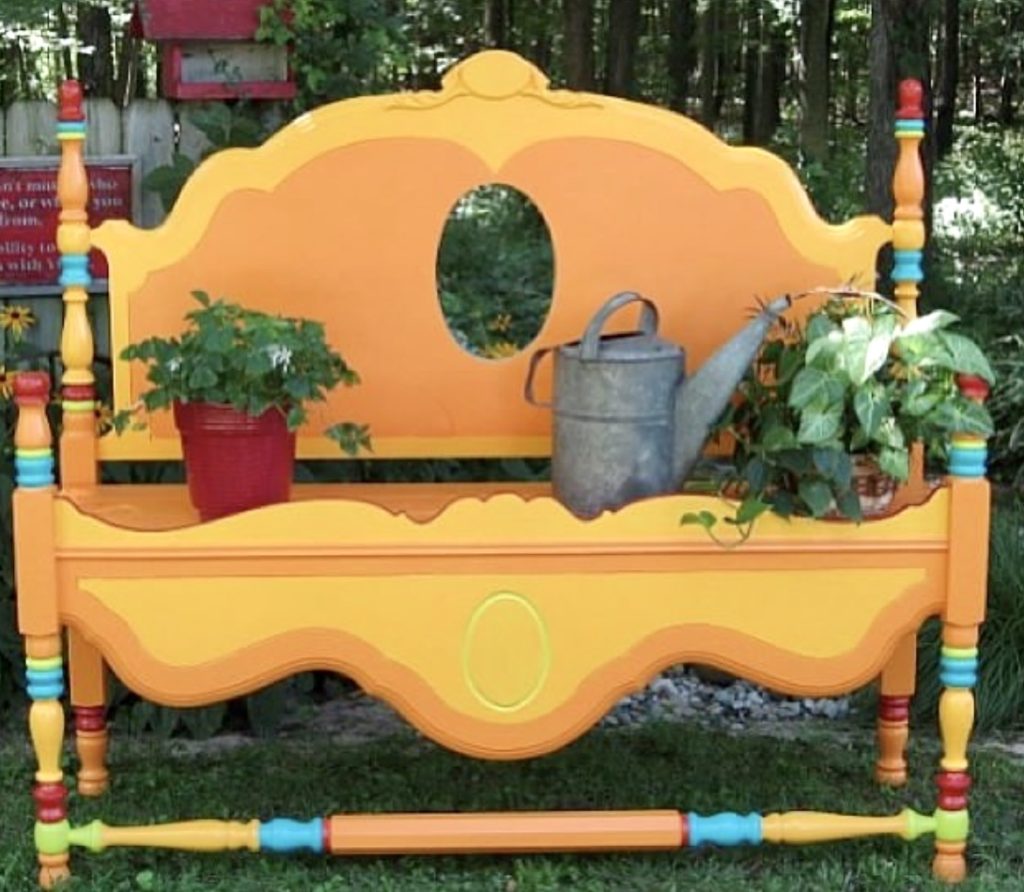
Garden bench repurposed from a vintage bed. Photo courtesy of @home_decoranddesign 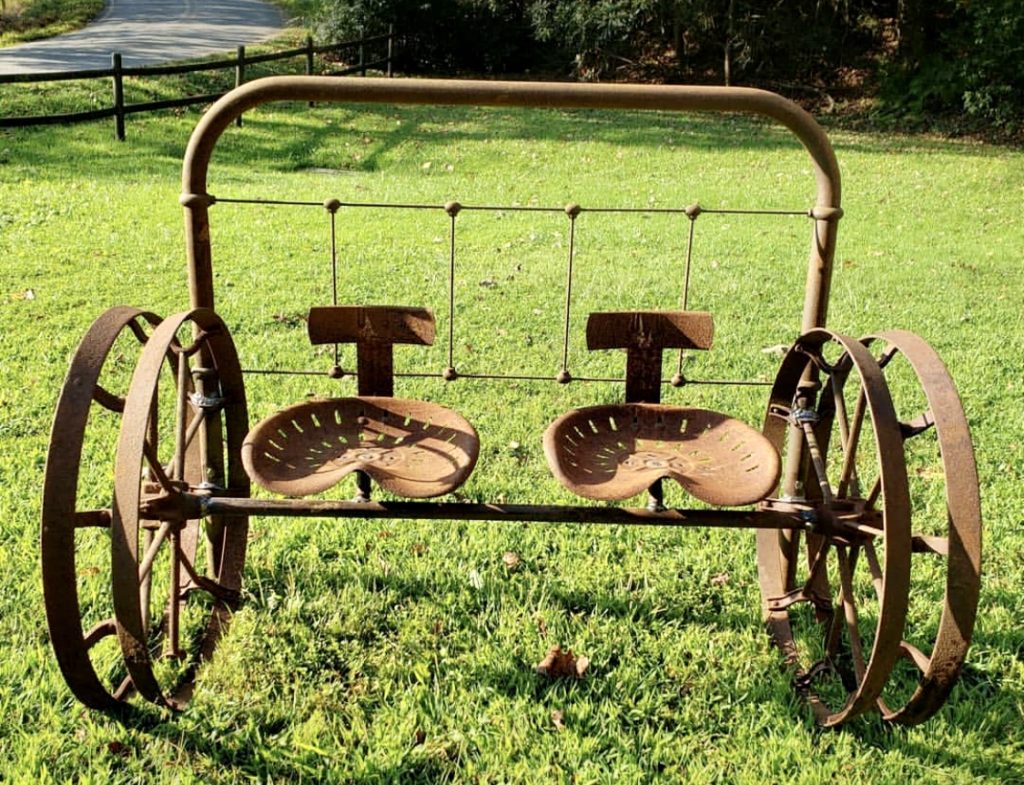
Garden bench constructed from old farm wheels and tractor seats. Photo courtesy of @rusticremakes You may want your garden bench prominently displayed, or tucked secretively away where you can hide from the cares of the world with a cup of tea (or glass of wine) and your favorite book.
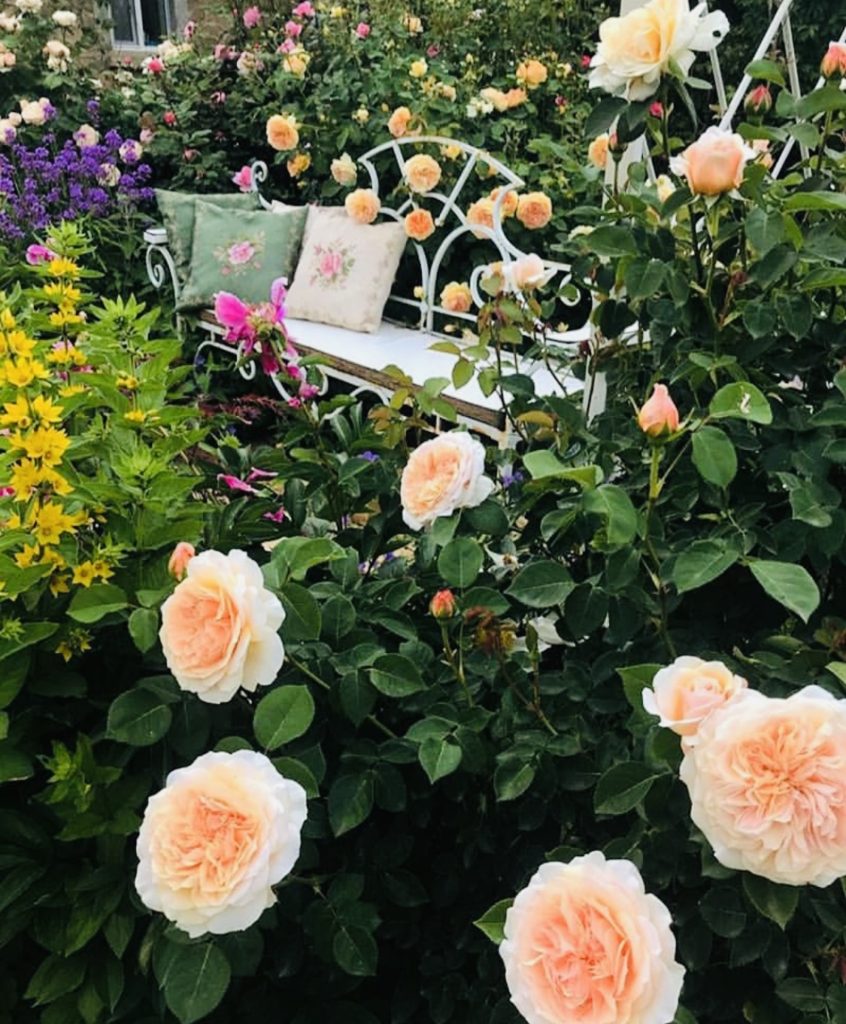
Photo courtesy of @gardens_and_architecture I love roofed benches, which provide a refuge from both raindrops and hot sun in the garden.
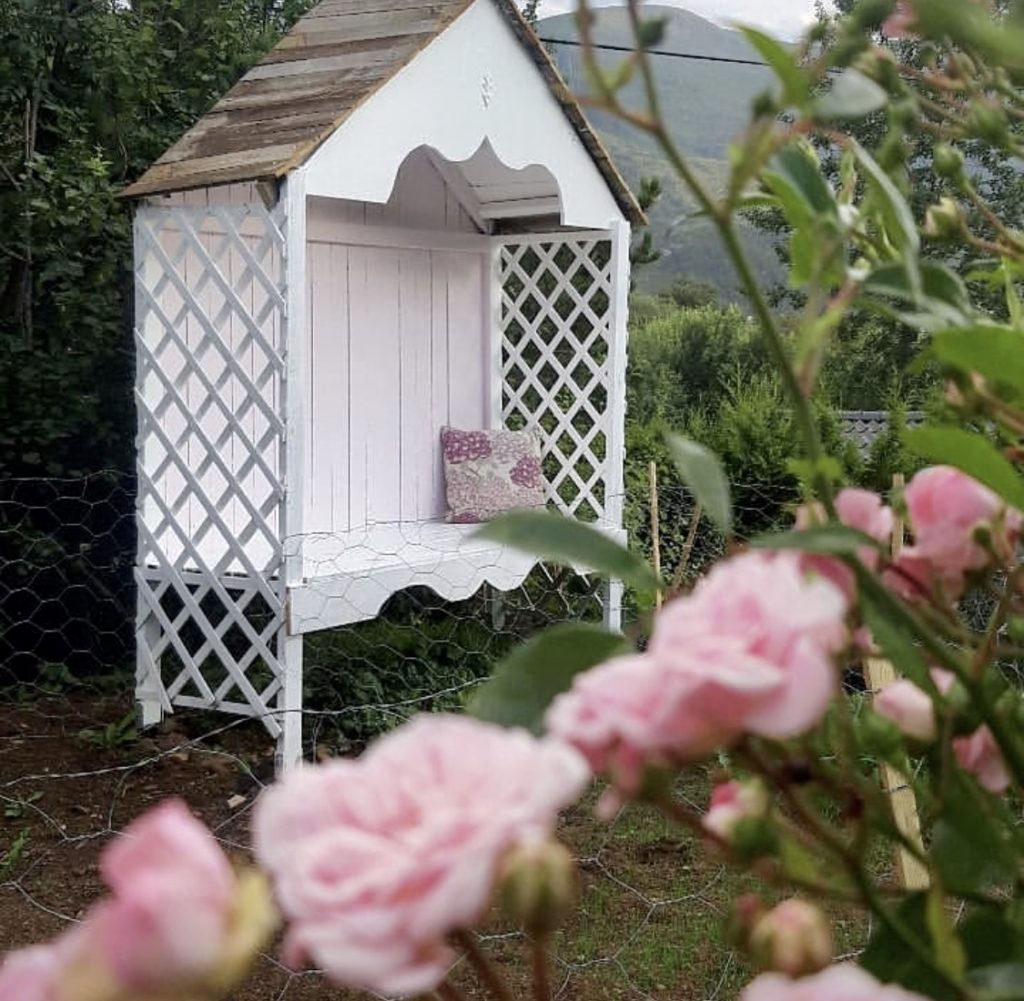
Photo courtesy of @sammensuriumet 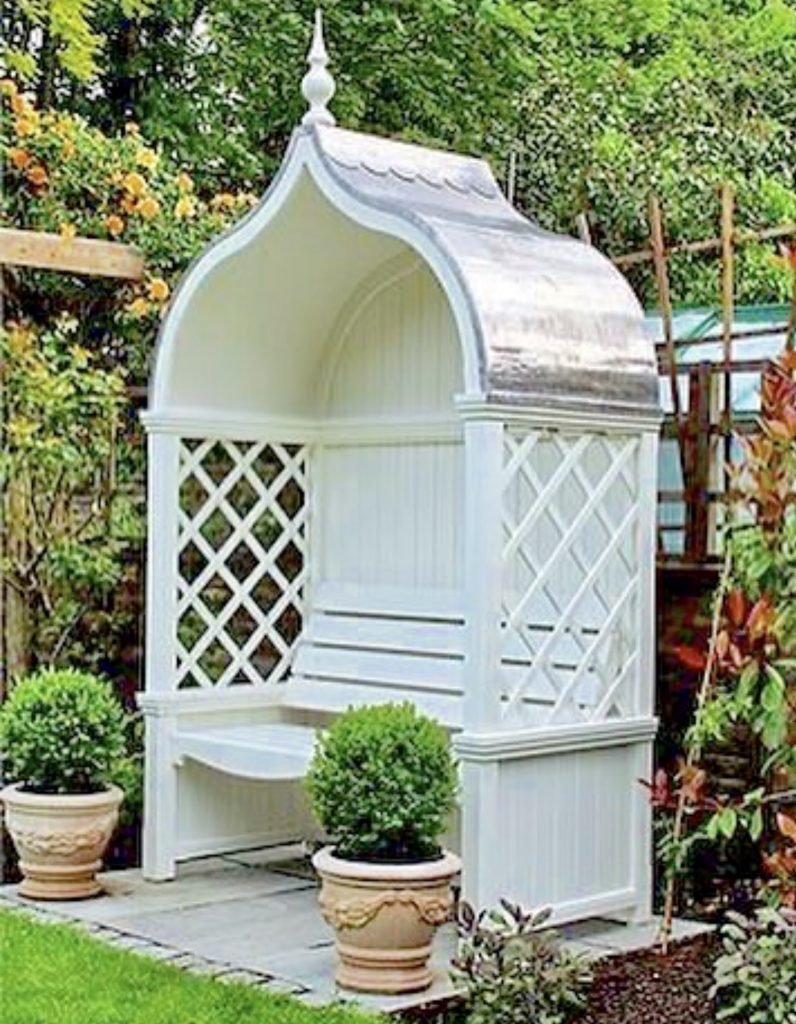
Just remember that in any garden, flowers gone wild can gobble up anything, even your garden bench! Make sure to trim those errant ramblers or you may lose your favorite seat!
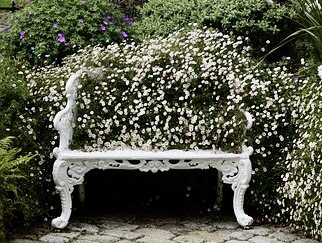
Thank you for visiting my blog! I hope you found some garden bench inspiration! If you enjoyed this post, you may also like my other gardening posts including The Secret Gardens of Historic Monterey, The Garden Gate Story: Inspiration from Carmel-by-the-Sea, Magical & Enchanting Gardens of Carmel-by-the-Sea, Charming & Romantic Window Boxes, and Add Charm to your Garden with Beautiful Birdhouses!
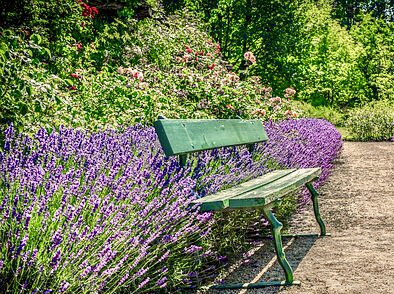
Wishing you peace, love, happiness, and beautiful vistas!
-
Add Charm to your Garden with Beautiful Birdhouses!
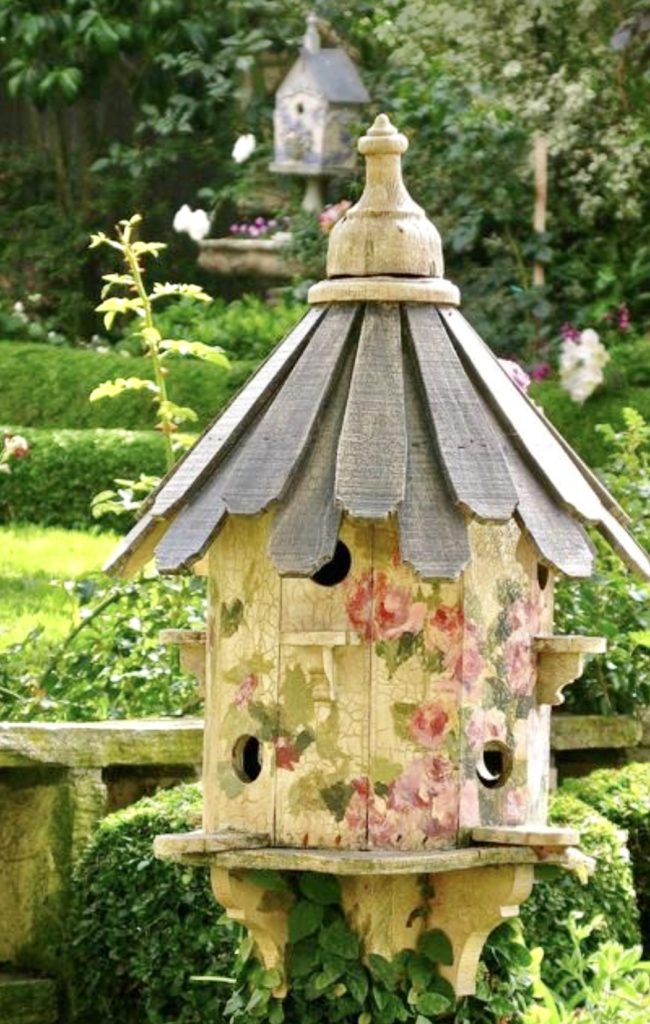
Your garden may feature the usual things: beautiful flowers and shrubs, arbors, pergolas, gates, chairs and tables, but have you thought about adding a birdhouse or two? Birdhouses not only add charm to your outdoor living space but housing birds creates endless benefits and can be immensely rewarding. Birds are wonderful companions to a garden, providing song and beauty as well as eating troublesome insects. Bird watching from your home or garden is also a relaxing and fun activity. It is a wonderful sight to behold birds building their nests and raising their babies.

Photo courtesy of homeiswheretheboatis.net 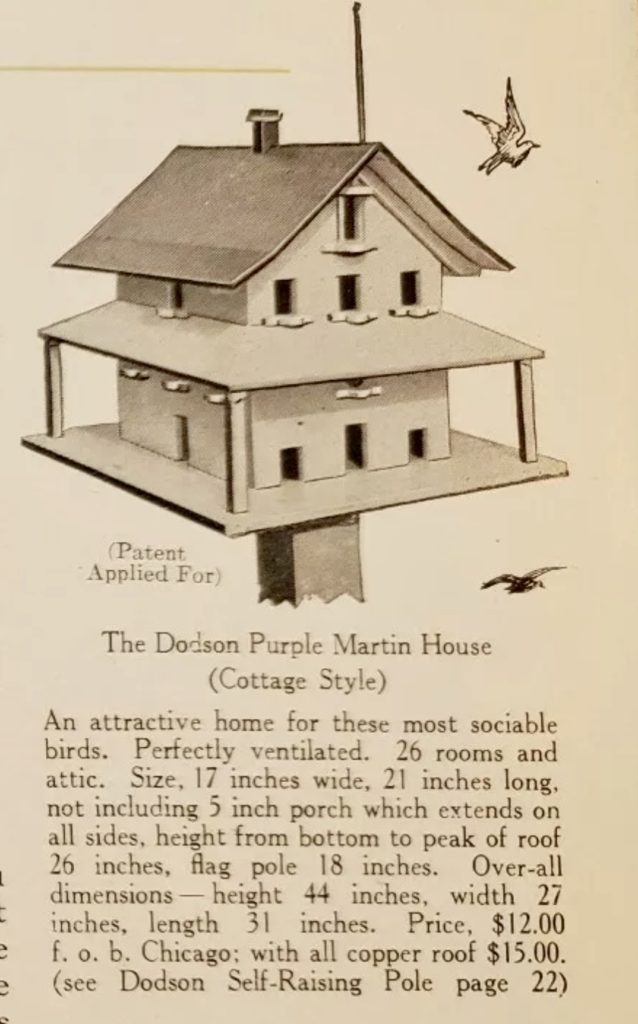
An early 1900s advertisement depicts a quaint birdhouse. Birdhouses have been around for hundreds of years. They come in all shapes and sizes, from purple martin mansions to tiny wren cottages. As birdhouses became increasingly popular, companies evolved solely for the business of building specialty bird abodes.

Photo courtesy of gardeninggonewild.com Today, there are a wide variety of wonderful birdhouses available. If you are handy with tools and equipment you can make them yourself. If not, it is very easy and convenient to purchase unfinished wooden birdhouses and paint them in the colors of your choice. Birdhouses offer a great opportunity to be creative and use your imagination. If you don’t have the time or inclination to pursue this endeavor, there are many beautiful birdhouses available for sale, many hand-made by talented artisans. The following are some of my favorites.
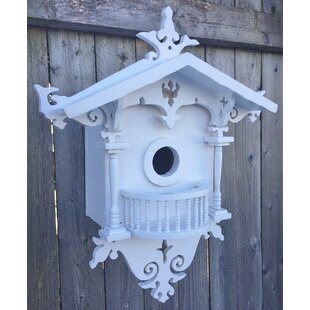
Victorian style birdhouse from wayfair.com If fancy isn’t your style, you can always repurpose. Thank outside the box, or perhaps the thermos!
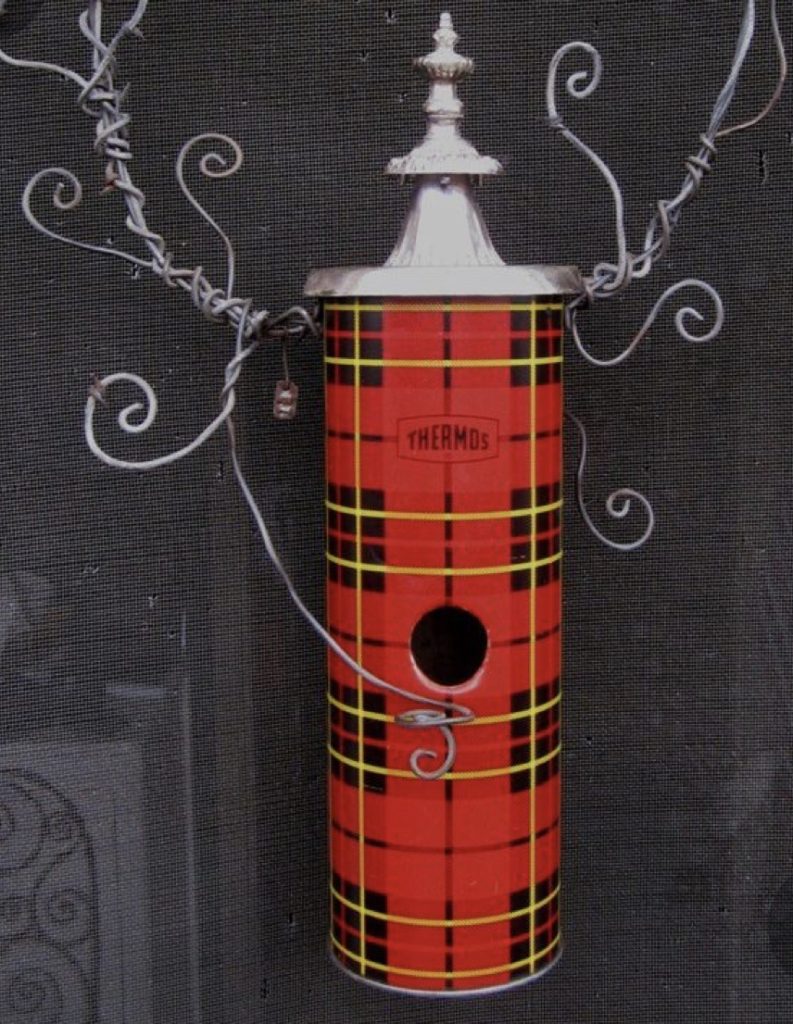
Thermos birdhouse from Etsy.com Rustic birdhouses add farmhouse flair to any garden.

Birds can have their own barn and never have to share with cows or horses, from Etsy.com 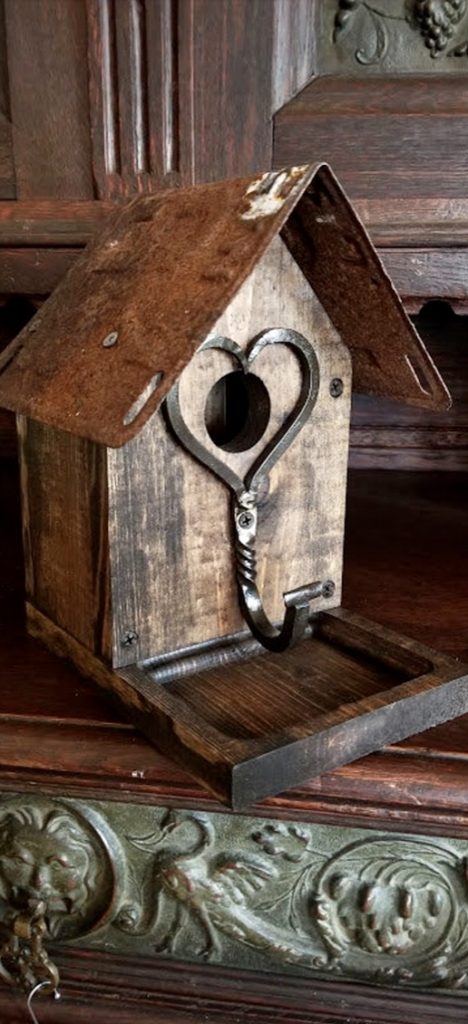
A rusty license plate roof adds shabby chic to this sweet cottage birdhouse from Etsy.com Sometimes it’s nice to incorporate natural elements into your birdhouse.
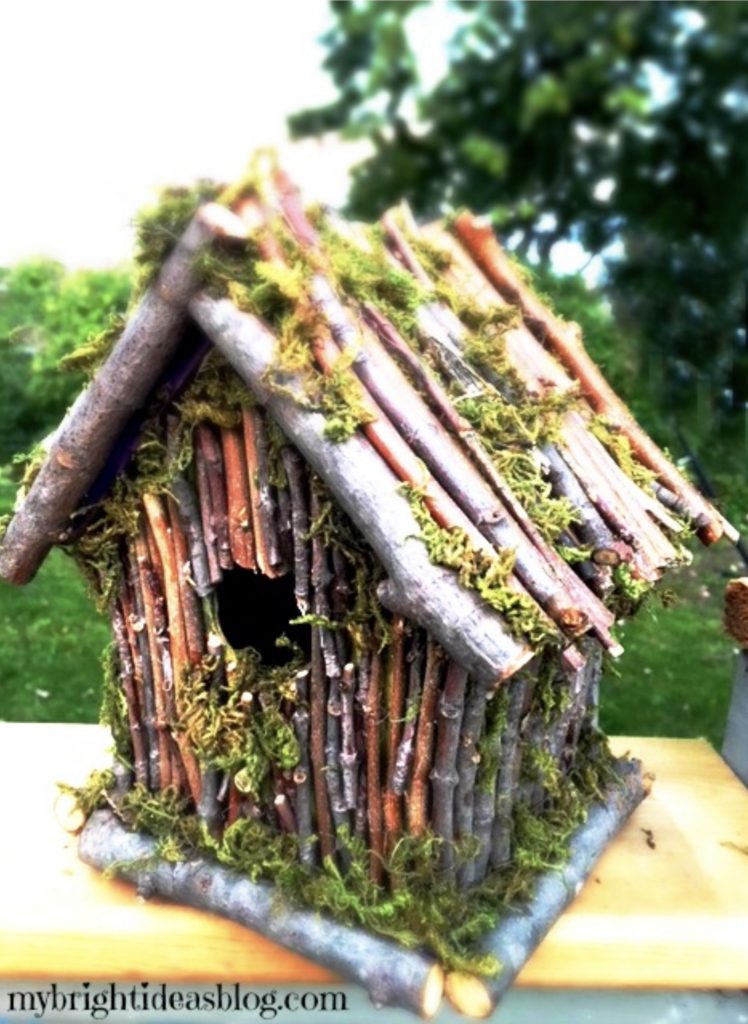
Twigs & moss make for one cozy birdhouse. Photo courtesy of mybrightideasblog.com 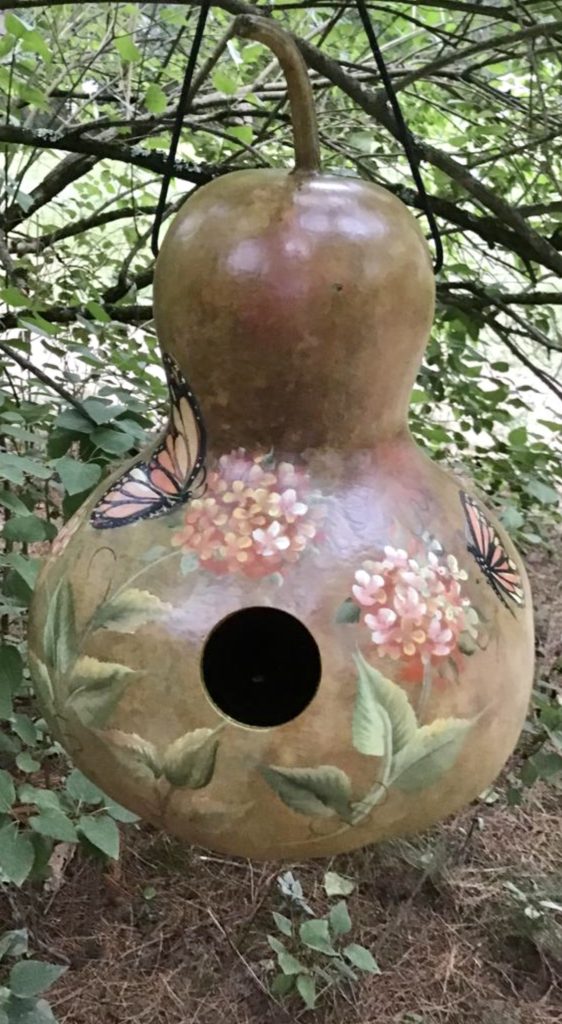
Butterflies & hydrangeas decorate this gourd birdhouse from Etsy.com I find myself drawn to the dreamy, hand-painted ones by artist Debbi Coules. Delicate pink roses on a soft white background make these birdhouses perfect for a cottage garden.
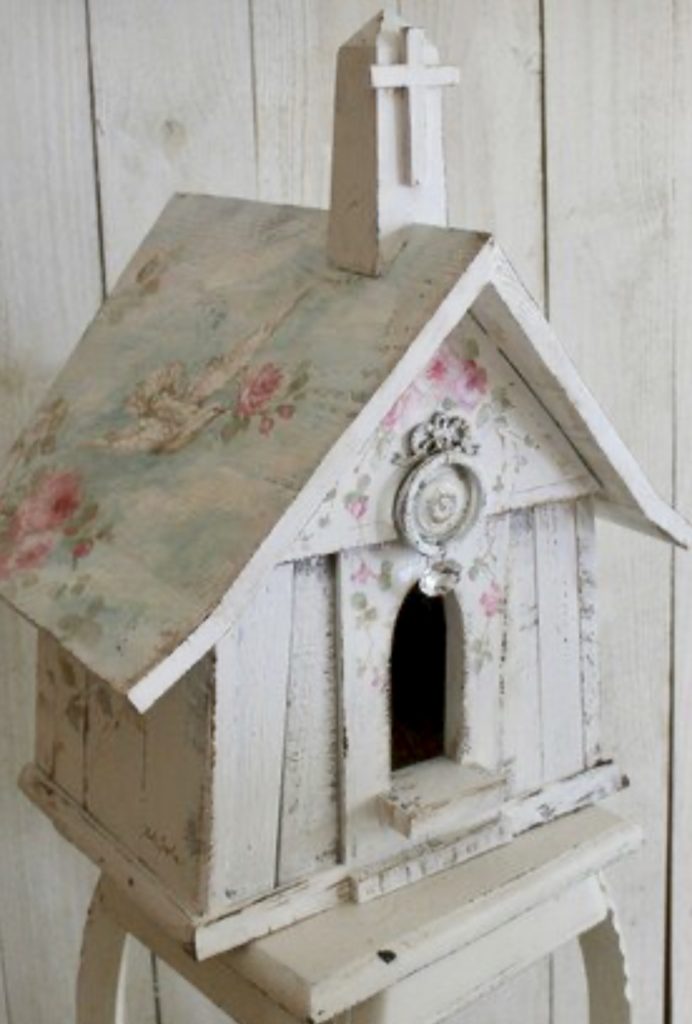
This chapel of love is perfect for a pair of lovebirds, from debicoules.com 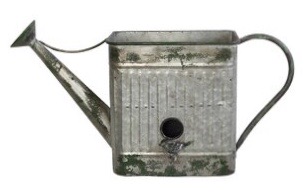
Cute & fun watering can birdhouse from wayfair.com If your heart beats for the red, white and blue, you may be enticed by a patriotic birdhouse.
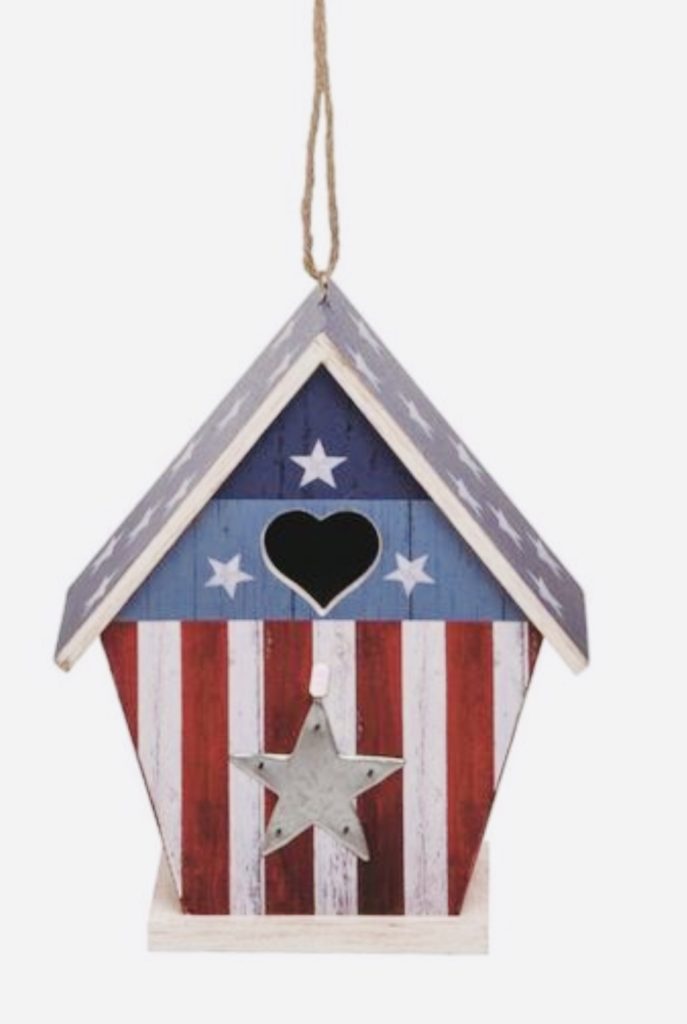
Star-spangled birdhouse from target.com No matter your style, if you can’t find it, you can create it.
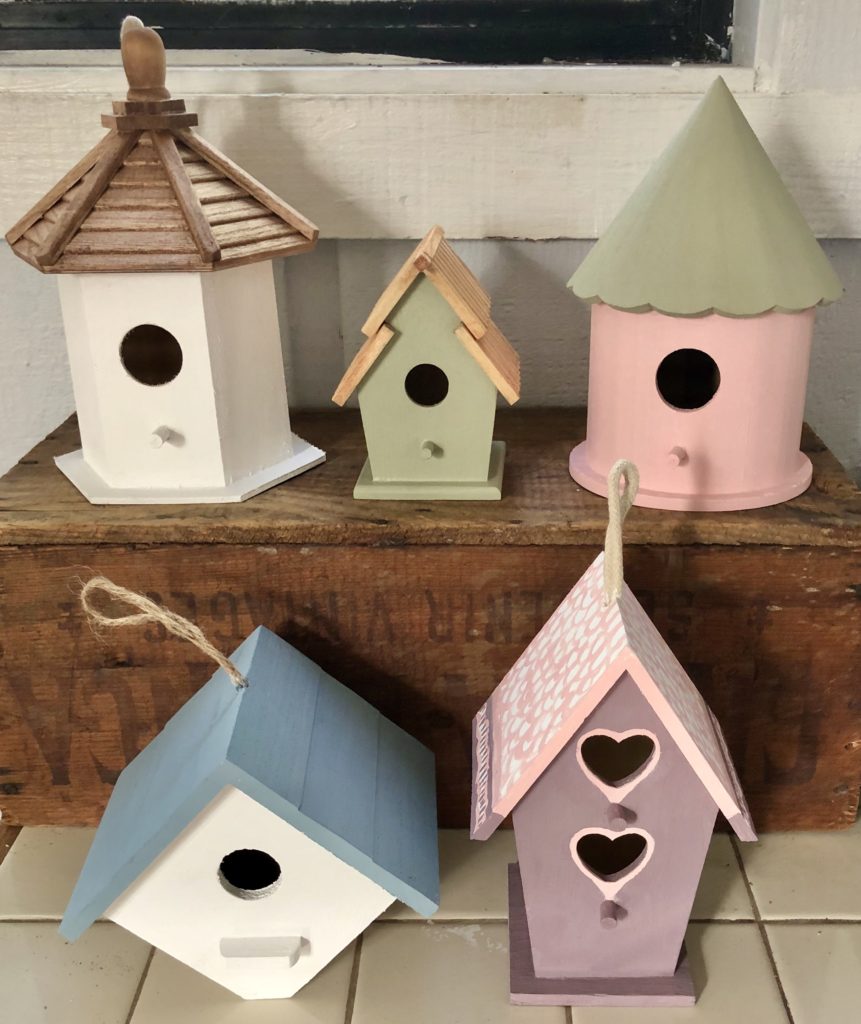
Unfinished craft store wooden birdhouses I repainted/stained. Birdhouses also make wonderful gifts. I was delighted to open a present from my Mom on my birthday and discover this cutie.
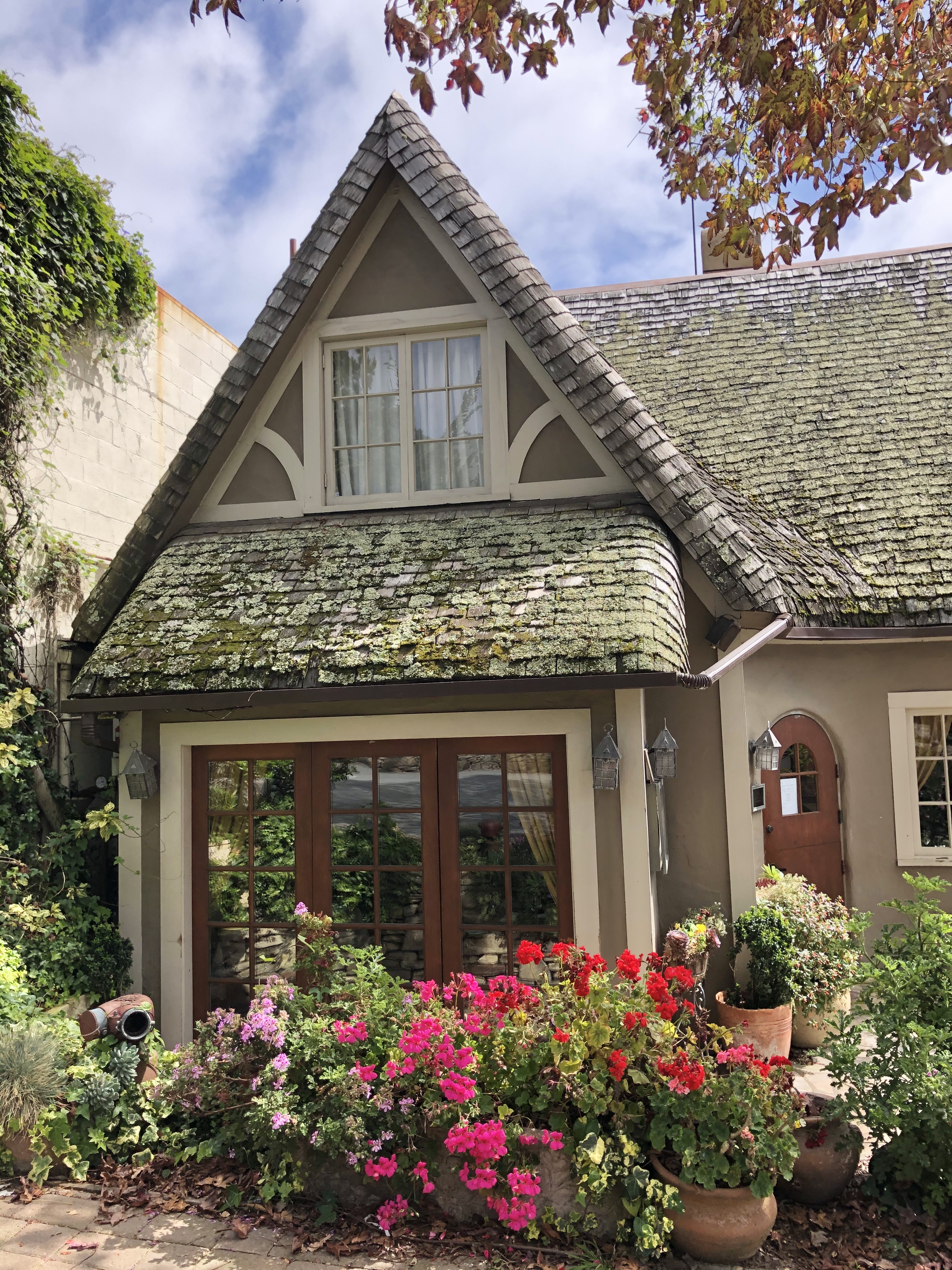
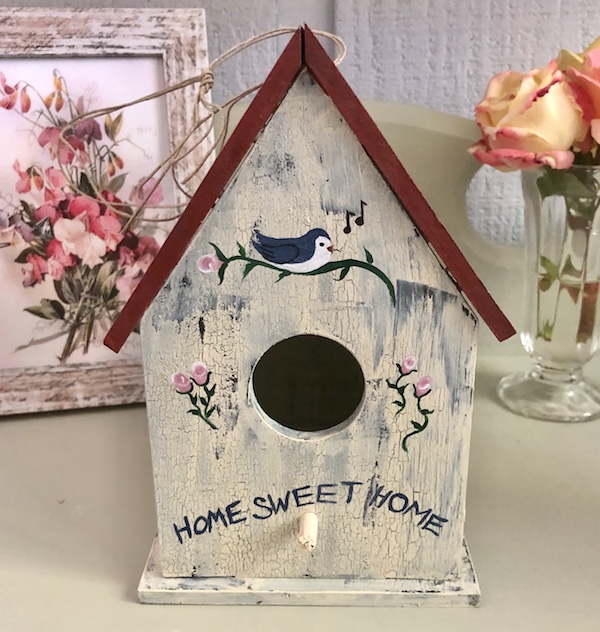
I hope you found some birdhouse inspiration on my blog. Thank you for visiting! Wishing you peace, love, happiness, and beautiful vistas!
-
Picket Fences by the Seaside: Victorian Homes in PG
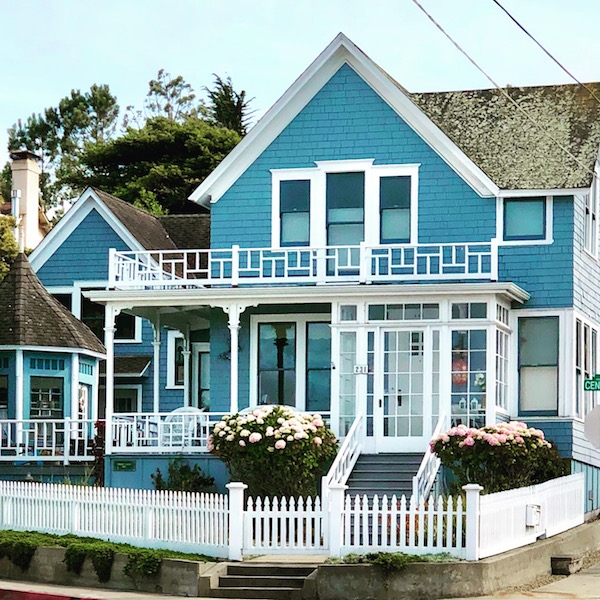
The seaside town of Pacific Grove, California is full of cute Victorian homes with white picket fences. Many of these homes are just steps away from the beach and Lover’s Point.
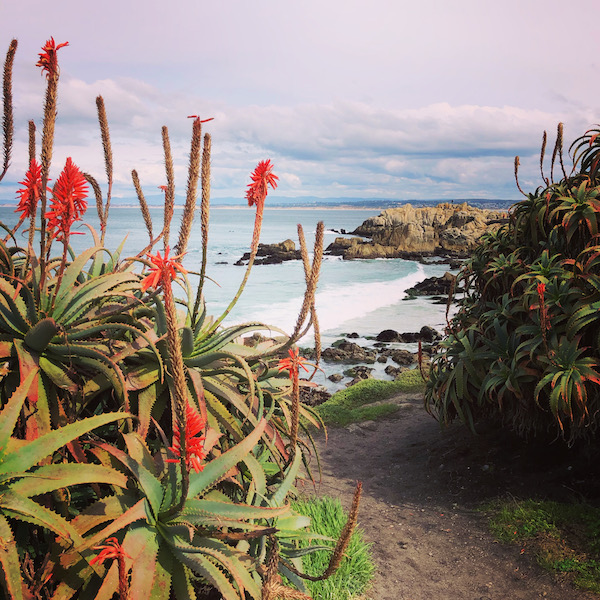
A view of Lover’s Point in Pacific Grove. What began in 1875 as a summer church camp has proliferated into what is now called “America’s Last Hometown”. It supposedly has more historical houses per capita than anywhere in California.
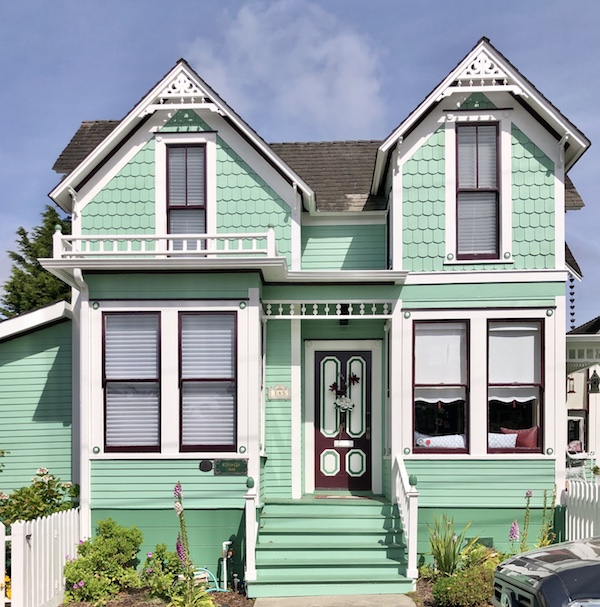
Pacific Grove, called “PG” by locals, has many interesting shops and restaurants, many located on or near the famous Lighthouse Avenue. I love all the ocean themed street names here. There is even a Mermaid Lane!
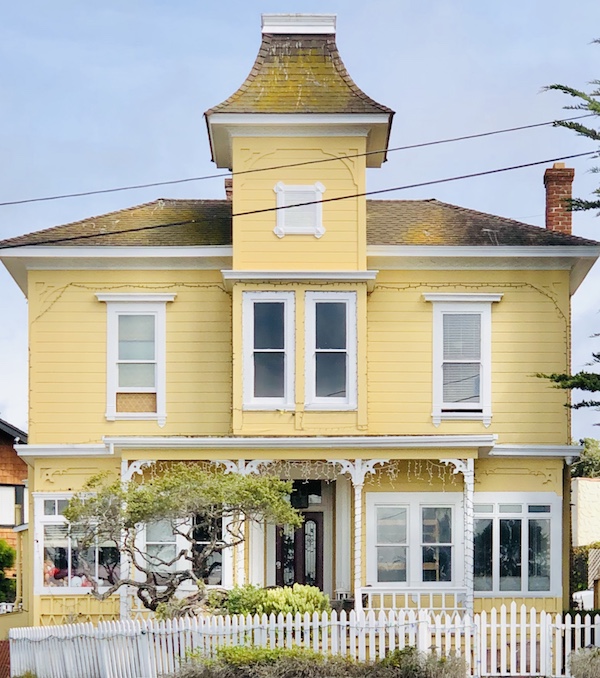
An interesting thing about Pacific Grove, or PG, is that it must have some of the tiniest Victorian cottages ever. You will see itsy bitsy identical twin and triplet cottages sitting next to each other. Some of them are so tiny, I can’t imagine even being able to have furniture inside! They remind me of little gingerbread doll houses.

I really love the imaginative colors people have chosen for their Victorian homes here, and the flowers they have planted alongside them.


You may wonder why you see decorative butterflies everywhere here attached to homes, fences and in yards. The reason is that Pacific Grove is also known as “Butterfly Town” due to the thousands of monarch butterflies that overwinter here on the Monterey pines and eucalyptus trees. You can see them at the Monarch Grove Sanctuary from October through March. For more information see butterfly town.
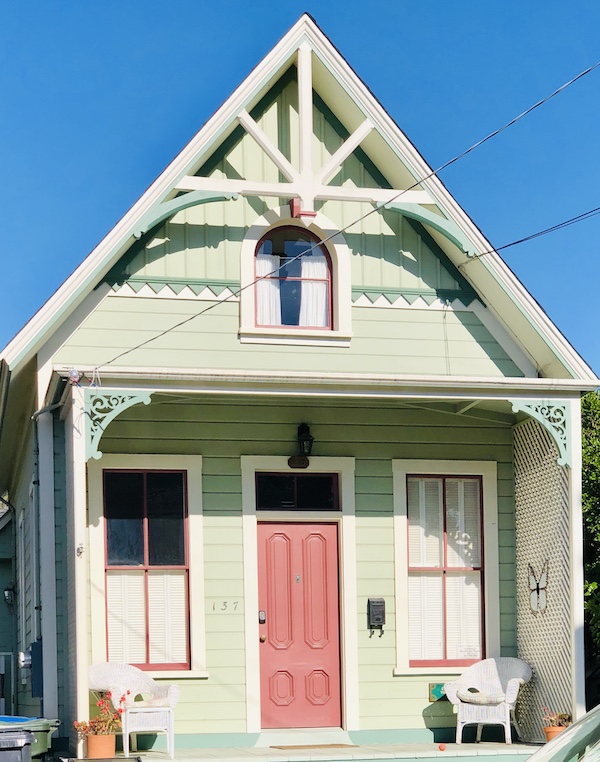
Some of the larger Victorians have been converted into seaside hotels. My favorite is Green Gables Inn which has nothing to do with those famous Lucy Maud Montgomery novels written about one of my favorite characters ever, Anne. There is just something enticing about this beautiful home overlooking Lover’s Point. I remember being smitten with it the first time I visited the area.
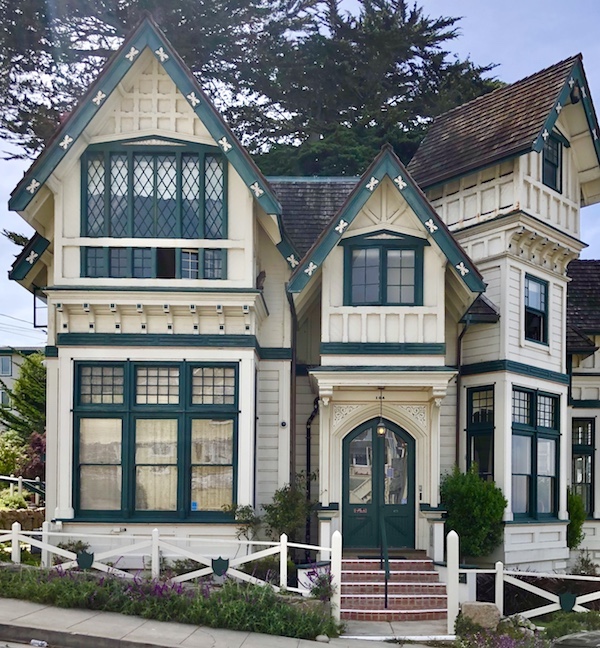
The stately Green Gables Inn looks out at the ocean. For more information on Pacific Grove, see my other blog posts, including Lovers Point: Legendary Park in Pacific Grove, Butterfly Town: Pacific Grove, The Feast of Lanterns in Pacific Grove, and Point Pinos Lighthouse, Pacific Grove.

Thank you for visiting my blog! Wishing you peace, love, happiness, & beautiful vistas.
-
Charming & Romantic Window Boxes
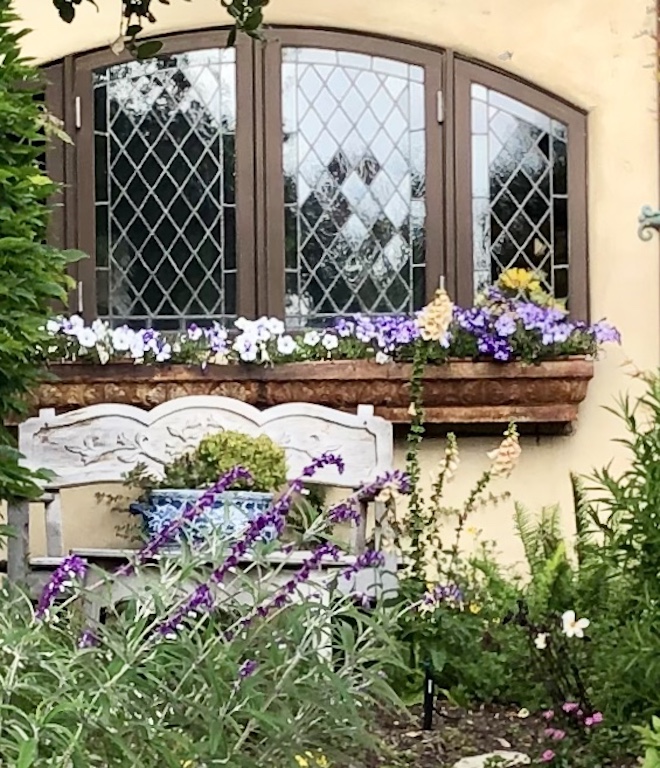
There are always flowers for those who want to see them~Henri Matisse. Nothing says happy like a cascade of colorful flowers spilling from a window box! While walking around one of my favorite places, Carmel-by-the-Sea, I noticed that many of the homes have window boxes. They add so much loveliness to already charming homes. I find so much gardening inspiration just by observing the beautiful gardens others have created, and the imaginative touches they have used.

Window boxes come in all sizes and may be made of wood, copper, wrought iron, etc. They create a “living wall” and can beautifully accentuate your home. It is easy to see how much beauty a window box adds to a home–just imagine this dwelling without it?
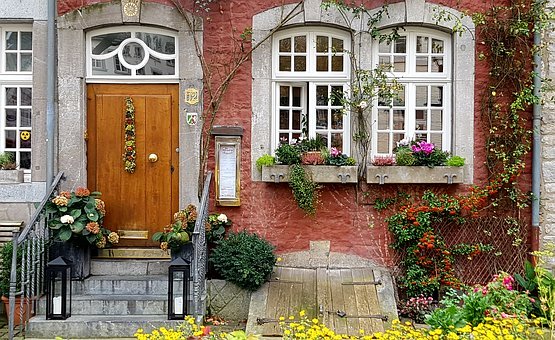
For those with small yards or none at all, window boxes and planters offer a great option to add romance and charm with flowers.
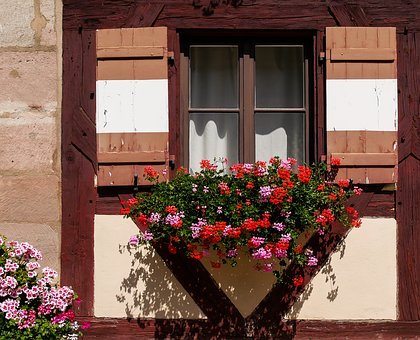
Sun and shade requirements will determine what flowers to plant in your window box. Popular flowers for window boxes include geraniums, begonias, verbena, pansies, petunias, trailing fuchsias, salvia, impatiens, ivy, vinca vine, sweet potato vine, and lobelia.

Often, incorporating colors from the rest of the yard or garden, including trees & shrubs, can help tie everything together.

Multiple window boxes look best when the same types of flowers groups are repeated in each. Simple arrangements have a more organized and cohesive vibe.

Window boxes filled with beautiful flowers brighten your home and are easy to care for. Just make sure they have proper drainage and water them according to their needs. It’s also a good idea to provide fertilizer regularly to help boost blooms.
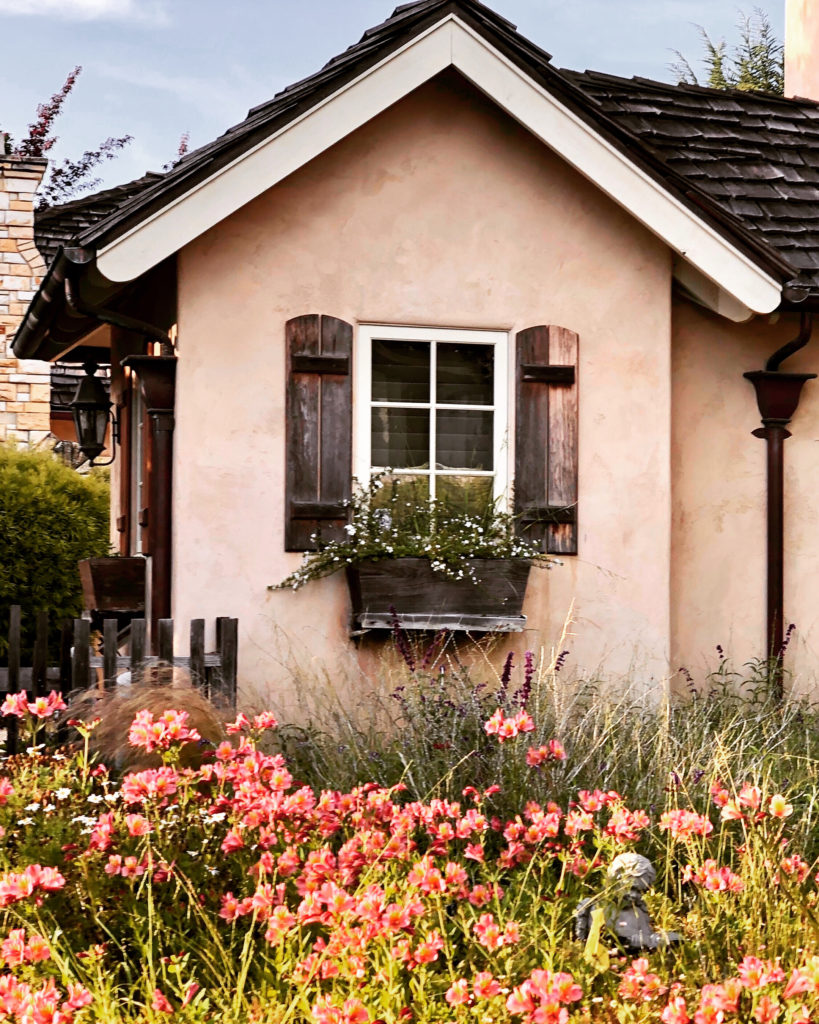
Your imagination is the limit. Never be afraid to experiment; you may make a mistake now and then in gardening, but you will learn from your experiences.
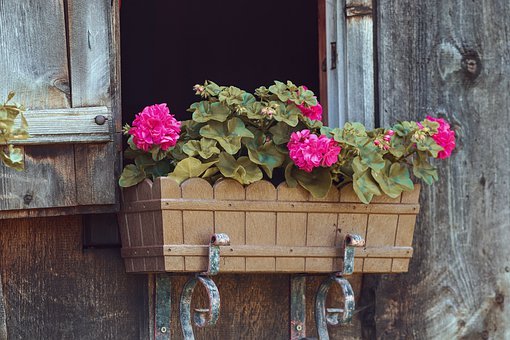
For more information on gardens in Carmel-by-the-Sea, see my Magical & Enchanting Gardens of Carmel-by-the-Sea. Thank you for visiting my blog! Wishing you peace, love, happiness, & beautiful vistas.
-
Quarantine in Captivating Carmel-by-the-Sea
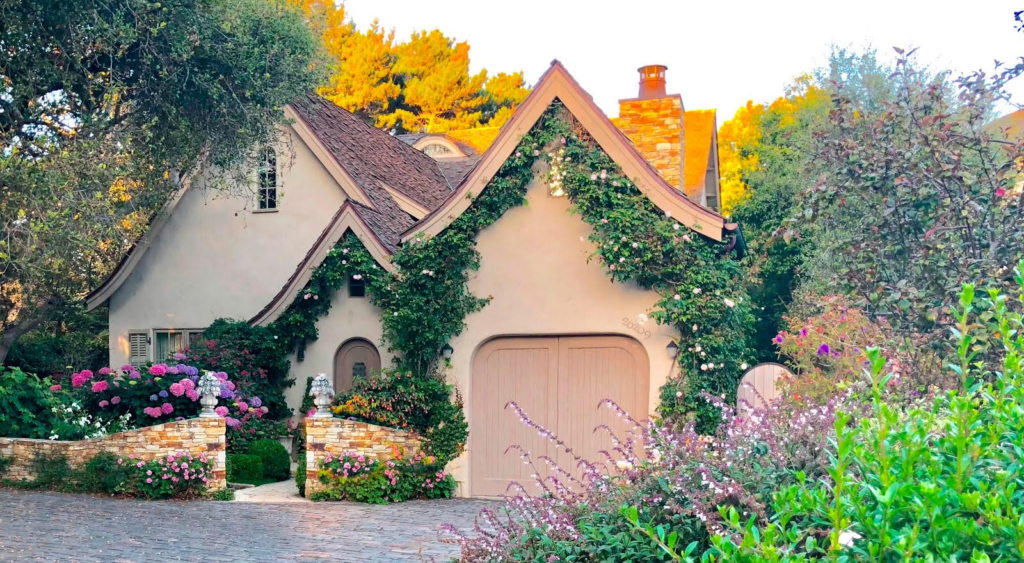
Even though the quarantine has disrupted many travel plans, I feel so blessed to live in this area. I hope that everyone has a chance someday to visit Carmel-by-the-Sea, located in central coastal California, and witness first hand this captivating and charming town. I have previously written other blog posts about Carmel-by-the-Sea, including Gardens of Carmel-by-the-Sea, Garden Gate Inspiration from Carmel-by-the-Sea, and Fairy Tale Cottages in Carmel-by-the-Sea. Even though shops and art galleries are still closed, many of the amazing restaurants here are open with take out and social distanced al fresco dining. And fortunately, the pandemic can’t hamper one of the most fun things to do here, just walk around. You will feel like you are in a fairy tale, because this little seaside town just happens to be home to some of the loveliest cottages and gardens in the area.
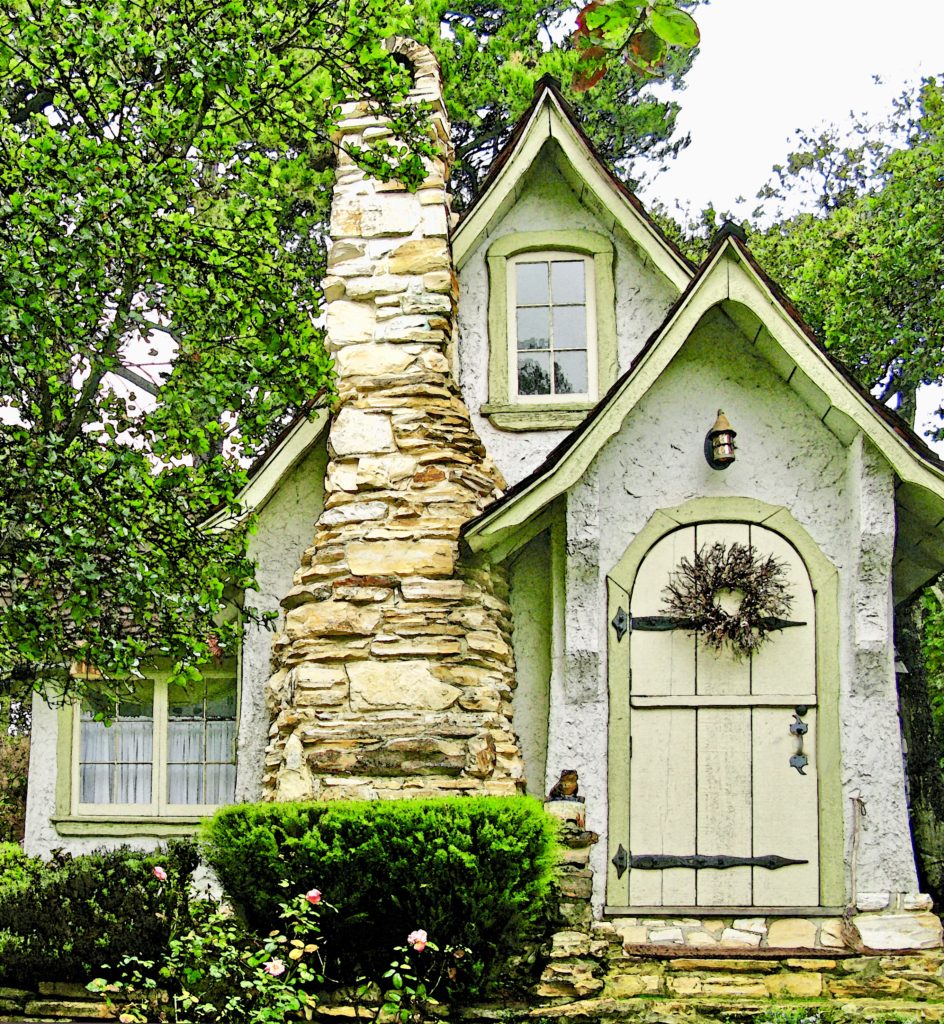
It all started in the early 1900s, when Hugh Comstock built the town’s first fairy tale cottage for his wife, Mayotta. The homes he built featured steep roofs, arched windows and doors, and rustic stone chimneys. His cottages have been duplicated over the years, and have inspired generations of delightful homes, so that walking through many of the side streets you may imagine you are no longer in America, but rather, in a charming English village.
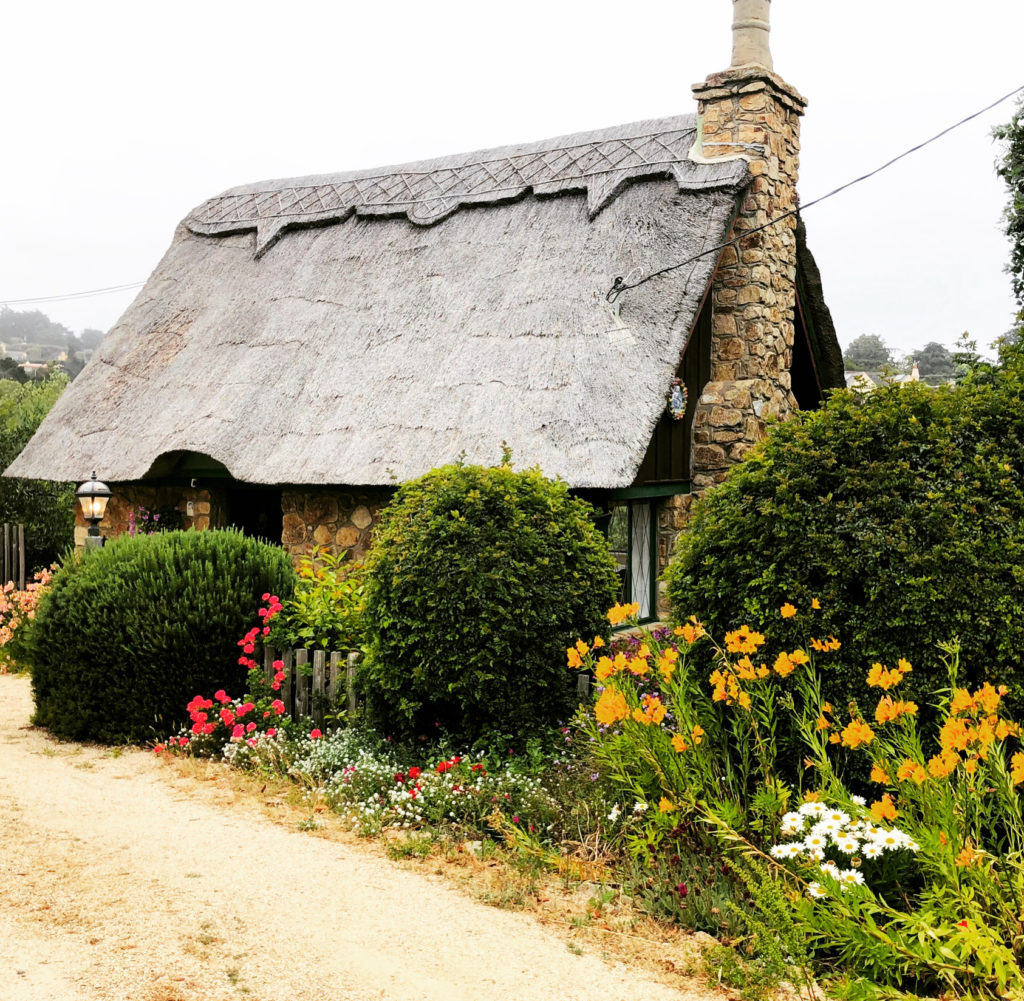
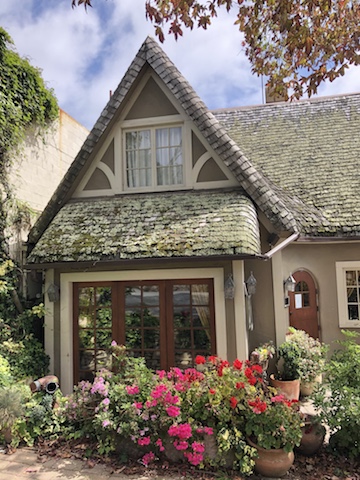
The gardens in Carmel-by-the-Sea are simply the icing on the cake. From fetching window boxes, to picket fences, to lovely archways and stone walls, there is an eye-catching assortment of detail. Colorful flowers paint the landscape around these storybook homes with a beautiful palette of colors and textures.

Quarantine or not, it is clear that many people here are passionate about gardening and put a great deal of time and love into their gardens. I would like to personally thank them for all the inspiration and cheerfulness they provide to us passers-by!
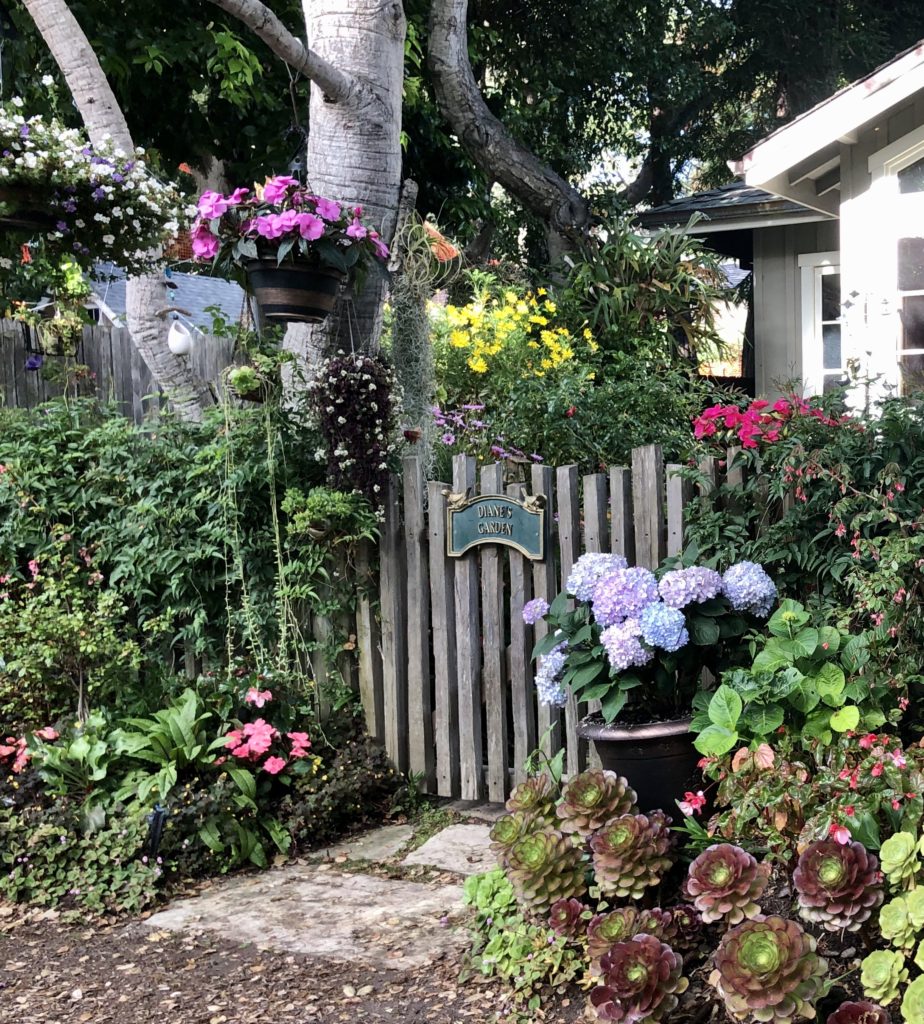
A quirky thing about Carmel-by-the-Sea is that all the homes have names instead of house numbers. Most of the home names are pretty or cute, but I like the name I saw on one the best of all: “Nobody’s Perfect”!
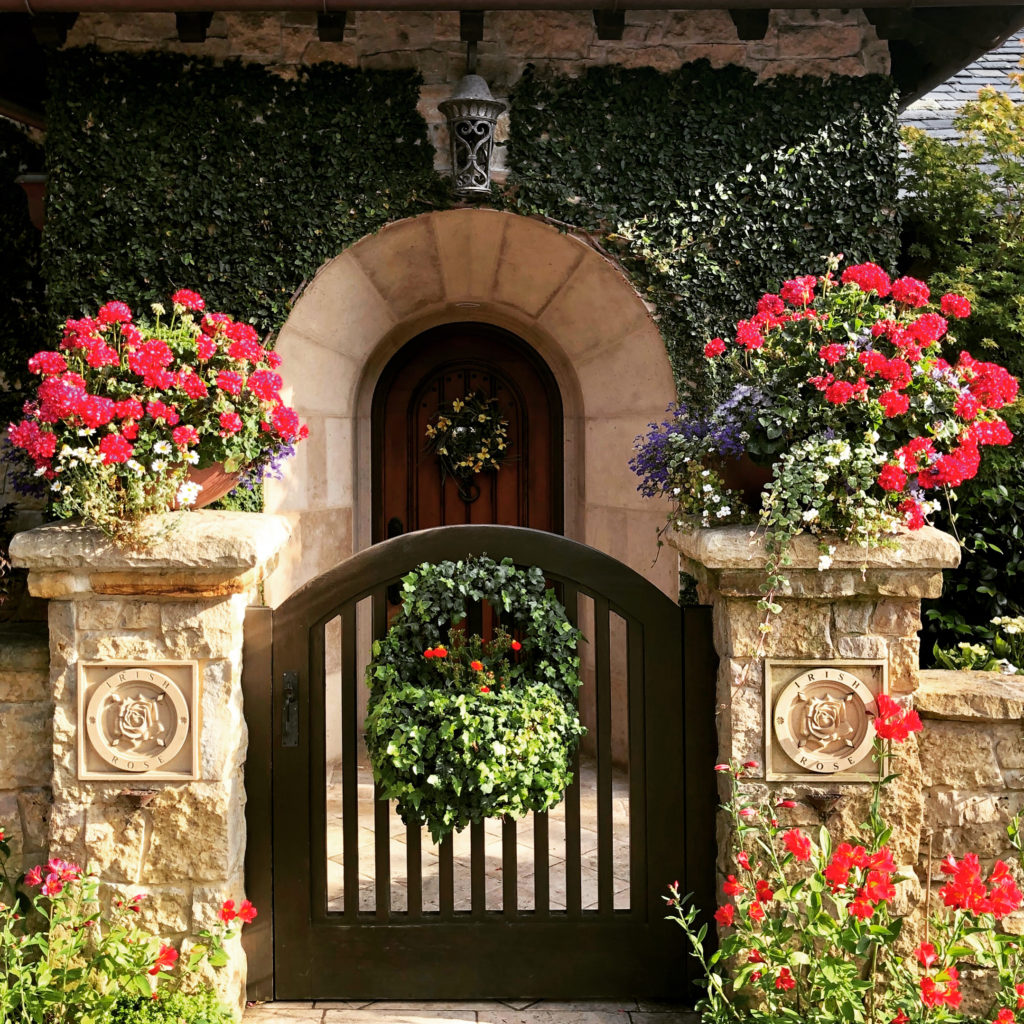
This home is called “Irish Rose”. The latest addition to Carmel-by-the-Sea, on 6th Avenue & Mission, this Instagrammable wall mural was being completed while my friend Amy @seasaltandcypress and I were dining al fresco at nearby Grasings. Opinion has been mixed, folks either love it or hate it. I love it!
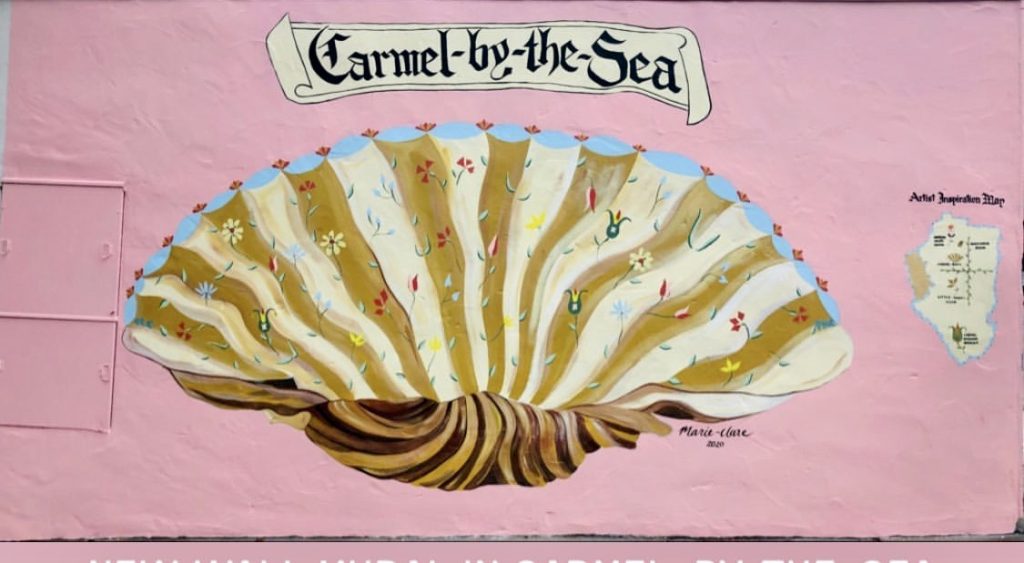
Someday, I hope the word quarantine will be obsolete. I hope that we all have discovered what is most important in life. I hope that we have learned to slow down and appreciate the beauty around us. I hope we never again take anything for granted and have learned to be grateful for all good things. If you do someday visit Carmel-by-the-Sea, dear friend, here is my parting advice. The best way to end the day is to take a leisurely stroll down to the beach and enjoy the soothing lull of the ocean waves and the color-drenched sunset. Because in Carmel-by-the-Sea, fairy tales really do come true.

Thank you for visiting my blog! Wishing you peace, love, happiness, & beautiful vistas.
-
Stop and Smell the Roses in San Jose!
Footfalls echo in the memory, Down the passage which we did not take, Towards the door we never opened, Into the rose-garden~T. S. Eliot.
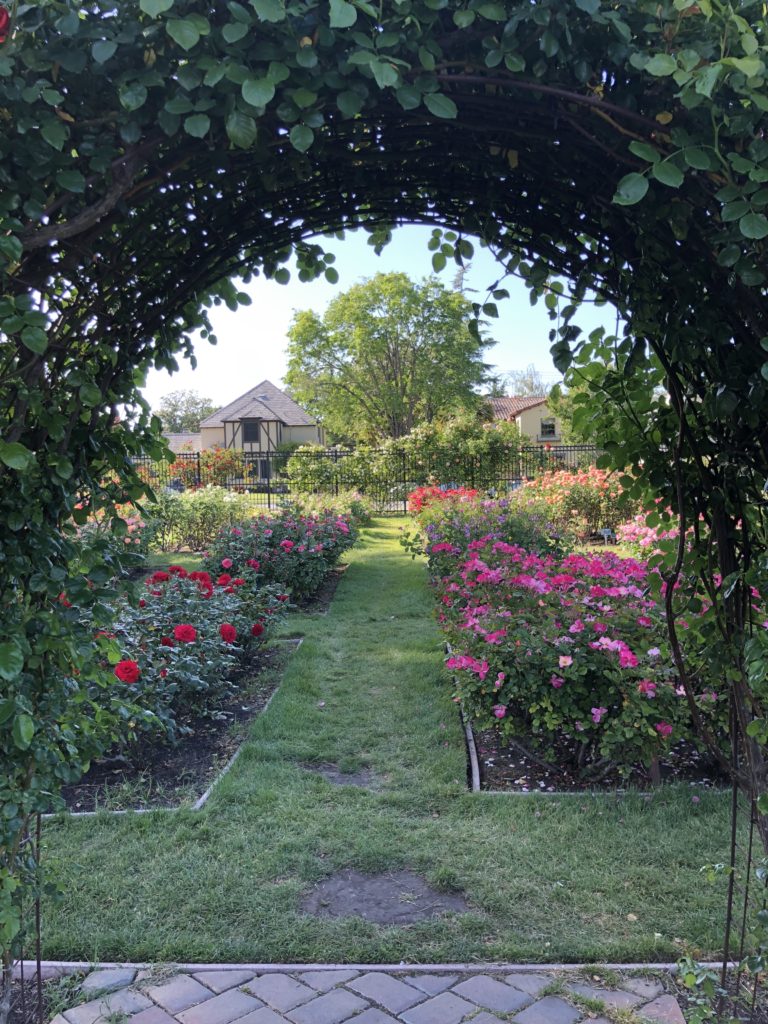 San Jose is home to some pretty amazing places, including their Municipal Rose Garden. Since I absolutely love roses, I had to check it out. I am so glad I did!
San Jose is home to some pretty amazing places, including their Municipal Rose Garden. Since I absolutely love roses, I had to check it out. I am so glad I did!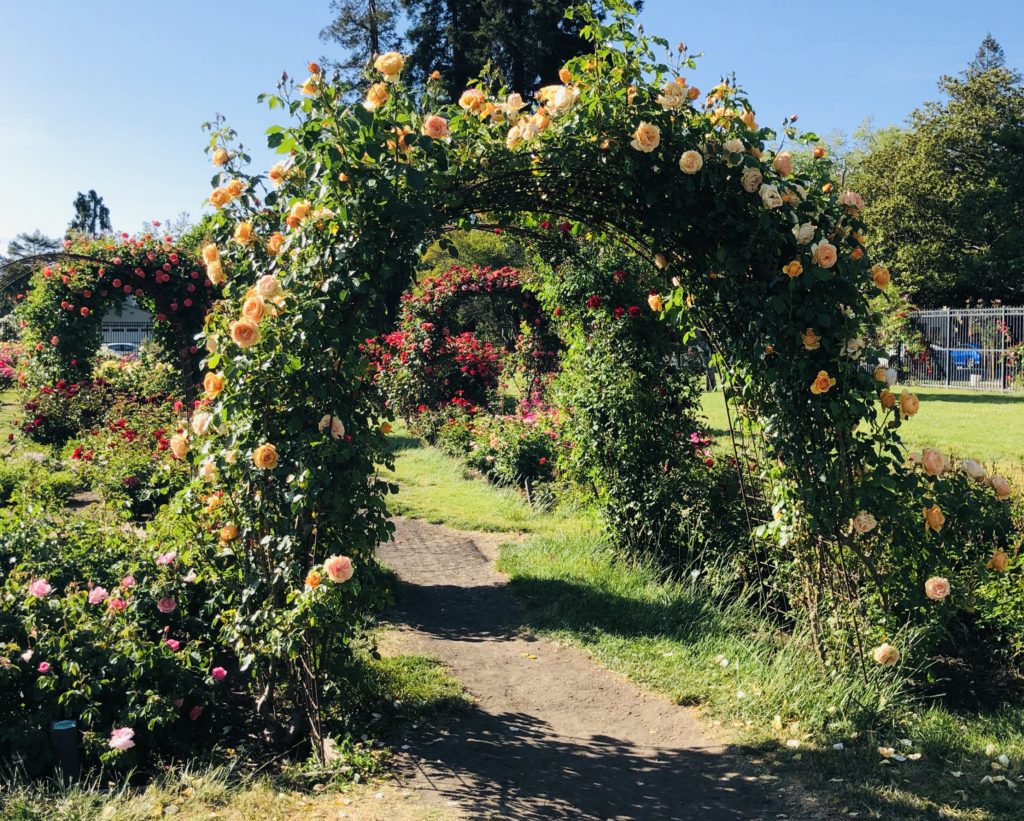 Located at the corner of Naglee & Dana in San Jose, the garden is housed on 5.5 acres. Beginning in April, thousands of colorful roses begin to bloom, creating a vivid and stunning kaleidoscope of color and scent. The garden is home to more than 3500 plantings, and contains over 189 varieties of roses.
Located at the corner of Naglee & Dana in San Jose, the garden is housed on 5.5 acres. Beginning in April, thousands of colorful roses begin to bloom, creating a vivid and stunning kaleidoscope of color and scent. The garden is home to more than 3500 plantings, and contains over 189 varieties of roses.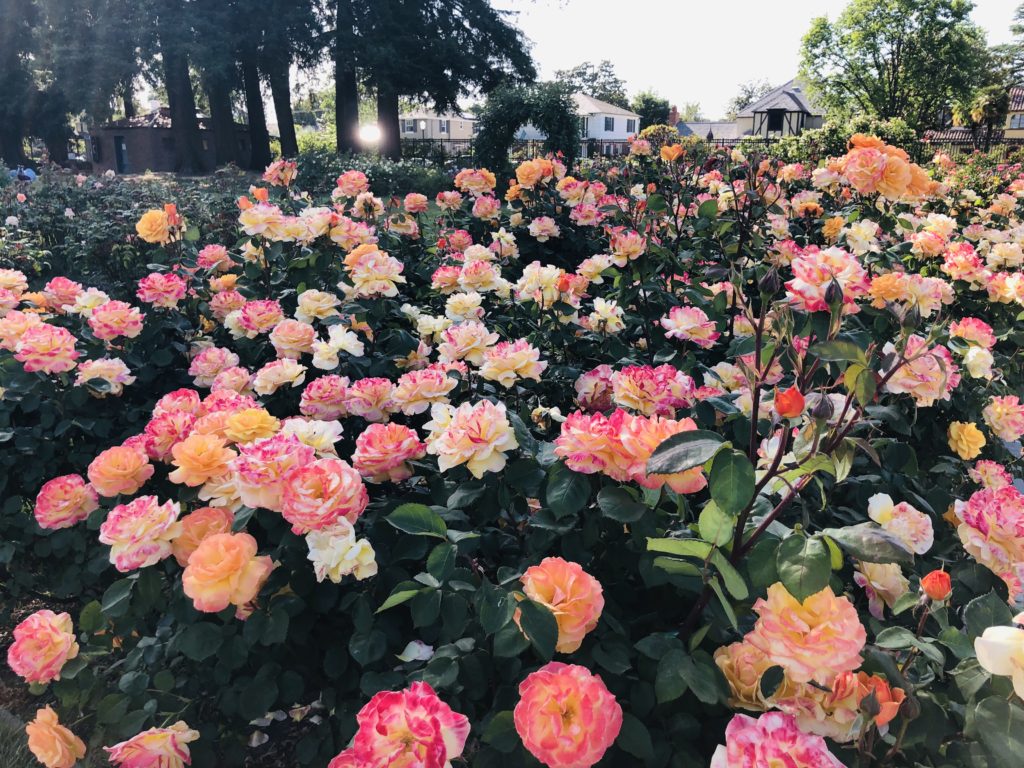
A sense of peacefulness overwhelmed me when I entered this oasis. The hustle and bustle of the city seemed to melt away, like ice in the warmth of the sun. It seemed as though time stood still.
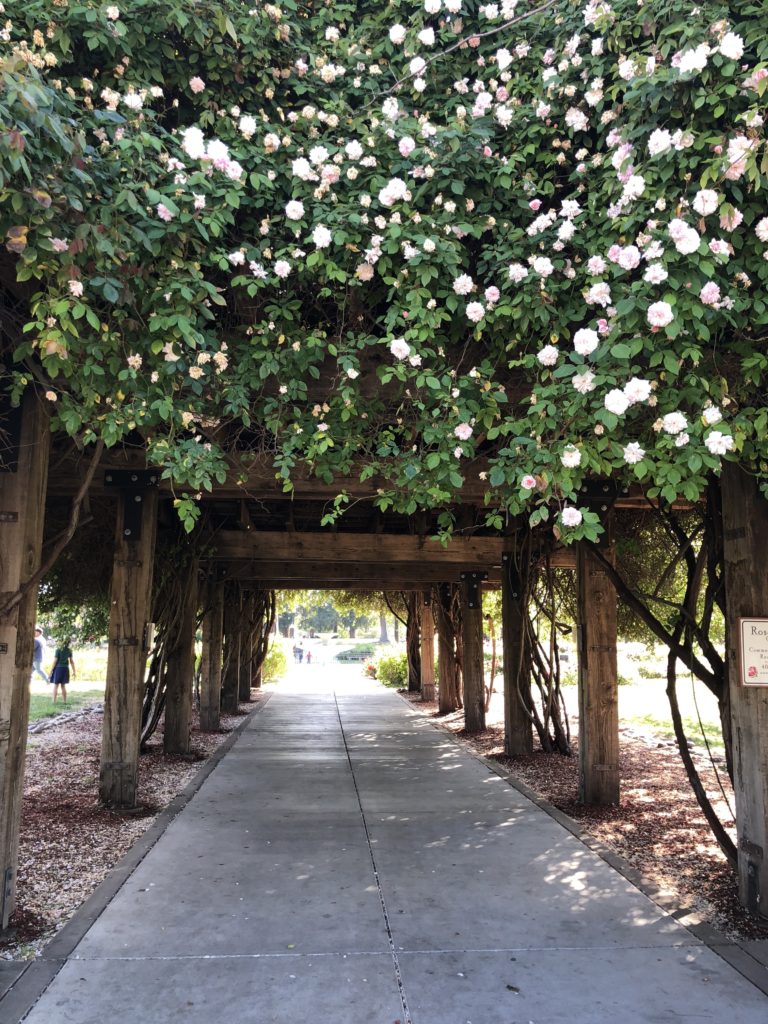 There are many pathways to explore throughout the rose garden. Each path leads to new landscapes of color and delight.
There are many pathways to explore throughout the rose garden. Each path leads to new landscapes of color and delight.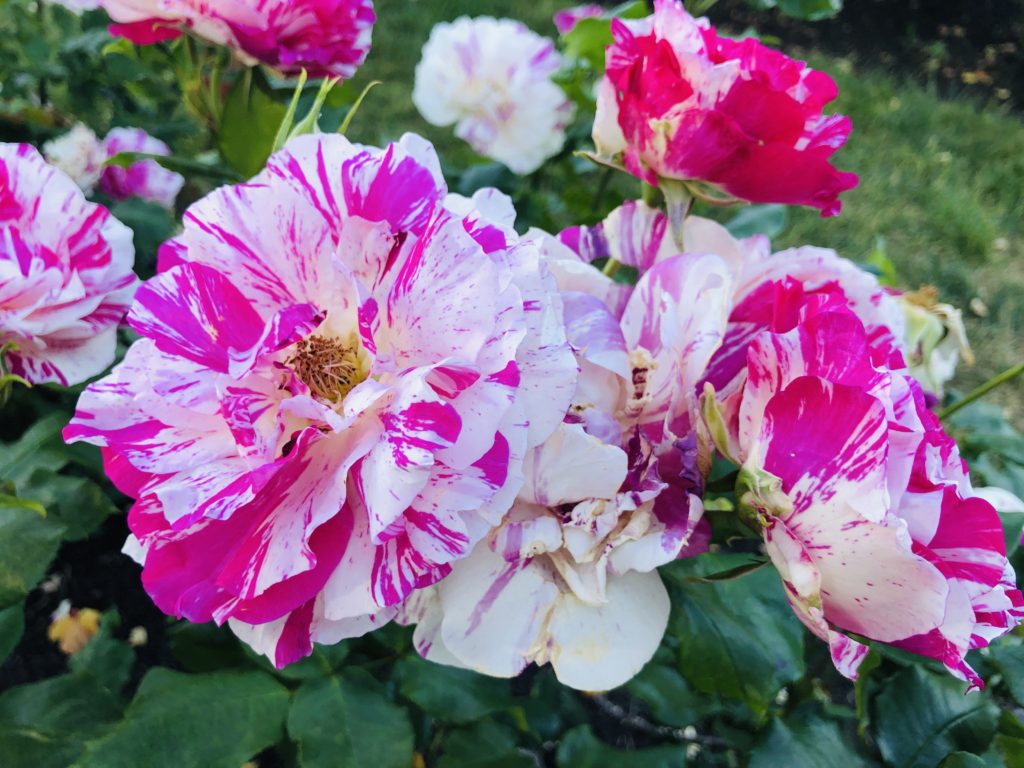
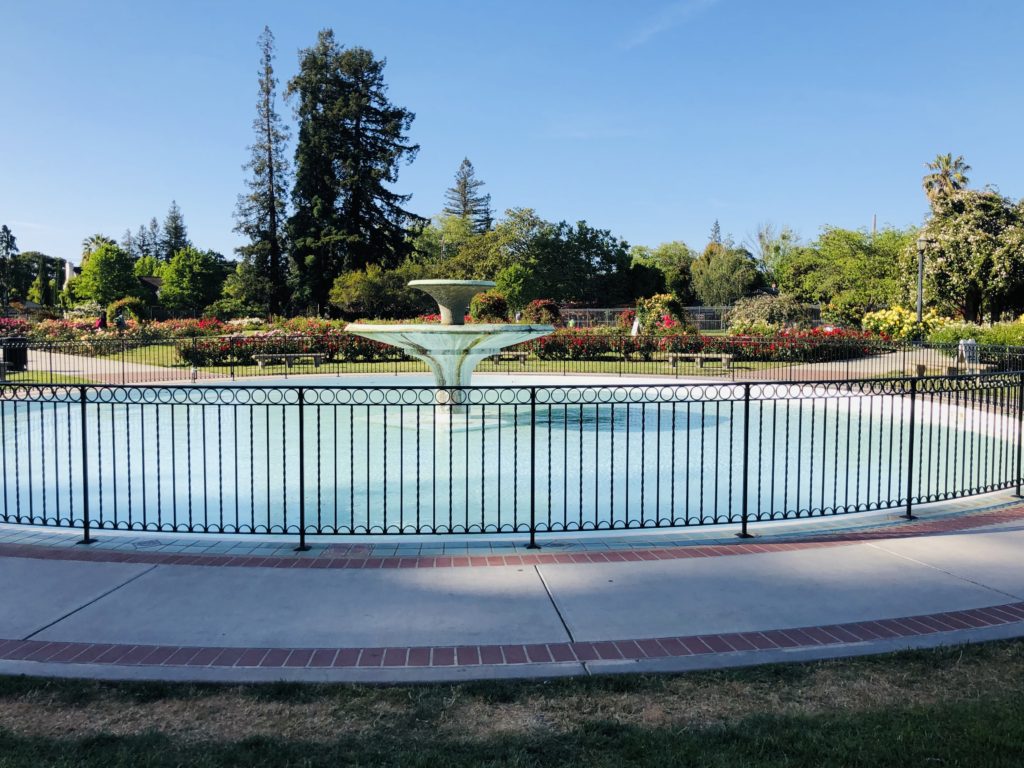
In the center of the garden is a huge pool with a two-tiered fountain, called the “reflection pool”. It is surrounded by benches where you can indeed sit and reflect upon the beauty around you.
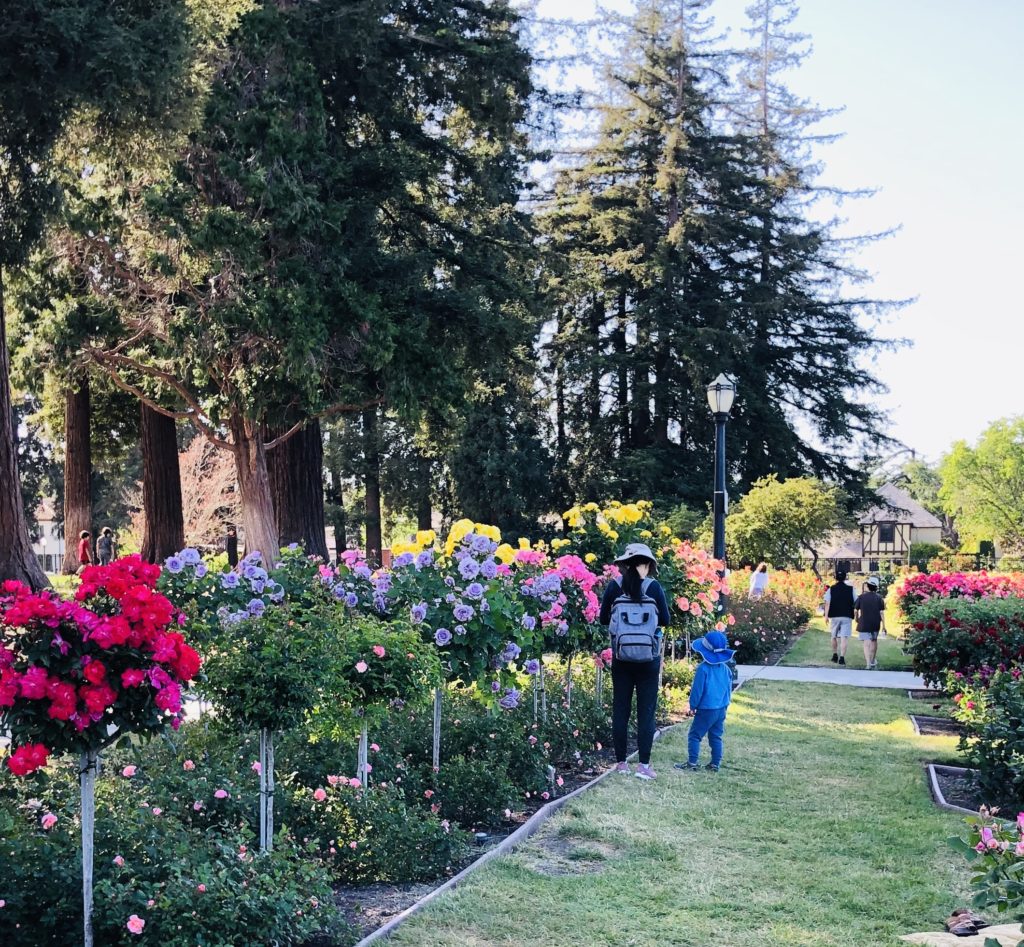 The Municipal Rose Garden was once home to a prune orchard. In 1927, the Santa Clara County Rose Society voted to create a rose garden. Groundbreaking for the new rose garden took place in 1931, in 1937 it was offically dedicated, and today is a historic landmark.
The Municipal Rose Garden was once home to a prune orchard. In 1927, the Santa Clara County Rose Society voted to create a rose garden. Groundbreaking for the new rose garden took place in 1931, in 1937 it was offically dedicated, and today is a historic landmark.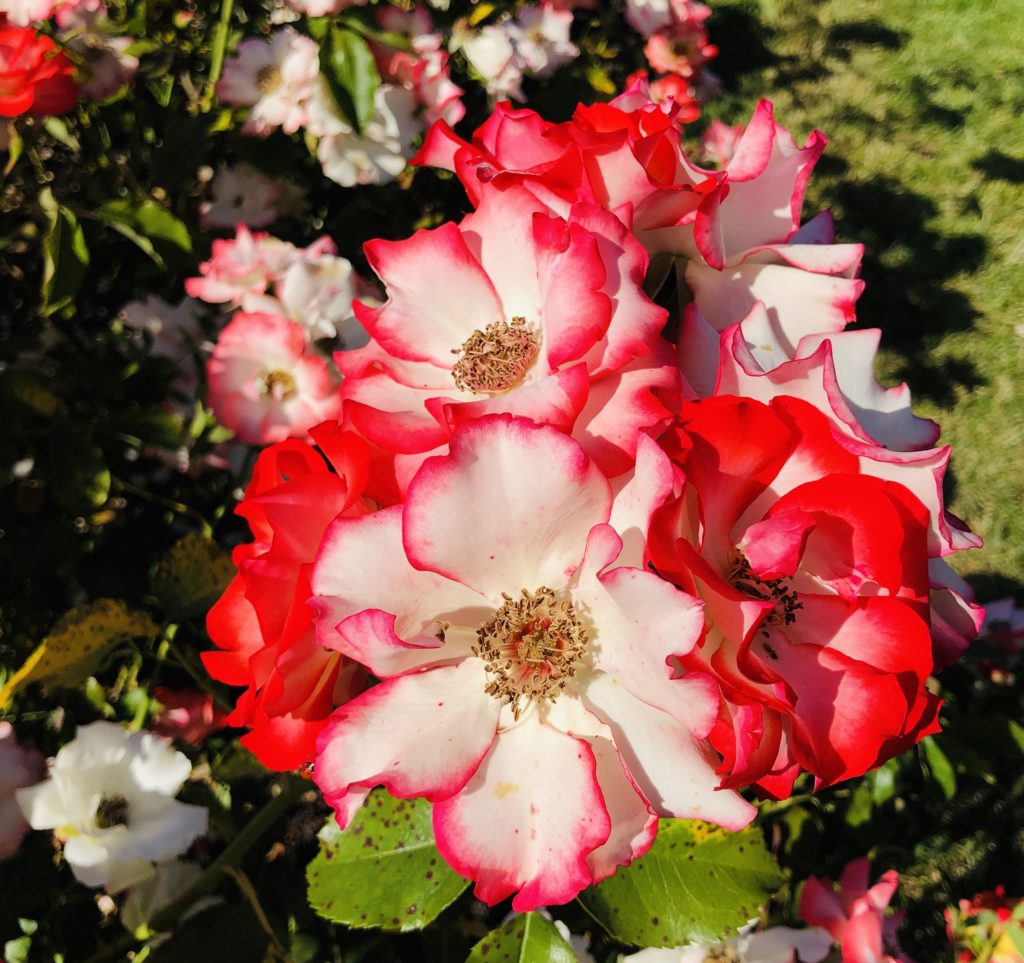
You can enjoy the colorful blooms here from April through November, although the optimal time to visit is in May.
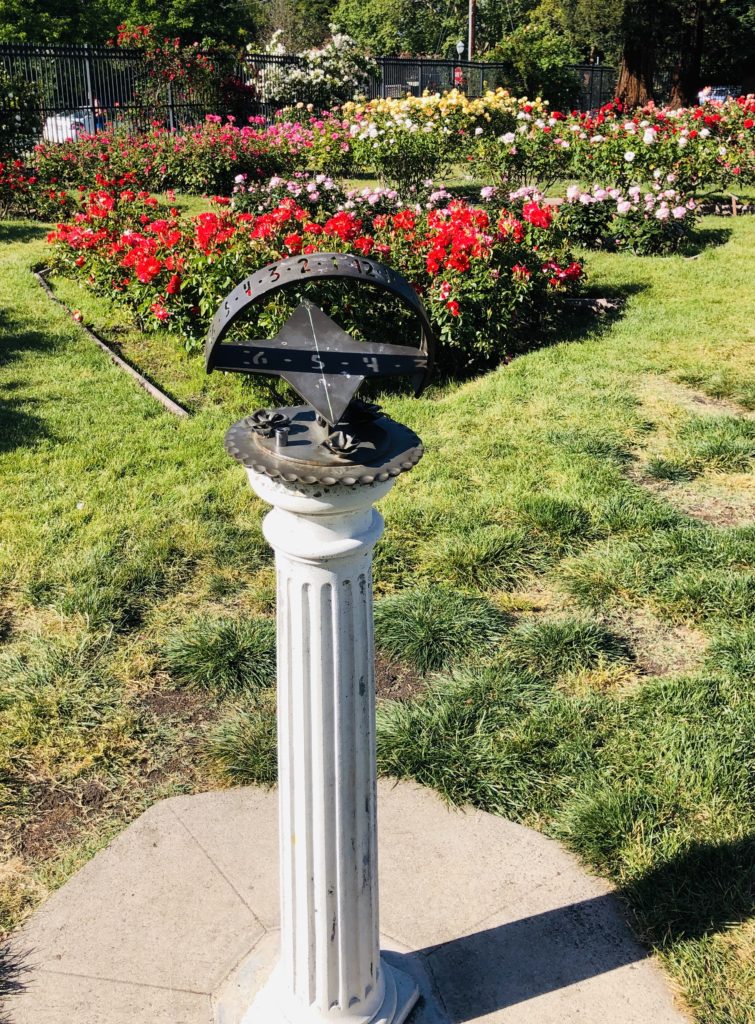
Did you know that the Rose Garden is also home to brand new, unseen before rose varieties? It is one of only a handful of gardens chosen by the All-American Rose Selections to test new roses before they are available to you and me. In 2010, it was awarded “America’s Best Rose Garden”, beating out more than 130 other public rose gardens in the first nationwide competition of its kind. It is no surprise that it has also been voted the best location to get married. Who wouldn’t want their nuptials held in such a romantic and beautiful place?
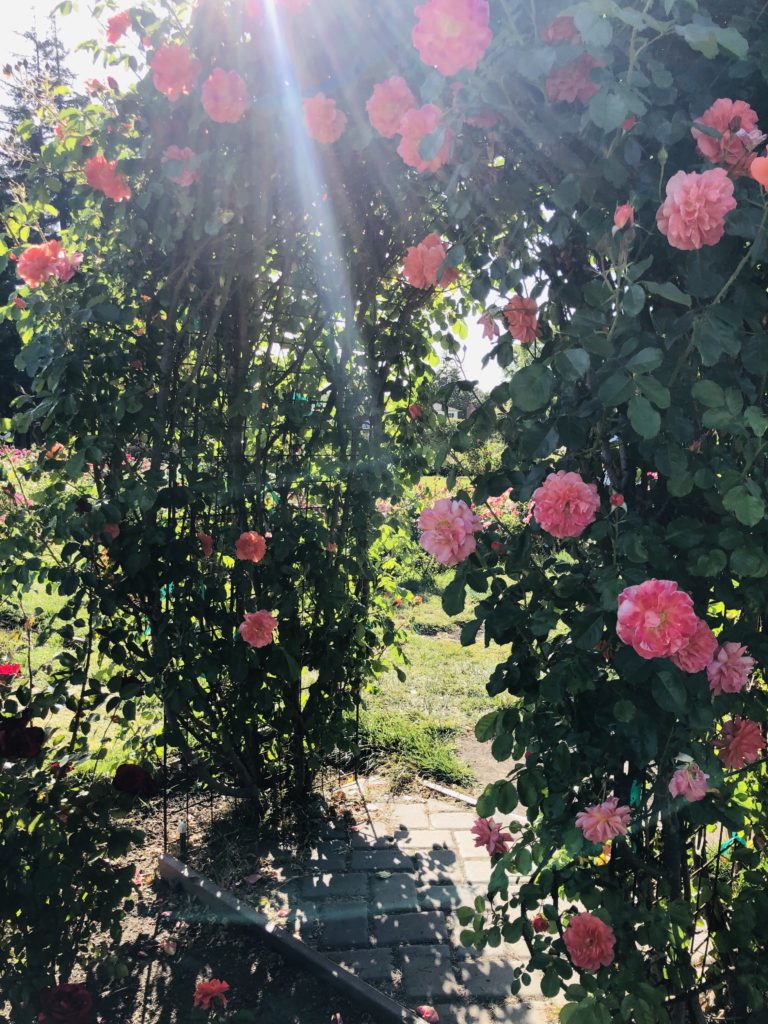
I love the names of some of the roses, including “Betty Boop”, “Angel Face”, “Alchymist”, and “San Jose Sunshine”!
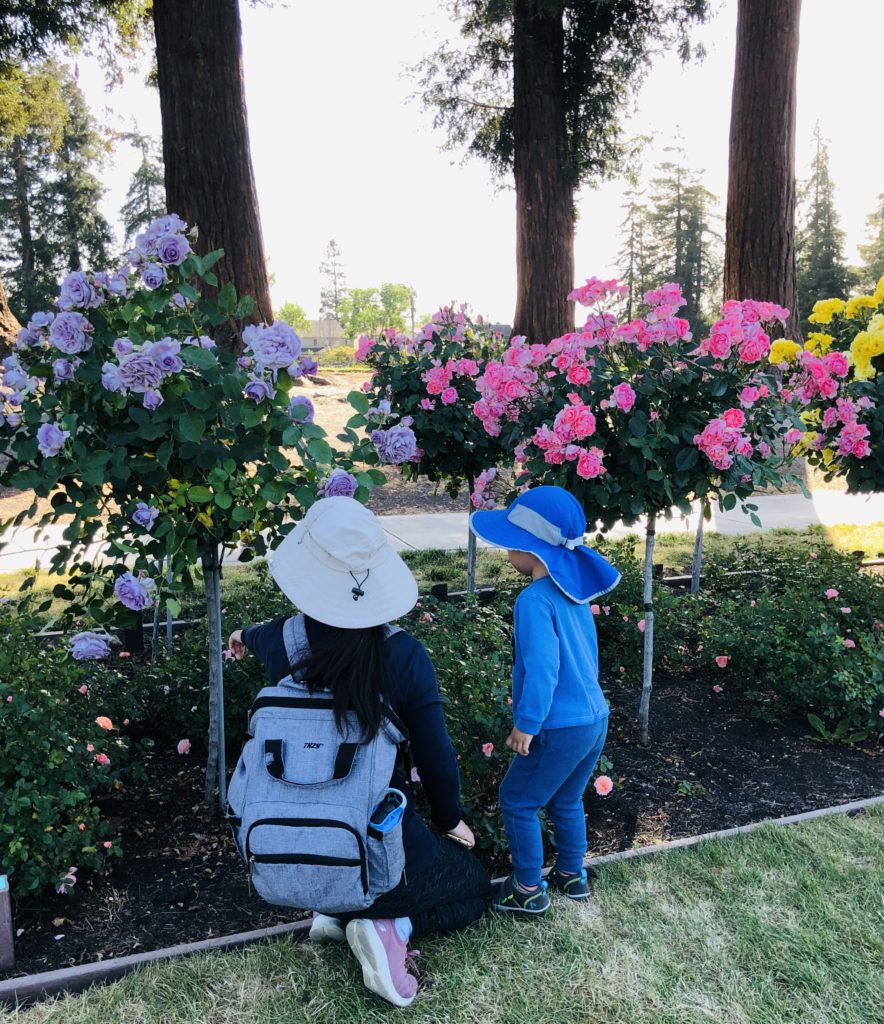
The Garden is filled with lush, grassy areas, and at the edge is shaded by majestic redwood trees. You are sure to find the perfect spot to relax. Bring a picnic lunch or a book and enjoy the serenity!
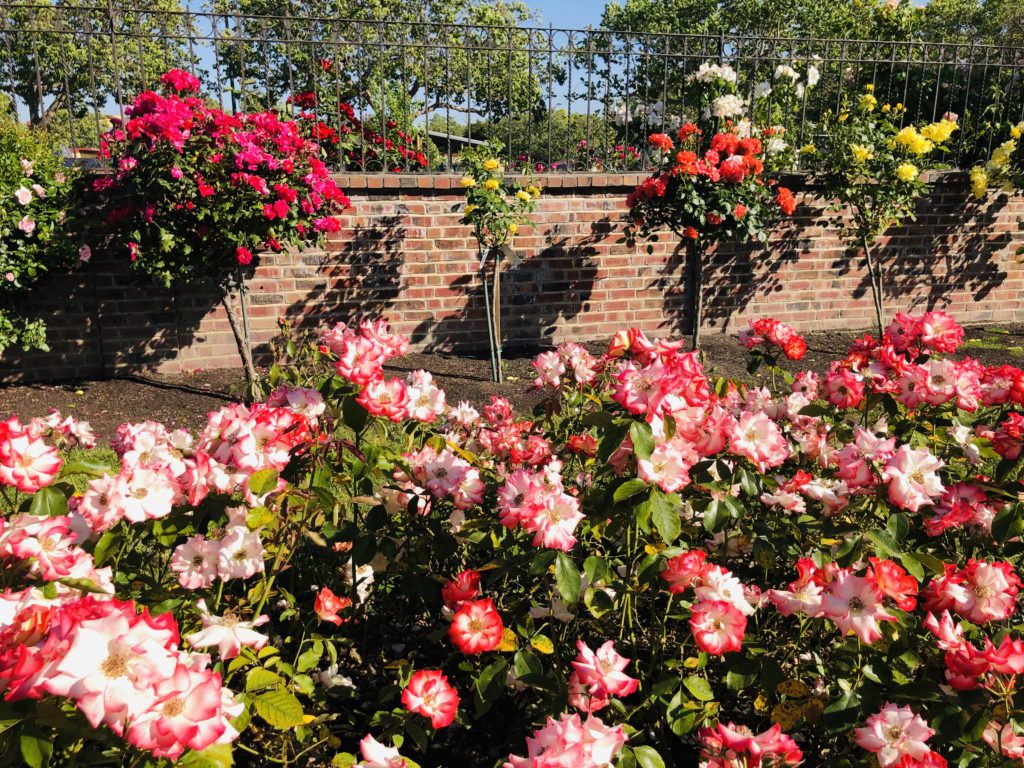 Hours: 8 am to 8 pm daily.
Hours: 8 am to 8 pm daily.Admission: Free.
Location: Dana Avenue & Naglee Avenue, San Jose, California, 95126
Website: Municipal Rose Garden
Thank you for visiting my blog. Wishing you peace, love, happiness & beautiful vistas!
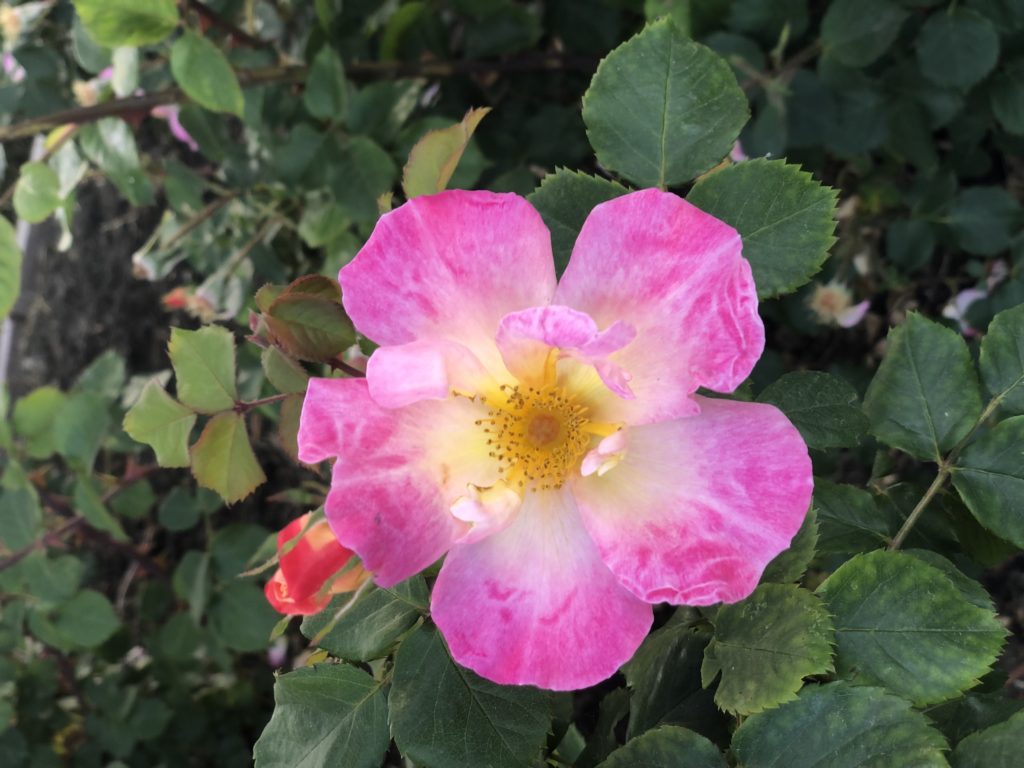
-
The Secret Gardens of Historic Monterey

Often hidden behind a wall or a gate, secret gardens denote mystery, privacy, and solitude. Secret gardens offer solace; a place to sit or walk and contemplate. They give you permission to be inspired, to dream, and to be at peace.

My own garden has its secrets: I love to share them with friends who come to enjoy the peaceful solitude of my farm. The roses that defy being eaten by deer, puzzling my neighbors. The “April in Paris” sweet peas that have self-sown and freely proliferate. The mesmerizing scent of the white, star-flowered jasmine that grows just outside my bedroom, perfuming the night air.
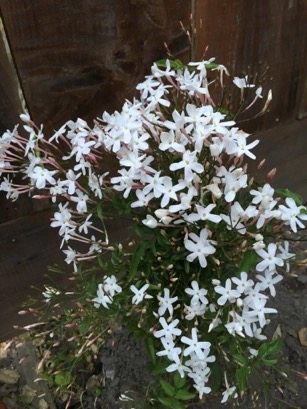
Monterey has some of the most fascinating and delightful secret gardens ever. What makes these gardens so special is that they are located on the grounds of some of the most historic properties in Monterey. The secret gardens here are all completely unique, enticing you with beautiful colors and heavenly scents.
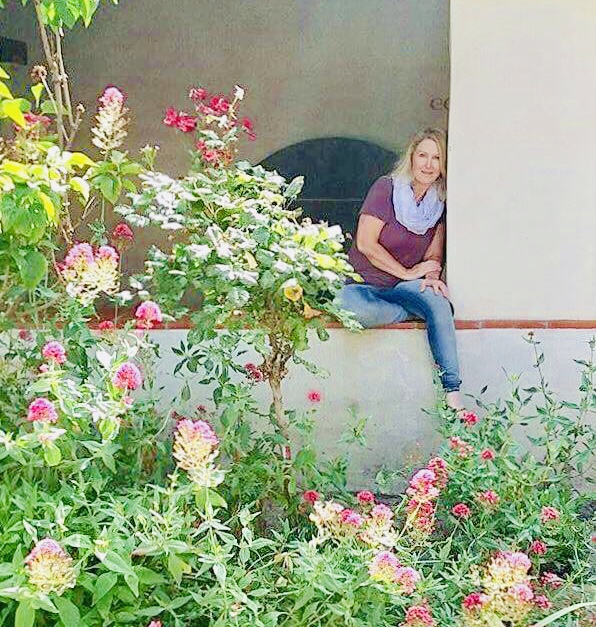
1. The Larkin Garden is located at 510 Calle Principal at the intersection with Jefferson. Thomas Larkin built the two-story mud adobe brick home during Mexican rule of California. An American merchant, he became the only United States Consul to Alta California under Mexican rule.
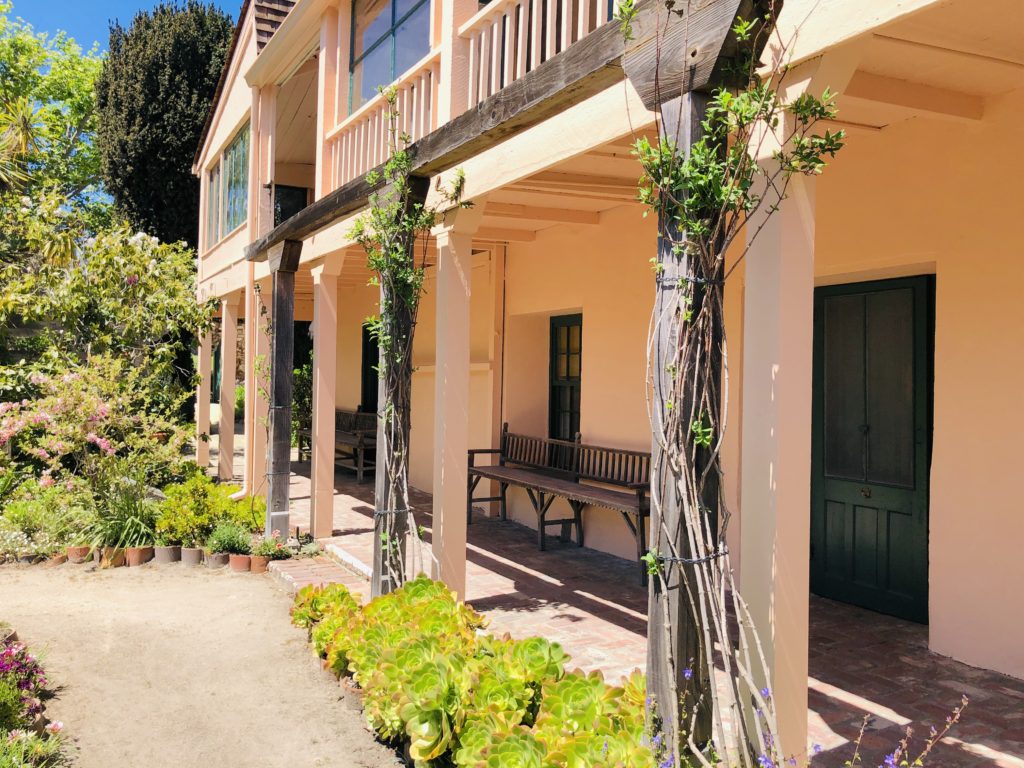
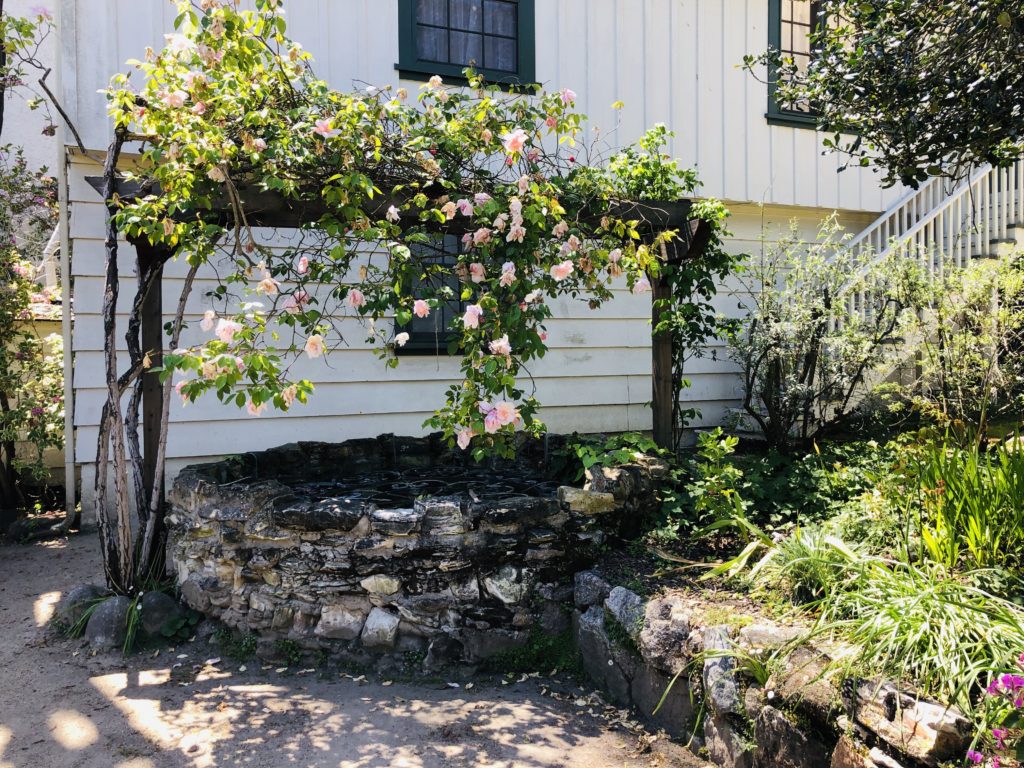
A wishing well covered with climbing roses draws your eye at the Larkin secret garden. 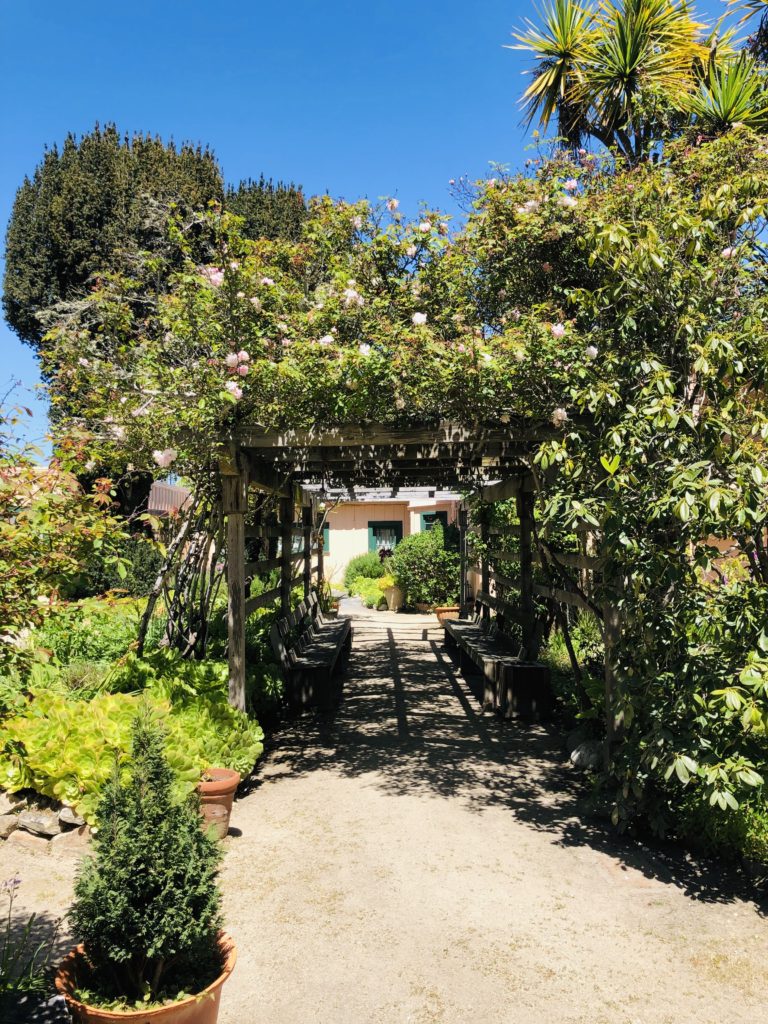
2. The Memory Garden, located at 20 Custom House Plaza in Monterey, was designed by Frederick Law Olmstead, Jr. in 1927. It has an 8-foot high adobe wall and three gates. Inside the garden is a 15-foot diameter fountain surrounded by lovely magnolia trees.
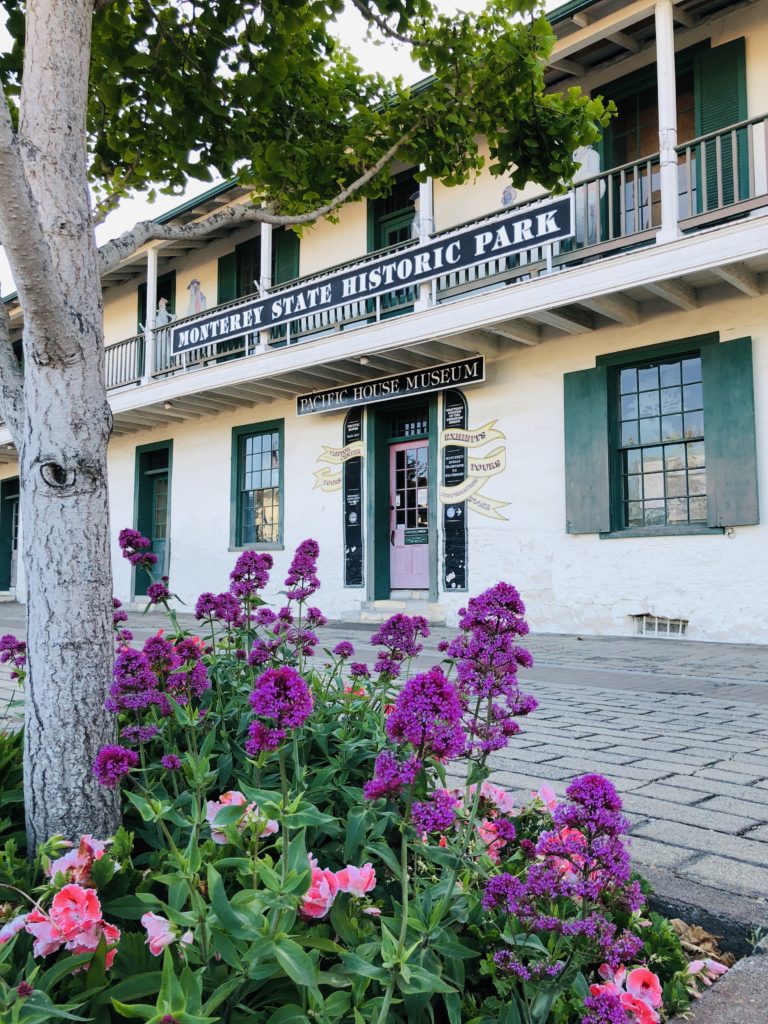
The Memory Garden lies behind the Monterey State Historic Park office and Pacific House Museum. 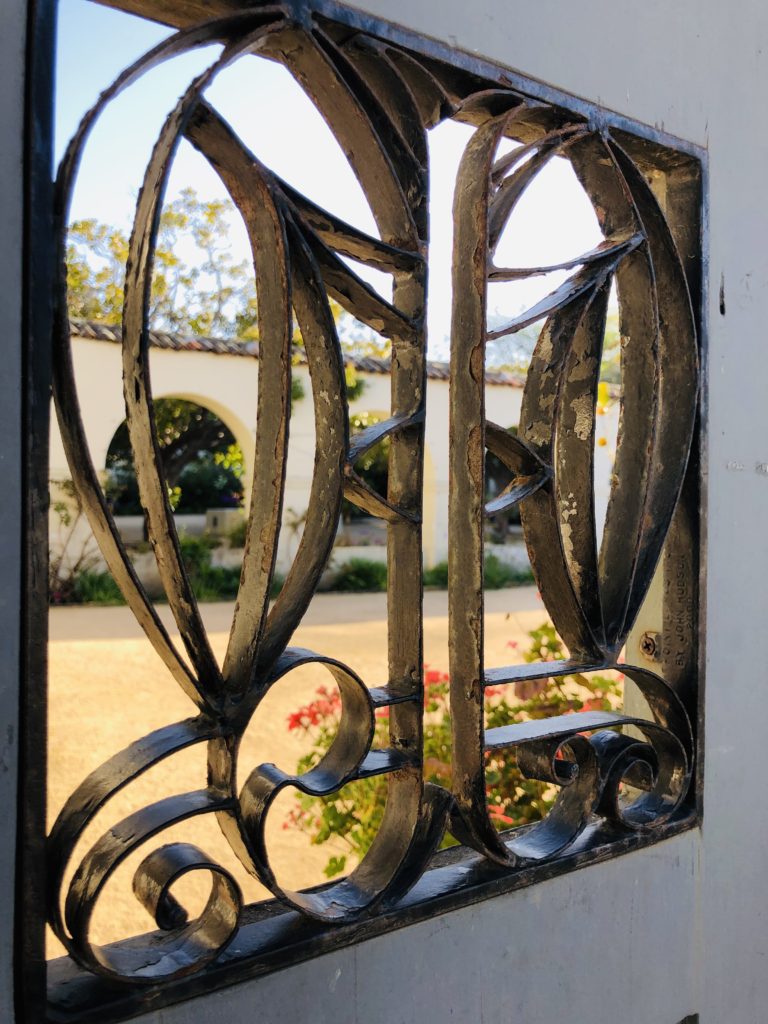
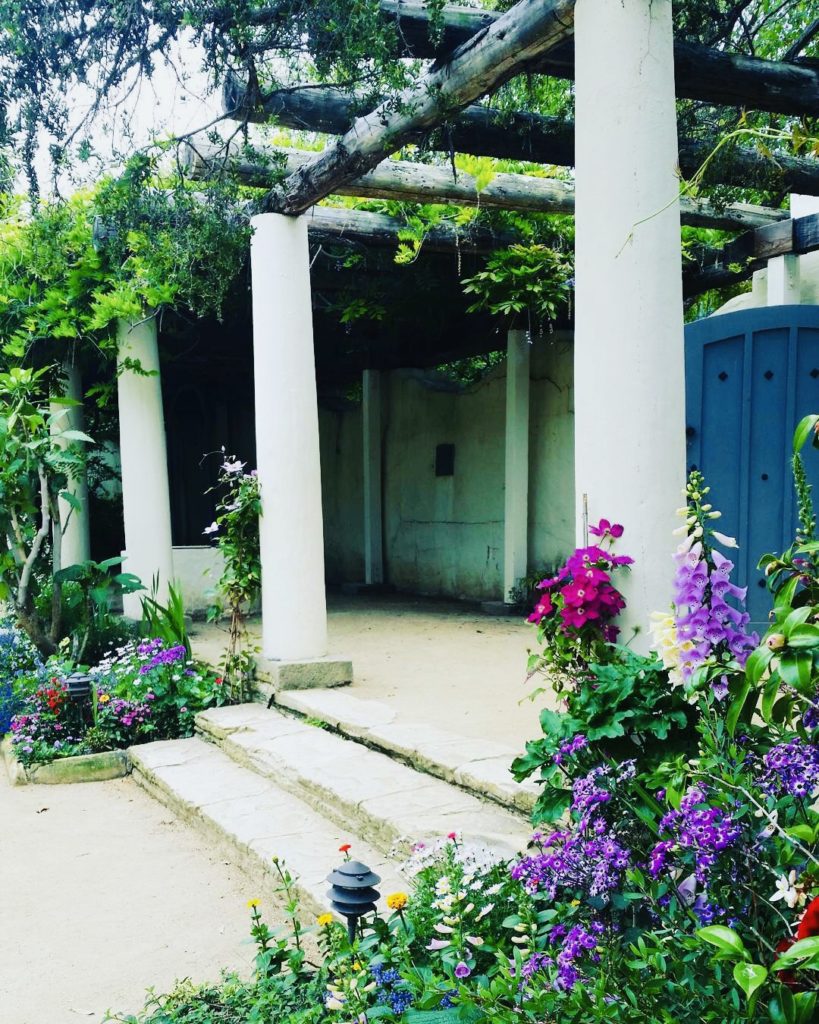
3. The Casa del Oro Garden is at the corner of Pacific and Scott Streets just across from the First Theatre. This is the only garden not enclosed by a wall.

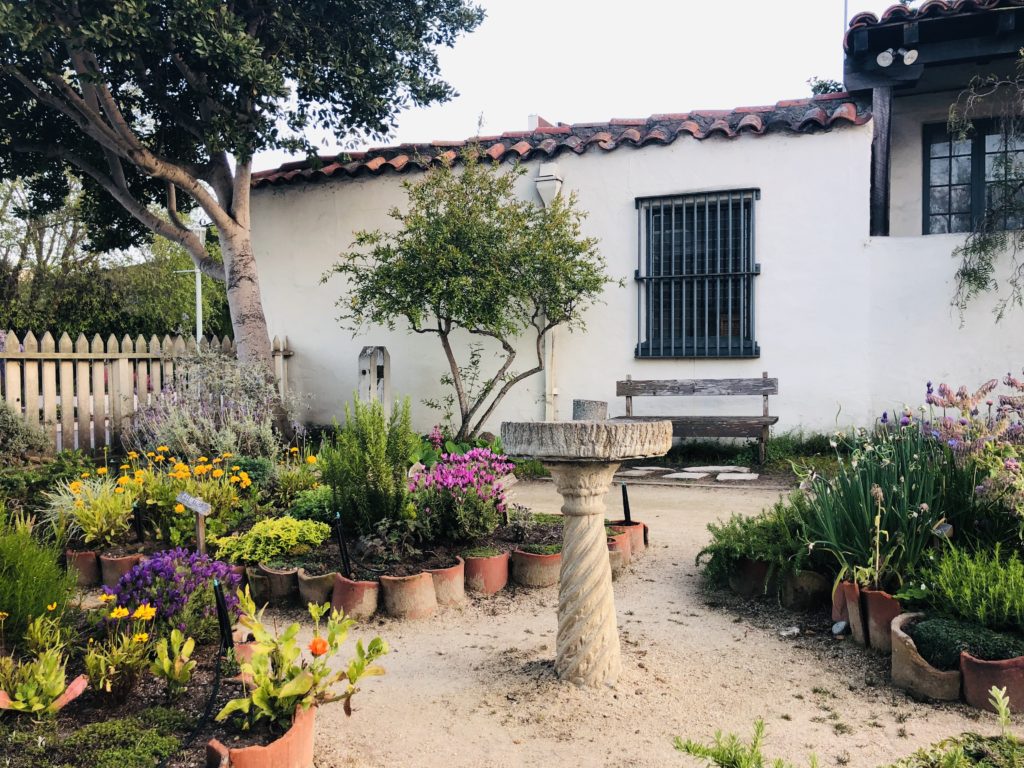
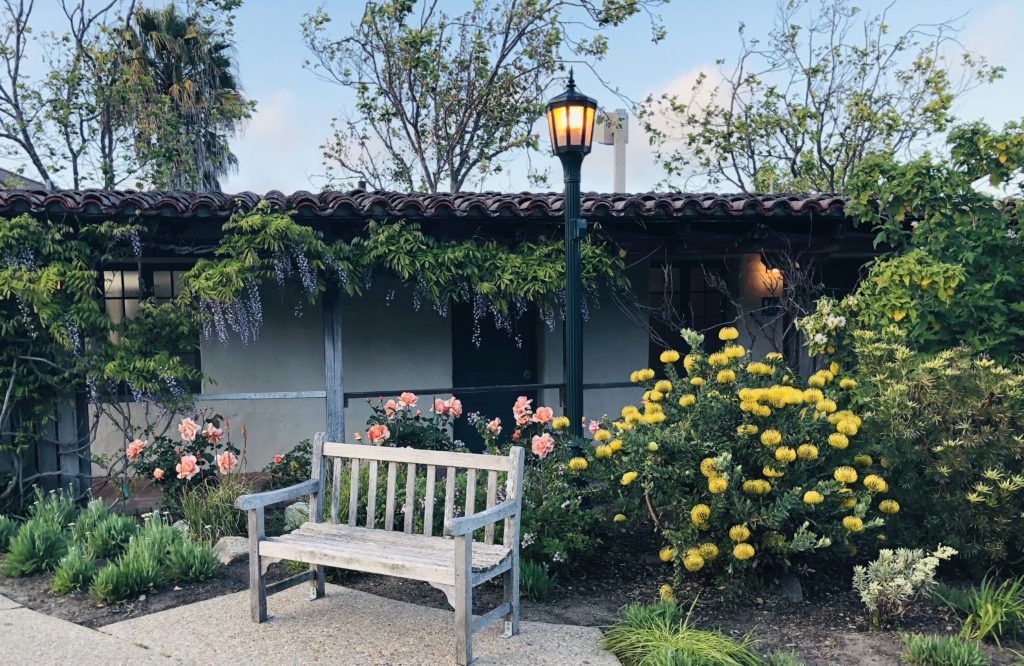
4. The Stevenson Garden is named for the boarding house where Robert Louis Stevenson stayed in 1879 while courting his future wife, Fanny Osbourne. He stayed on the second floor of the French Hotel at 530 Houston Street and worked on essays as well as ideas for future works, including Treasure Island.
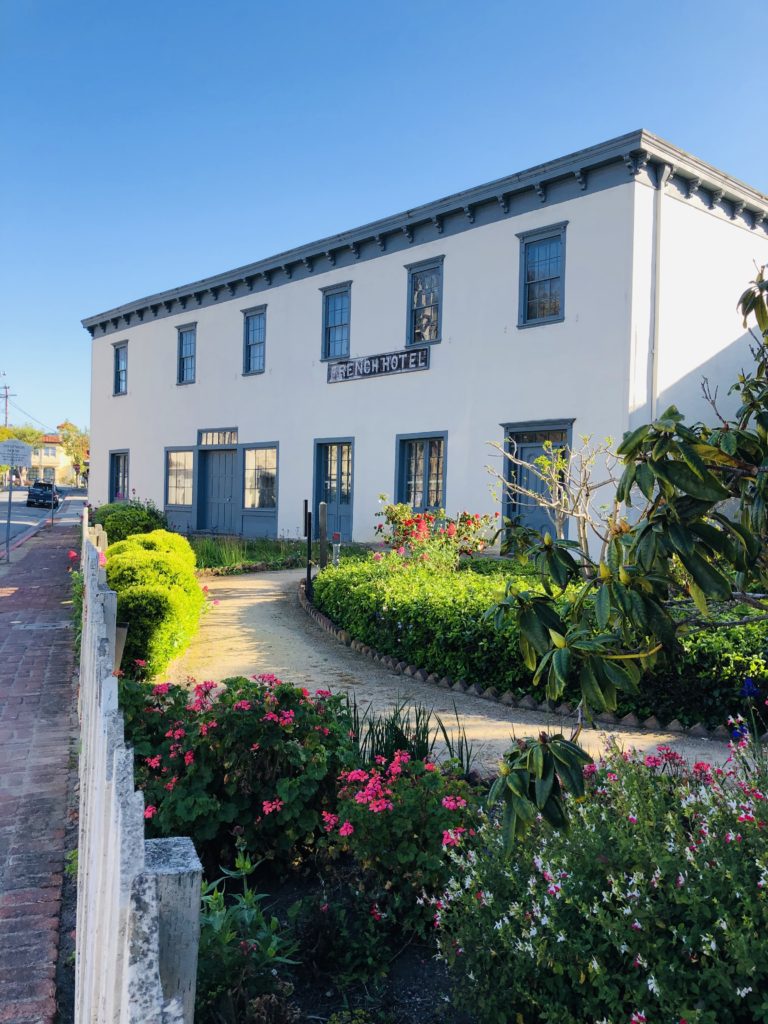
In front, a white picket fence frames a bevy of blooms. Behind the old French Hotel is the secret garden, featuring meandering pathways surrounded by high fencing and featuring an ancient gate at the rear.
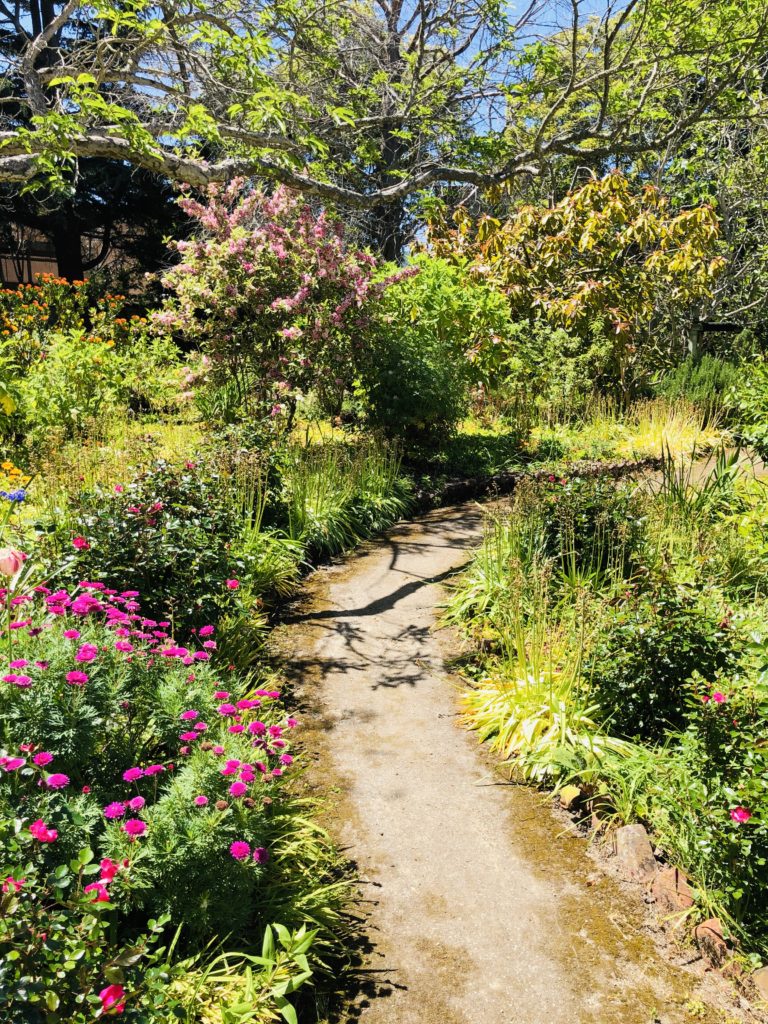
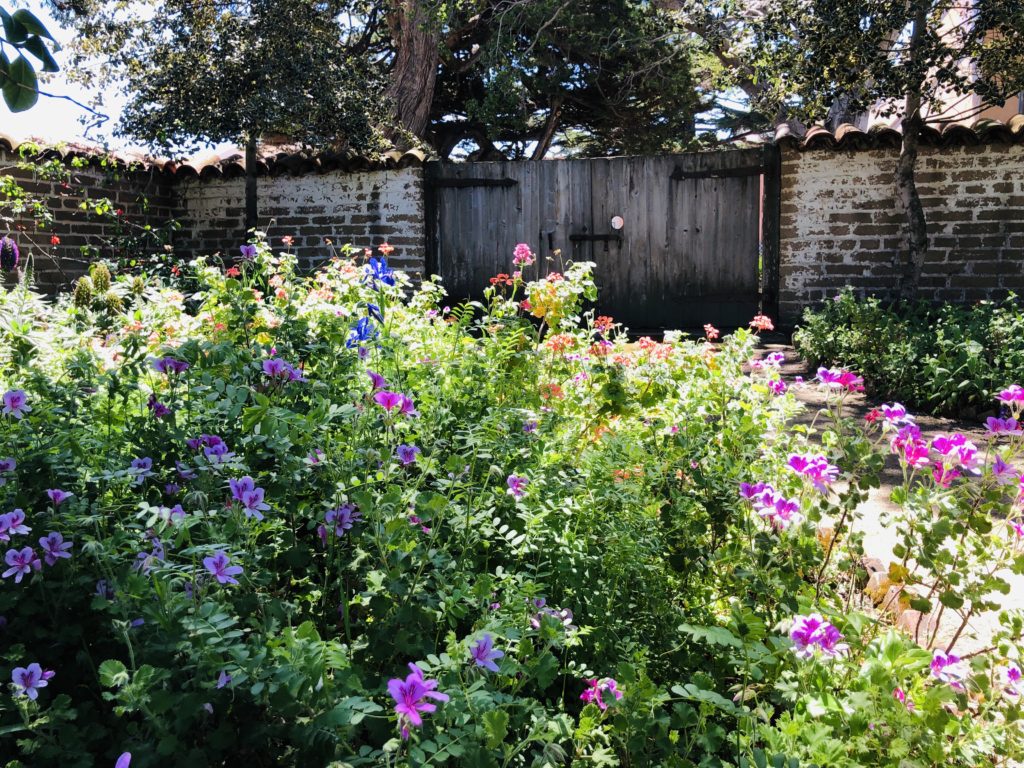
5. The Casa Soberanes Garden, located at the corner of Pacific and Del Monte, features abalone shells and wine bottles as edgings for the flowerbeds in its secret garden.
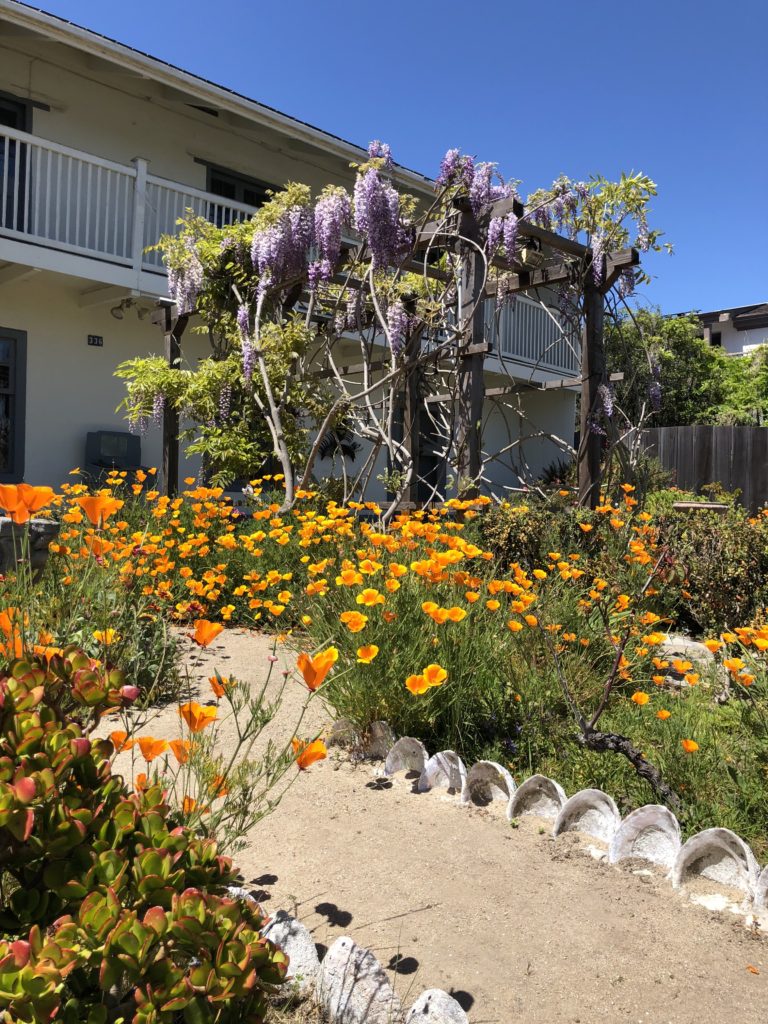

6. The First Theatre Garden is located at the corner of Pacific and Scott Streets. Whale bones frame the entrance of the theatre building, vestiges of Monterey’s whaling history.
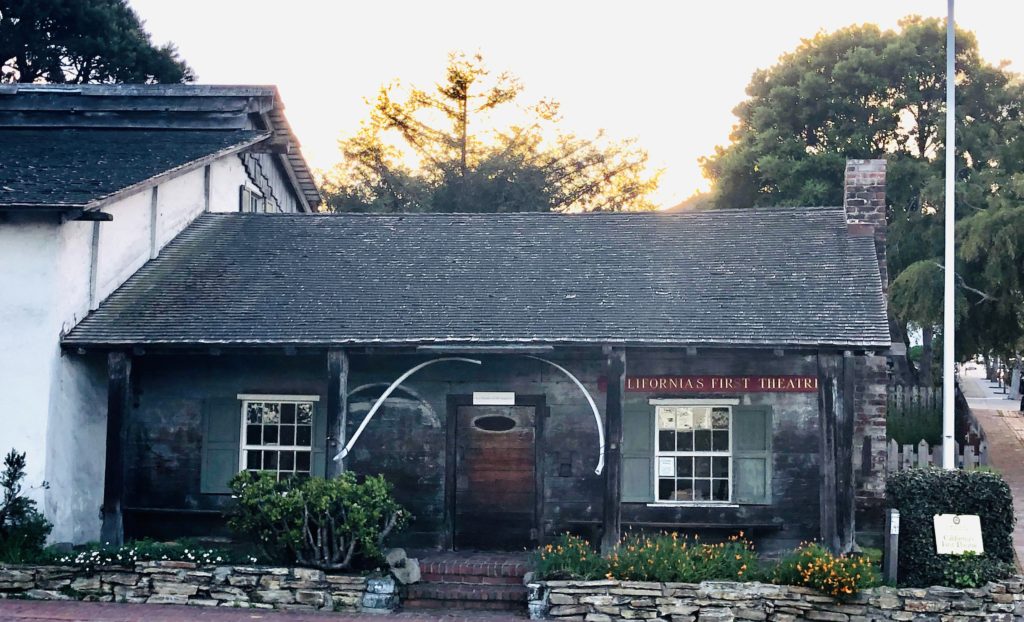
California’s first theater was built in 1847 by Jack Swan for use as a lodging house and tavern for sailors. It became a theatre in 1850. 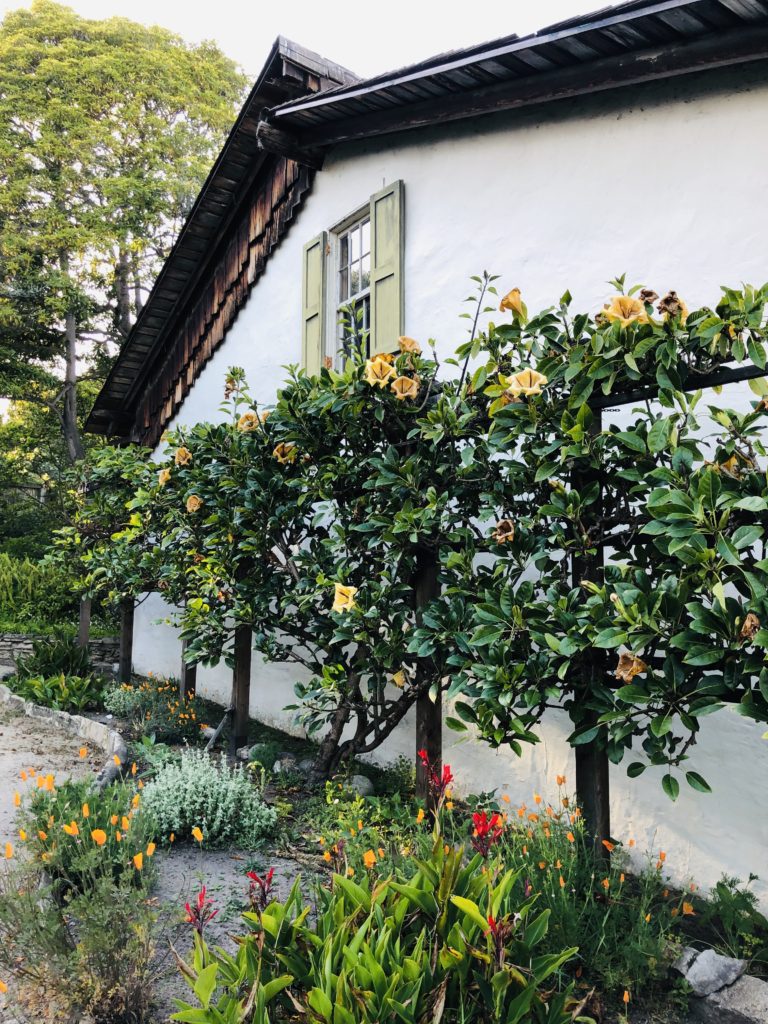
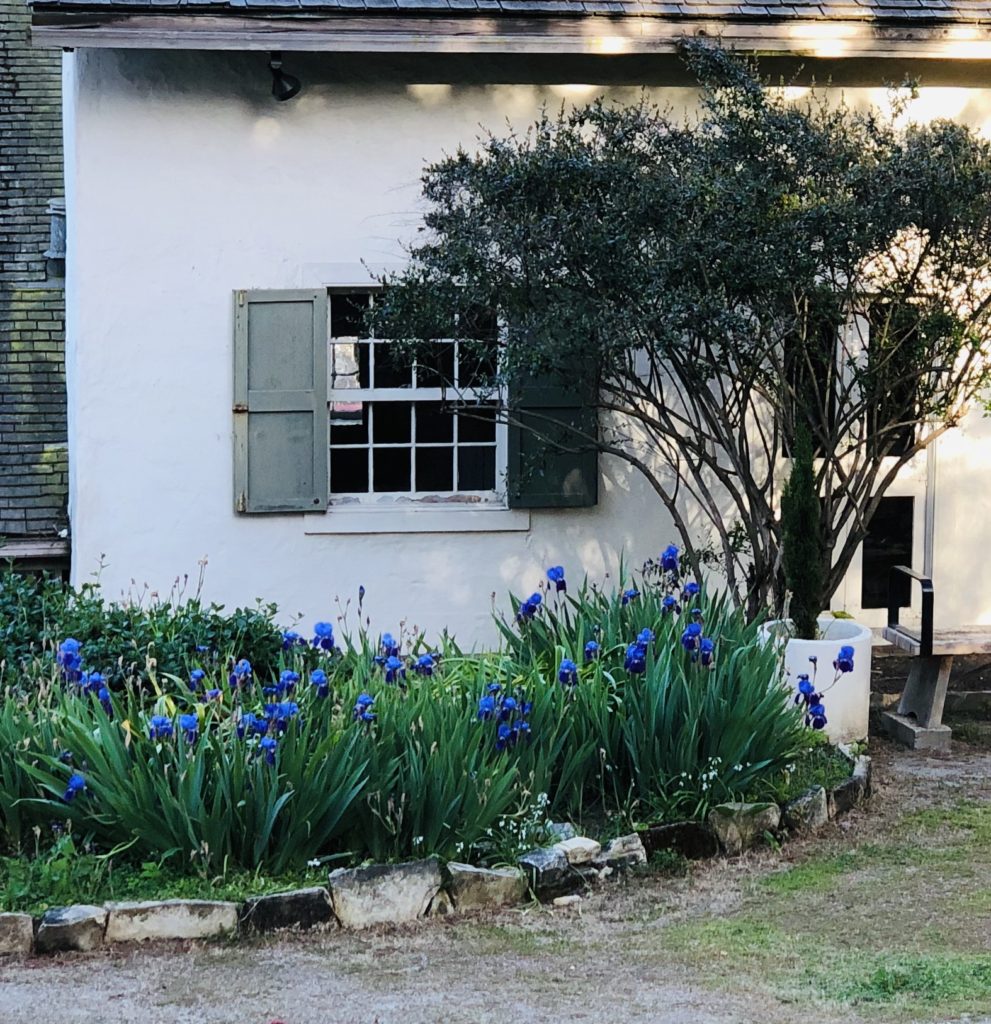
7. Hidden behind a very old wall at the corner of Polk and Munras is the Cooper Molera Adobe secret garden and orchard, Built in 1827, the property is a National Trust Historic Site. What fun to meander among the rustic elegance of the only historic redwood barns within the city limits of Monterey and enjoy the charming and beautiful plants and flowers here.
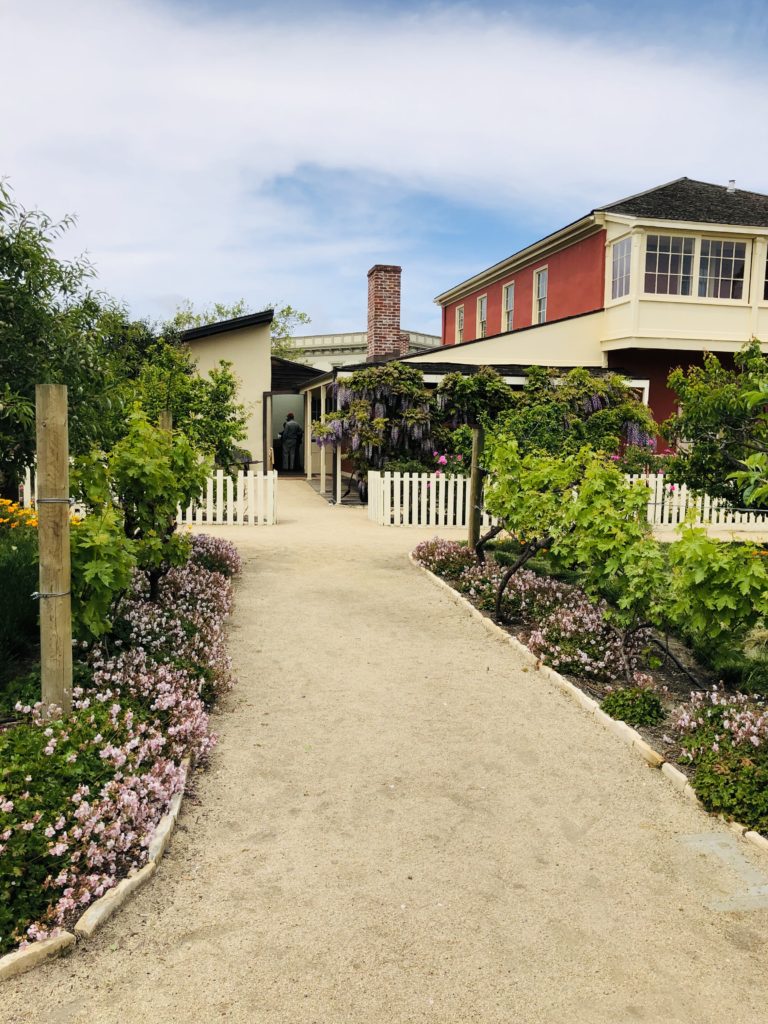

The paths here are wide and easy to navigate throughout the beautiful flowerbeds and the orchard. 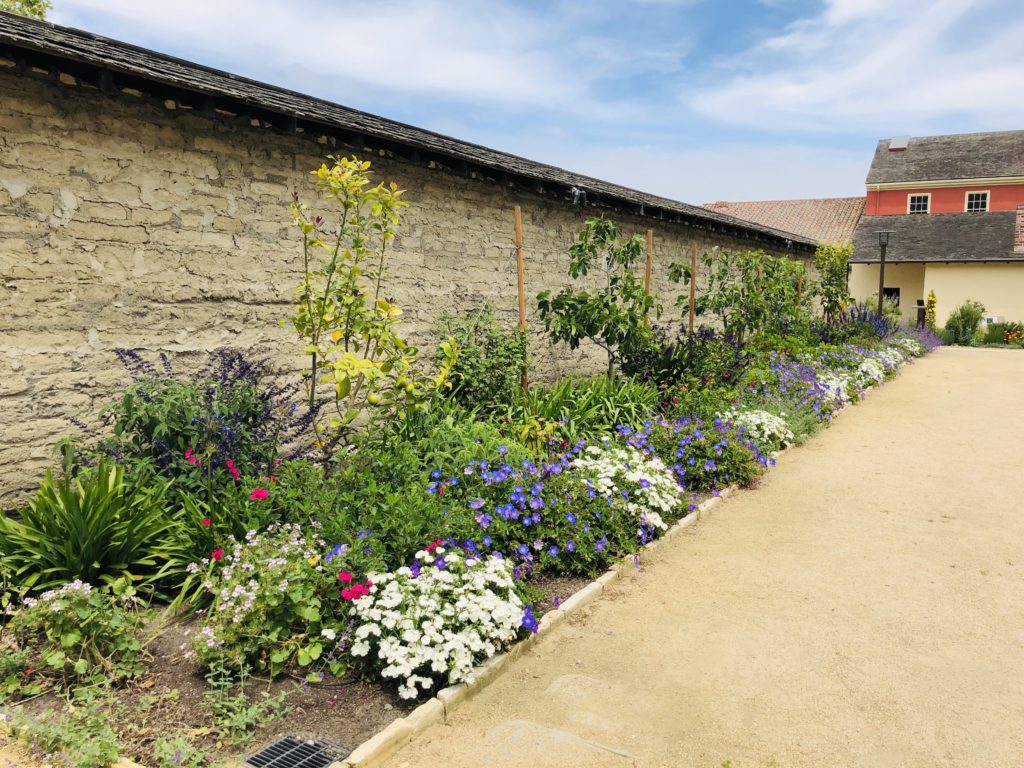
Hours: The Larkin, Memory, Casa del Oro, Stevenson, Casa Soberanes, and First Theatre gardens are open daily from 9 am-4 pm. For more information, see California State Parks. Hours for the Cooper Molera garden are Tuesday through Saturday: 11 am – 4 pm, and Sunday 11 am– 2:30 pm.

I hope you enjoyed this post and are able to visit the secret gardens of Monterey. Thank you for visiting my blog. Wishing you peace, love, happiness, and beautiful vistas!